
My Turkish Odyssey – Don McCullin The tragic fall of Truman Capote – Nicky Haslam 60th anniversary of the Great Train Robbery – Duncan Campbell Larry Grayson at 100 – Christopher Sandford Shut that door! September 2023 | £5.25 £4.13 to subscribers | www.theoldie.co.uk | Issue 430 JE T’AIME – JANE BIRKIN BY SIMON WILLIAMS ‘The Oldie is an incredible magazine – perhaps the best magazine in the world’ Graydon Carter SHOEHORNS MARK PALMER I

Features
Save
See page 31
Brazil nut: Ronnie Biggs page 34

Books
54 Capote’s Women, by Laurence Leamer Nicky Haslam
55 Turning Over the Pebbles, by Mike Brearley Paul Cartledge
57 The Maverick: George Weidenfeld and the Golden Age of Publishing, by Thomas Harding Mark Bostridge
59 Vienna: How the City of Ideas Created the Modern World, by Richard Cockett Benedict King
61 Jane Austen’s Wardrobe, by Hilary Davidson Philippa Stockley
63 The Dangerous Life of Diogenes the Cynic, by Jean-Manuel Roubineau
Thomas W Hodgkinson
Arts
66 Film: The Great Escaper
Harry Mount
Regulars
Editor Harry Mount

Sub-editor Penny Phillips
Art editor Jonathan Anstee
67 Theatre: La Cage
aux Folles William Cook
67 Radio Valerie Grove
68 Television Frances Wilson
69 Music Richard Osborne
70 Golden Oldies
Rachel Johnson
71 Exhibitions Huon Mallalieu

Oldie subscriptions
Pursuits
73 Gardening David Wheeler
73 Kitchen Garden Simon Courtauld
74 Cookery Elisabeth Luard
74 Restaurants James Pembroke
75 Drink Bill Knott
76 Sport Jim White
76 Motoring Alan Judd
78 Digital Life
Matthew Webster
78 Money Matters
Margaret Dibben
81 Bird of the Month:
Yellow wagtail John McEwen
Travel
82 Down Sussex way
William Cook
84 Overlooked Britain: Byron’s dog
Lucinda Lambton
86 On the Road: Tim Rice
Louise Flind
87 Taking a Walk: Holy Abbot’s Wood
Patrick Barkham
Reader Offers
The Oldie literary lunch p35 Reader trip to Copenhagen p79
Advertising
Moray House, 23/31
Great Titchfield Street, London W1W 7PA www.theoldie.co.uk
Supplements editor Jane Mays
Editorial assistant Amelia Milne
Publisher James Pembroke
Patron saints Jeremy Lewis, Barry Cryer
At large Richard Beatty
Our Old Master David Kowitz
To order a print subscription, go to www. subscription.co.uk/oldie/offers, or email theoldie@subscription.co.uk, or call 01858 438791, or write to The Oldie, Tower House, Sovereign Park, Market Harborough LE16 9EF.
Print subscription rates for 12 issues: UK £49.50; Europe/Eire £58; USA/Canada £70; rest of world £69.

To buy a digital subscription for £29.99 or single issue for £2.99, go to the App Store on your tablet/mobile and search for ‘The Oldie’.
For display, contact : Paul Pryde on 020 3859 7095 or Jasper Gibbons on 020 3859 7096
For classified: Monty Martin-Zakheim on 020 3859 7093
News-stand enquiries mark.jones@newstrademarketing.co.uk
Front cover Shutterstock / ITV
The Oldie September 2023 3
Classical drama: Don McCullin page 26
Larry Grayson’s centenary Christopher Sandford 16 World’s best film sets Gareth Neame 18 Women can’t have it all Charlotte Metcalf 20 Douglas Adams fired me John
23 Je t’aime, Jane Birkin Simon Williams 26 My Turkish Odyssey Don McCullin 29 Throw caution to the wind Piers Pottinger 30 Coco Chanel’s eternal style Philippa Stockley 31 I sacked the Queen’s bankers Michael Cole 32 Smoking’s hotter than vaping Richard Howells 34 Life on the run Duncan Campbell 35 Ode to the shoehorn Mark Palmer
14
Lloyd
5 The Old Un’s Notes 9 Gyles Brandreth’s Diary 11 Grumpy Oldie Man Matthew Norman 12 Olden Life Colin Westney 12 Modern Life Richard Godwin
Oldie
Letters A N
History David Horspool 40 Town
Tom
41 Country Mouse Giles Wood 42 Postcards from the Edge Mary Kenny 44 Mary Killen’s Beauty Tips 45 Small World Jem Clarke 47 School Days Sophia Waugh 47 Quite Interesting Things about ... offices John Lloyd 48 God Sister Teresa 48 Memorial Service: Donald Trelford James Hughes-Onslow 49 The Doctor’s Surgery Dr Theodore Dalrymple 50 Readers’ Letters 52 I Once Met Josephine Baker Josephine Masters 52 Memory Lane Marjorie Lund 65 Commonplace Corner 65 Rant: Moronic adverts Stephen Brook 89 Crossword 91 Bridge Andrew Robson 91 Competition Tessa Castro 98 Ask Virginia Ironside
37
Man of
Wilson 38
Mouse
Hodgkinson
ABC circulation figure July-December 2021: 48,249 Subs Emailqueries? co.uksubscription.theoldie@ or 01858phone 438791
subscribe – and get two free
when you
books
Camp sight: Larry Grayson page 14


The Old Un’s Notes
The smoky-voiced actress Glynis Johns, best remembered as the singing suffragette Winifred Banks in the 1964 film Mary Poppins, turns 100 on 5th October.
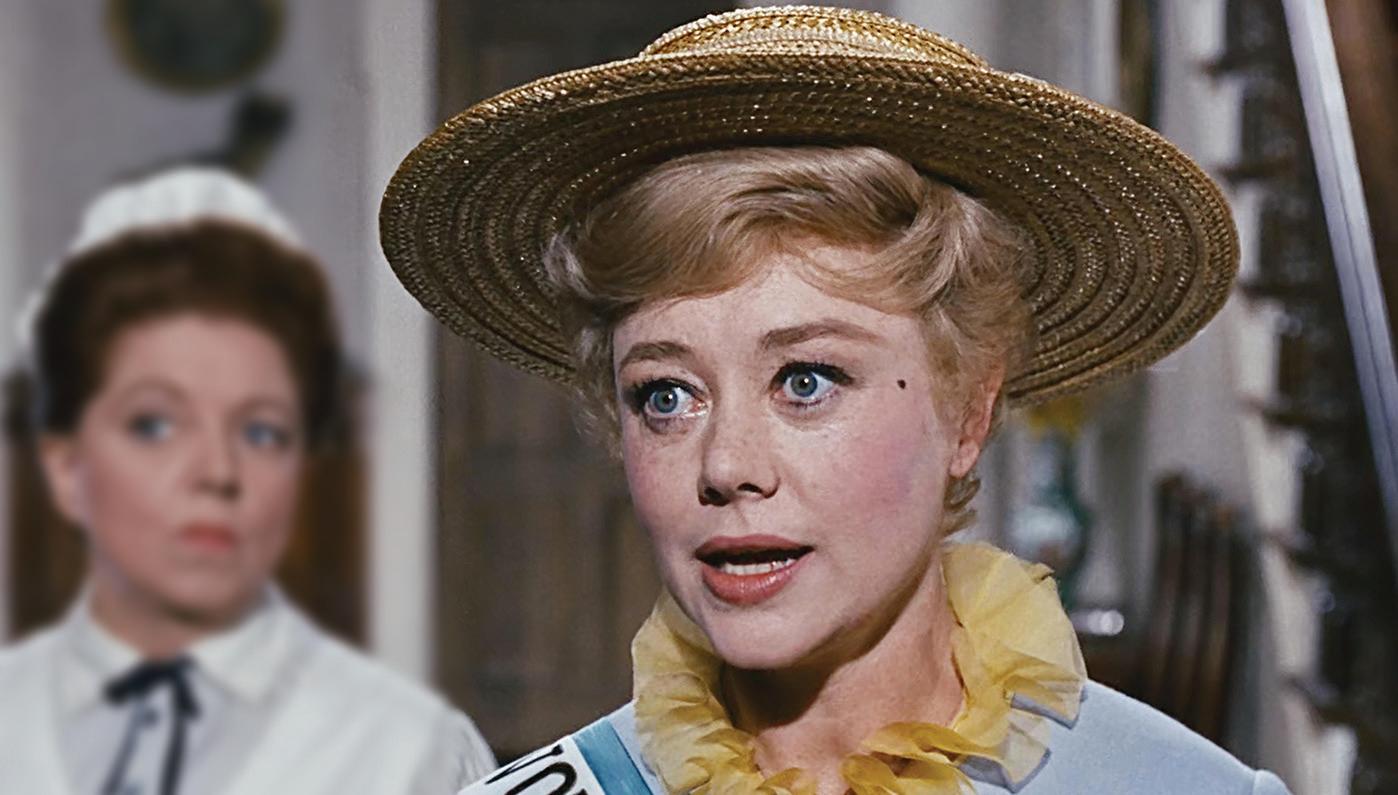
Born in South Africa, where her parents were on a showbusiness tour, Johns came to Britain at the age of five and attended Clifton High School in Bristol while training as a ballerina.
After appearing in the chorus of several West End musicals, she made her big-screen debut alongside Ralph Richardson in 1938 political drama South Riding.
It was the first of 60 films she graced at roughly yearly intervals until her cameo role as a grandmother in the undistinguished American comedy Superstar (1999).
Perhaps it’s due to the proverbial spoonful of sugar, but it’s pleasing to note that many of Mary Poppins’s senior cast members are still with us. The film’s co-stars Julie Andrews and Dick Van Dyke are 87 and 97 respectively, and both are apparently in robust health.
Glynis Johns herself, having outlived all four of her husbands, now lives quietly in a retirement community in Hollywood.
Once a martyr to severe migraines, Johns later said, ‘I finally learned how to relax.

‘And, since I have, the headaches which plagued me for years disappeared. When you let God in on your
problems, you can let go and live.’
Of her four marriages she added, ‘It was absolute conservatism on my part. I was brought up to feel that if you wanted to have an affair
with a man, you married him. I have friends who, if they’d followed that rule, would have collected an awful lot of pieces of paper by now.’
Surely it’s high time we recognised this enduring
Among this month’s contributors
John Lloyd (p20 and p47) wrote The Meaning of Liff with Douglas Adams. He produced The Hitchhiker’s Guide to the Galaxy, Not the Nine O’Clock News, Blackadder, Spitting Image and QI

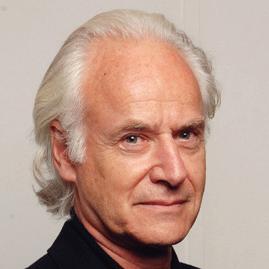
Simon Williams (p23) was James Bellamy in Upstairs, Downstairs. He and his wife Lucy Fleming play her parents, Peter Fleming and Celia Johnson, in Posting Letters to the Moon

Duncan Campbell (p34) was the Guardian’s crime correspondent and LA correspondent. He wrote If It Bleeds, The Paradise Trail, The Underworld and That Was Business, This Is Personal
Nicky Haslam (p54) is an interior designer who performs the songs of his friend Cole Porter. His tea-towel list of common things includes ‘Swimming with dolphins’ and ‘Jiggling your knee’.
British icon with a damehood, in time for her century?
Former Prime Ministers John Major and Tony Blair were at Westminster Abbey for the recent memorial service of Lord Boyce (1943-2022), once the First Sea Lord.

Major collared the Oldie’s Memorial Service correspondent, James Hughes-Onslow, who was instrumental in bringing Major’s brother, Terry Major-Ball, into the spotlight. In 1994, Hughes-Onslow ghosted Major-Ball’s book, Major Major: Memories of an Older Brother

‘You must be something of an expert on this sort of thing, James,’ said Sir John to Hughes-Onslow about his memorial service expertise. ‘We all read you.’
Hughes-Onslow told Major, ‘You look younger every time I see you.’
‘If only that were true,’ said the polite former PM in his charming, selfdeprecating way.
The Oldie September 2023 5
Sister Suffragette: Glynis Johns in Mary Poppins (1964)
Oldie reader: John Major
Important stories you may have missed
Missing vole delays bridge opening

Eastern Daily Press
The obituaries of Bob Kerslake (1955-2023), the former head of the Civil Service, omitted one detail of his time running Sheffield Council two decades ago.
Woman was sent to steal man’s doormat – and nobody knows why Stoke-on-Trent Live
High street takeaway to close for two weeks
Sheerness Times Guardian
£15 for published contributions
NEXT ISSUE
The October issue is on sale on 20th September 2023.
GET THE OLDIE APP
Go to App Store or Google Play Store. Search for Oldie Magazine and then pay for app.
OLDIE BOOKS
The Very Best of The Oldie Cartoons, The Oldie Annual 2023 and other Oldie books are available at: www.theoldie.co.uk/ readers-corner/shop Free p&p.

OLDIE NEWSLETTER
Go to the Oldie website; put your email address in the red SIGN UP box.
HOLIDAY WITH THE OLDIE Go to www.theoldie.co. uk/courses-tours
An art display of large metal spheres was placed in the city’s Millennium Square. In affectionate tribute, they are still known as ‘Bob’s balls’.
Donald Swann, the composer and comedian best known for his At the Drop of a Hat revues with the lyricist Michael Flanders, would have turned 100 on 30th September this year. Having first met while at Westminster School in the 1930s, Flanders and Swann teamed up professionally after the war, in which Swann had registered as a conscientious objector. Their songs were characterised by a keen sense of absurdity, complex rhyming schemes and catchy
choruses. The Hippopotamus Song (‘Mud, mud, glorious mud’) was their most celebrated number. Slow Train was a fine elegy to the stations cut by Dr Beeching.
In 1964, the deeply religious Swann gave a sermon at St Paul’s Cathedral in which he said that only satire could cleanse the soul of the dreariness of ordinary life.
Like many great creative duos, the Flanders-Swann partnership was sometimes strained. Long concert tours – they were a smash in the States – eventually lost their appeal for Swann, who came to feel there were other things he wanted to write besides comical ditties about gnus, gasmen and London buses.

The pair always looked mismatched – the bearded and lugubrious Flanders, wheelchair-bound after a bout of polio, and the bespectacled, slightly fey Swann tinkling the piano.
They broke up the act in 1967 after 11 years together but remained friendly up to the time of Flanders’s death in 1975. In later years, Swann, who was married with two daughters, wrote everything from operas to religious music to a revue co-created with the poet Henry Reed about a fictitious butch composer named Hilda Tablet.
Swann died of cancer in March 1994, at the age of 70.
‘I never met anybody who knew Donald who didn’t like him; his friends positively adored him,’ one of his obituarists wrote – which isn’t a bad epitaph.
A Commons adjournment debate in July, saluting the late Scottish National Party matriarch Winnie Ewing (1929-2023), was opened by fellow SNP member Ian Blackford, possibly Westminster’s most garrulous orator.
Adjournment debates normally last no more than 30 minutes. This one stretched to an hour. Blackford, pausing from anecdotes about Winnie’s fondness for a dram, recalled that she once sent him a video address for his election campaign.
‘It was not short,’ said Blackford.
MPs: ‘Oh, the irony!’
When the debate finally ended, Deputy Speaker Nigel Evans bolted from the chair like a hare. It turned out he had been bursting for the loo from the very start.
6 The Oldie September 2023 KATHRYN LAMB
Have some Madeira, m’dear: Flanders and Swann
‘Don’t worry. He won’t bite’
Annoyed by your snoring husband?
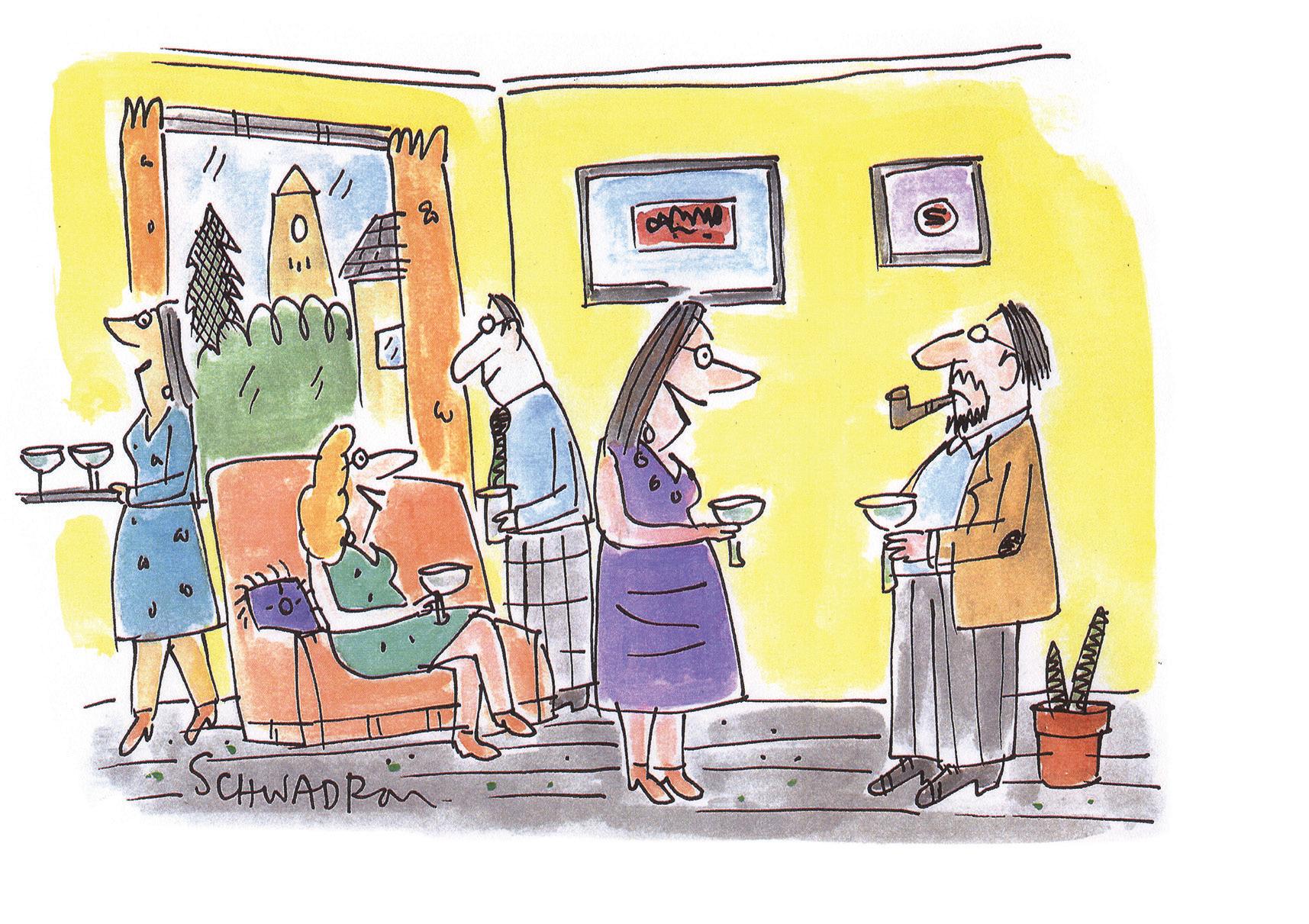
In 1936, Anne Balliol and Ralph Y Hopton wrote Better Bed Manners

Now in a new edition, it includes the chapters Going to Bed under Difficulties and In Bed with a Nice Person.
One chapter, The Seven Great Problems of Marriage, includes insoluble questions. Among them is The Problem of Light
As the authors observe, ‘Science has realised that the one who is trying to sleep is insufferably annoyed by the wide-spreading light of the bedfellow who loves to read.’
And how wise Sir Walter Scott was: ‘Even the kindest people are savage at night.’
Parliamentary reports are normally published at Westminster but the chairman of the Environment Select Committee, Sir Robert Goodwill, launched its report on species-reintroduction with a fancy event at the Great Yorkshire Show.
The whiff of manure, snouts in the trough, chorused moos: a country show is maybe not such a bad place for a political event.
Old-fashioned cigarette smokers might be fast becoming an endangered species now that most people have quit, vape or resist the allure of the demon tobacco.
But England’s greatest living playwright, Sir Tom Stoppard, 86, was defiantly puffing away on an outdoor terrace at the National Theatre during the interval of a recent performance of Dear England

‘Old habits obviously die hard,’ chuckled a fellow theatregoer wryly.
The acclaimed new James Graham play stars Joseph
Fiennes as England football manager Gareth Southgate; Stoppard wrote the screenplay for the hit 1998 film Shakespeare in Love, in which Fiennes played the Bard.
Needless to say, Sir Tom looked very stylish as he puffed on his gasper – so much cooler than vapes, as Richard Howells writes on page 32.
Civic transport planners claim lower speed limits are good for the planet, but it may only be a theory.
For two years, Labour’s
‘Your poor wife has told me so much about you’
Lord Campbell-Savours has been asking the Department for Transport to provide evidence that vehicles travelling at 20mph emit less carbon monoxide than those trundling along at 30mph.
In 2021, he was told ‘the department does not have specific results’.
He recently tried again during House of Lords questions. No dice.
Lady Vere, a transport minister, said it was ‘up to local authorities to decide on local speed restrictions’. Are eco-claims about 20mph zones mere hot air?
The Oldie September 2023 7 STEPHEN BISGROVE / ALAMY
Smoking jacket: Sir Tom Stoppard
‘It’s
full of type ‘O’s!’
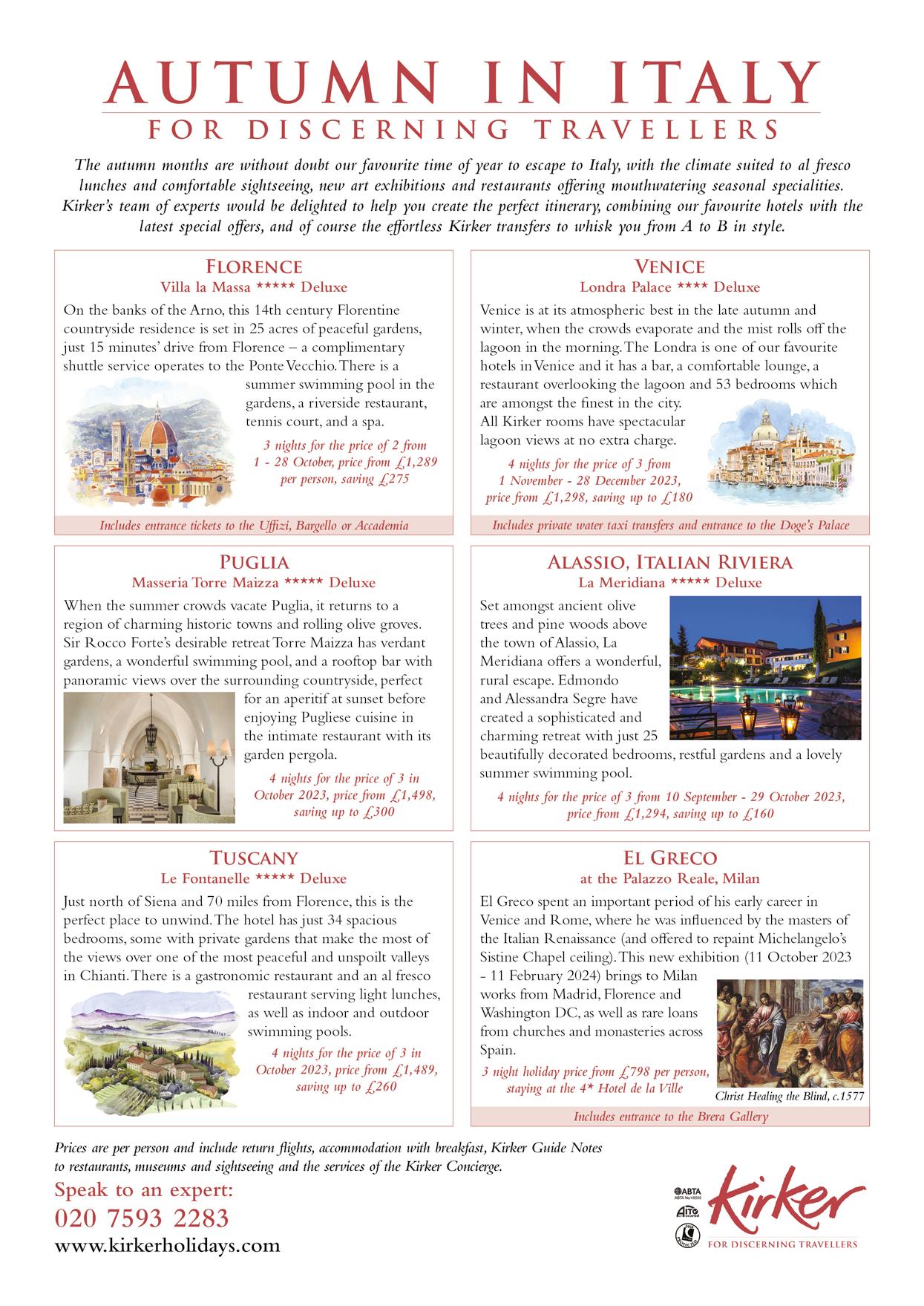
Noël Coward’s MeToo moment
The night the Master groped Judy Campbell, Jane Birkin’s mother
Sadly, I didn’t know Jane Birkin, the Anglo-French actress, singer and beauty, who died in Paris in mid-July at the age of 76.
I had admired her since I was a teenager and saw her, naked, in Antonioni’s seminal Sixties movie, Blow-Up. Later, I got to know the star of the film, David Hemmings (19412003). He told me that Birkin only agreed to get her kit off in Blow-Up because her husband at the time, John Barry, taunted her, saying she wouldn’t dare.
David explained that Jane was very self-conscious about her diminutive bust, but claimed he had reassured her with the line, ‘Who’ll be looking at your breasts, darling, when your face is so lovely?’
Happily, I did know Jane Birkin’s mother, the actress Judy Campbell (1914-2004), and she was very beautiful, too. She had no misgivings about her bust. She told me that, during the Second World War, when she was touring with Noël Coward, playing Elvira in his play Blithe Spirit, she was startled to find Coward, mid-scene, unexpectedly putting his arm around her shoulder and then slipping his hand inside her evening gown and under her breasts. She told me she was rather thrilled at the time.
‘Have I succeeded where so many other women have failed?’ she wondered.
No. Coward was simply trying to keep his hands warm in a cold theatre during fuel-rationing.
Her first claim to fame was singing A Nightingale Sang in Berkeley Square in the 1940 revue New Faces
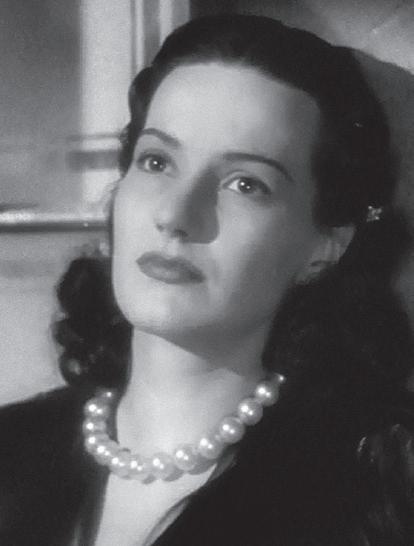
The title of the song (one of my favourites) was taken from a short story by Michael Arlen. Eric Maschwitz wrote the lyrics, Manning Sherwin the music.
To my surprise, in the Daily
Telegraph the other day, Charles Moore, attributed the song to Noël Coward. How do these mistakes get through?
More egregious still, in the Mail on Sunday recently, as a so-called ‘Quote of the Week’, the words ‘Emma Chizzitt’ appeared with the explanation: ‘The name Rebus author Ian Rankin mistakenly put on a fan’s copy of his book – the Australian had actually asked, “How much is it?”’
It’s an old joke first made famous by Kenneth Williams when he was in Australia promoting his book Acid Drops in the early 1980s.
I fear I have reached the age when I find myself constantly muttering to myself, ‘Who edits these papers? Does nobody know anything any more?’
Let me tell you a story... Once upon a time, some 60 years ago, a young boy and a young girl were at separate but neighbouring schools.
They knew each other and were attracted. She thought that he was dashing in his sport of fencing. He thought she was elegant in her tennis dress, but nothing happened beyond friendly, gently flirtatious conversation.
They lost touch and lived hundreds of miles apart but, through a mutual friend, received news of one another.
Last year, both being widowed after long marriages, he, no longer a shy boy, made contact. That first telephone call lasted 40 minutes. Subsequent calls rarely lasted less than an hour.
One day, she declared that she loved seaside piers. ‘Right,’ said he, ‘I shall kiss you on every pier in the land!’
That’s how I got to hear about Paul and Janet.
Alongside Timothy West and Joan Bakewell, I am a proud patron
of the National Piers Society, an organisation that celebrates and does its best to help preserve our country’s rich heritage of piers.
Paul contacted the society to help plan his pier-cum-kissathon. Once Britain boasted more than a 100 piers, he discovered. We still have around 63.
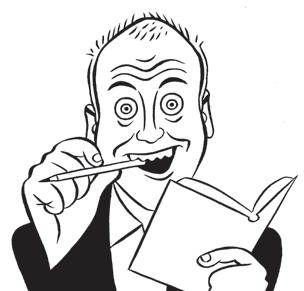
According to Paul, ‘Worthing and Brighton were soon visited and “kissened”.’ The next trip took in Clevedon, Weston Grand, Weston Birnbeck, Weston Revo, Burnham, Teignmouth Grand, Paignton, Torquay Princess, Weymouth Pleasure, Swanage, Bournemouth, Boscombe, Hythe, Southsea South Parade and Bognor.
‘Phew!’ says Paul, ‘Only 35 to go.’
When the couple reach the final pier, Paul tells me that (if he still can) he plans to drop on one knee and pop the question.
‘Piers,’ says Paul, ‘are very romantic.’
Who needs Tinder, Grindr, eHarmony or Hinge when you can get in touch with www.piers.org.uk?
I am spending the summer in Edinburgh, strutting my stuff daily with a one-man show as part of the Fringe. Then, in September and October, I am off on tour, taking the show around the UK.
In some places, it’s sold out. In others (for example, Colchester and Cardiff), there are ‘seats in all parts’ and I’d love to see you.
The only downside to being away from home for so long is that I miss our cat. She’s called Nala. We inherited the name (and the cat, in fact) from our neighbours.
Mark Twain named his cat Bambino. Christina Rossetti called hers Grimalkin. Ernest Hemingway had a cat named Snow White. Iris Murdoch named hers Black Madonna.
If we could have christened Nala ourselves, we should have given her the name the poet Thomas Hood gave to his: Scratchaway.
Gyles Brandreth’s Diary
The Oldie September 2023 9
Judy Campbell in 1940


Nothing compares to you, Mum
Is there a more comical phrase, from the mouth of someone pushing 60, than ‘I’m an orphan now’?
There may be rivals. ‘Suella Braverman,’ for example, ‘she’s nice.’ Or ‘I love flying Ryanair.’
For all that, there is something so innately amusing about a decaying sea monster echoing a red-haired moppet singing about tomorrow being a day away… Suffice it to know that I’ve been using that line relentlessly of late, and been rewarded with grins.
Orphanhood commenced in late July, when my mother died almost immediately after the news broke about Sinéad O’Connor. She was buried in August at exactly the same time as the Irish singer.
They had little else in common. My mother had the hideous singing voice she bequeathed me via her DNA, and never ignited a photo of the Pope on live television.
O’Connor almost certainly couldn’t make chopped liver like my mother, and must have been a less hypercritical back-seat driver. Troubled as she sadly was, it’s hard to envisage her screeching, ‘Matthew, you’re going to kill us both,’ whenever a speedometer nudged 15mph.
But in the timing of death and interment, the two were sisters. So excuse the lurch into the bleedin’ obvious when I say of my mother that no one compared (no one compaaaaared) to her.
Familiar as she may have become to that mythical beast, ‘the regular reader’ of this column, I never did justice to her ferocious loyalty, staggering disinhibition, unquenchable kindness, terrifying frankness and ferocious intolerance.
It was she, in a Wimpy Bar in 1973, who rejected seven consecutive cups of tea for unacceptable weakness. And she who later, in a swankier joint, sent back a Scotch on the rocks on the novel ground
that ‘This ice is much too cold.’
When it came to calf’s liver, her requirements as to thickness were so exacting that for a while she carried a pair of callipers alongside the mirror, purse and make-up items in her handbag.
As her personal chef and chief carer these recent years, I know that living with my mother was sometimes hard. But I’d be more than willing to give it another try, because she was as beguilingly lovable a person as I and so many others have known.
Her range of bespoke witticisms was wide, but the one that surged to mind at the funeral was the one she unleashed whenever asked if someone had died. ‘If she didn’t,’ she’d reply, ‘they took a terrible liberty burying her.’
It felt a terrible liberty burying her, because she never grew old in anything but the stark numbers. She was 88 during last winter’s World Cup – she loved her football – and astonished us with her percipience.
Those watching the final with her, and the phalanx of pundits on the BBC, were totally bamboozled by France’s first-half lethargy against Argentina. ‘They don’t look well to me,’ she observed during the interval. ‘I reckon most of them have a bug.’ No one else aired the possibility until after the game, when the French coach Didier Deschamps mentioned a virus that swept the camp in the previous days.
‘Of course I was right,’ she concurred when congratulated on the insight. ‘I’ve only been wrong once in my life – and that was a mistake, and it turned out I’d been right all along.’
As with the loss of any parent, her death unleashes an avalanche of memories, from her impossible glamour during my childhood when she looked almost the spit of Audrey Hepburn and travelled the world as a fashion editor; to the dazzling smile that melted such recent visitors as the nurse who asked if she knew where she was. ‘New Zealand,’ she snapped contemptuously back.
But the memory that most vibrantly stands out comes from a lunch at a Berkshire restaurant a dozen or so years ago, on her daughter-in-law’s 50th birthday.
Even by this family’s standards, it was an eccentric outing from the moment my wife, at my mother’s request, fetched her tortoise Miles from the car and encouraged him to take a constitutional around the table.

My mother was so enchanted by the sight that she toasted Miles a bit too freely. A while later, I was summoned to the Ladies by a nervous waiter. It took her several minutes to undo the lock. When she did, I found her sitting on the floor paralysed by giggling. I helped her up, and we staggered back to the table sobbing with laughter.
We often did, not least on the day her own mother died in 1990. ‘I’m an orphan now,’ she greeted me when I arrived to comfort her, and we exploded with mirth. Grief is no excuse for tiresome sombreness. We didn’t agree about everything, but we agreed about that.
‘I just can’t help feeling that we’d get along better if you had a better job’
A simply magnificent character, she was dependably hilarious until very nearly the end of her long and richly varied life. If there’s any finer way to be remembered than that, I can’t imagine what it might be.

Grumpy Oldie Man
The Oldie September 2023 11
She died at the same time as Sinéad O’Connor - and she was a comic genius matthew norman
who were the Peculiar People?
The Peculiar People were a Christian group founded by James Banyard in Rochford, Essex, in 1838. Banyard, the impoverished son of a ploughman, was born in the town in January 1800.
He became a dissolute youth with a reputation for drunkenness. He was later jailed for petty acts of smuggling and poaching.
He married his first wife, Susan Garnish, in 1823. His drunkenness worsened and culminated in him losing his money and, it is said, most of his clothes at a fair. Susan demanded that he change his ways or she would leave him.
So he started to attend a Wesleyan Chapel in Rochford. It is believed he soon ‘saw the light’, became a teetotaller and even preached on occasions.
In 1837, Banyard became friendly with William Bridges, who was a visiting Methodist preacher from London. He
what is an NPC?
NPC stands for non-player character. It describes the characters in computer games that the player doesn’t control.
The ghosts in Pac-Man, the eponymous expeditionary force in Space Invaders, the villagers you interact with in Zelda, the bystanders you run down in Grand Theft Auto – these are all examples of non-player characters.

NPCs are crude forms of artificial intelligence and essential parts of just about any game you could care to play. They run along predictable paths, as dictated by the programmers. The aim is usually to better them using your superior human intelligence.
After a few plays, you realise the best way to kill a Cacodemon in Doom is to throw a ‘frag’ grenade into their mouth, or that the best way to score a goal in Fifa is (according to my nine-yearold) ‘playing a through ball from
was so taken by his new friend’s views that he became a born-again Christian, preaching forgiveness in all its forms. But his zeal did not find universal favour with all the chapel members, and he was refused permission to hold his own evening prayer meetings.
Banyard’s strength of character and self-belief resulted in a split among the chapel members. He attracted a group of followers, known as the Banyardites. They strongly believed in spiritual healing and the power of prayer and refused the use of the medical profession.
Banyard and his followers called themselves the ‘Peculiar People’ from phrases in the Bible that appear in both Peter and Deuteronomy. He said the group’s name reflected a translation of ‘God’s cherished personal treasures’. Their form of worship was based on their interpretation of the King James Bible In 1843, Banyard married for a second time, to Judith Knapping, and they had seven children. His wife was from a wealthy family and this enabled him to
buy a plot of land on which to build the Peculiar People’s first chapel. He became the group’s first elected leader.
Sometime later, Banyard’s son fell seriously ill and he summoned help from a doctor, which caused dissent among his flock, and many left. He continued to preach until he died in 1863.
In 1910, there was a diphtheria outbreak in Essex, which split the followers again into Old Peculiars and New Peculiars, depending on their views on the use of medical care. This split wasn’t healed until the 1930s.
By 1956, members had changed the group’s name to something less divisive, namely the Union of Evangelical Churches. A chapel was built but in the 1980s it was demolished to make way for a housing estate. There were other changes, which included the creation of the Rochford Community Church in 1987. The Union of Evangelical Churches continues in east London and Essex. The original name of the Peculiar People is almost forgotten.
Colin Westney
the edge of the box’. But NPC has a subsidiary meaning, too. In internet slang, an NPC is someone with no critical reasoning skills who parrots political talking points in a seemingly pre-programmed manner.
‘If you get in a discussion with them, it’s always the same buzzwords and hackneyed arguments,’ one poster explained on the anything goes forum 4chan in 2016. ‘It’s like in a [video game], when you accidentally talk to somebody twice and they give you the exact lines word for word once more.’
The term became popular with Right-wing trolls on social media after Donald Trump’s election when it was commonly used to dismiss Hillary Clinton supporters. And it has re-emerged with a vengeance on Twitter since Elon Musk took over the platform.
I noticed it when a user tweeted that his wife was selling their Tesla, so appalled was she by the direction Twitter had taken under Musk. ‘Lol, then your wife is an NPC,’ replied a person called
@MAGAtakes. What’s quite funny about this is Musk’s fanboys (who tend to overlap with Trump fanboys) behave precisely like NPCs.
But is it so bad being an NPC? I got into a discussion not so long ago with the philosopher Sacha Golob about whether AI art undermined human individualism.
‘It is really hard to be an individual, right?’ he said. ‘Most of us aren’t really individuals. With most people, the things they like, the goals they have, the positions they take are of a type. It’s why everyone’s Instagram posts look the same.’
Maybe it’s simply best to admit it. Over on TikTok, meanwhile, the NPCs are having the last laugh. The big craze of 2023 is ‘NPC Streaming’. This is when real-life people pretend to be computer-game characters and parrot set phrases when followers send them digital knick-knacks.
‘Mmm! Ice cream so good!’ and so on. If that made no sense, I promise you, watching one of these performances makes even less sense. But some people make thousands of dollars a day this way.
Richard Godwin
12 The Oldie September 2023
NPC ghosts: Pac-Man


Larry Grayson, born 100 years ago, was a child actor, female impersonator – and national treasure. By Christopher
Sandford
Shut that door!
You might think a birth name of William White, which as a boy he shortened to Willie White, had quite enough comic potential for an entertainer who later brought high camp to British television.
But, in the end, he rejected it for the nom de panto Larry Grayson.
William was born, out of wedlock, on 31st August 1923. He never knew his father and grew up with a foster family in Nuneaton, Warwickshire, where his mother sometimes visited him as ‘Aunt’ Ethel.
Then his foster mother died when he was just six years old, leaving him in the
care of her two adolescent daughters.
His childhood may have had its Dickensian side, but it also supplied many of the real-life models for his later comic monologues featuring the likes of Apricot Lil, Pop-it-in-Pete the postman, and Slack Alice, the coalman’s daughter with her Black Bottom.
Leaving school at 14, William made his stage debut at a local working men’s club, singing a number called In the Bushes at the Bottom of the Garden. Both it, and his later repertoire, were a veritable dictionary of musical innuendo.
From there, using the name Billy Breen, he went on to develop a variety act as a female impersonator, sashaying

around in a knee-length frock and a beret. Delivering his lines with pursed lips and fluttering eyes, he was as high camp as a row of Alpine tents.
A few years later, he changed his stage name for the final time, taking the surname of the Show Boat star Kathryn Grayson, and adding ‘Larry’ because he liked the sound of it.
Grayson spent the next 30 years slogging his way through clubland, honing his brand of slightly surreal, observational comedy.
Some of his trademark catchphrases took root as a direct result of his working environment. ‘Look at the muck on ’er’ originated when he followed a parrot
14 The Oldie September 2023
ITV / SHUTTERSTOCK
In the swim: on The Larry Grayson Show, 1977
impersonator – or a real parrot, in some accounts – out on stage.
‘Shut that door!’ – his most famous catchphrase – came when he felt a sudden draught while performing at a seaside theatre in Redcar. Grayson instinctively shouted the phrase, got a laugh and kept using it.
A gentle and genuinely shy man, Grayson was in some ways an unlikely candidate to be a public entertainer, let alone one who pranced around the nation’s provincial clubs and holiday camps in a frock before finally hitting the big time in his fifties.
Post-war British audiences may have enjoyed a good drag act, but the times as
a whole were still inhospitable to openly gay performers. Perhaps, as a result, Grayson preferred to keep his personal life quiet.
The closest he ever came to a love match was with a Nuneaton school friend called Tom Proctor, who was killed in action at the Battle of Monte Cassino in 1944, at the age of 21. Grayson never got over the loss.
His only live-in companion in later life was his beloved foster sister and surrogate mother, Florence, known as Fan, although he was once rather improbably said to have been engaged to the actress Noele Gordon of Crossroads fame.
‘Larry and sex just didn’t go together,’ says his former manager, Paul Vaughan. ‘I remember when gay activists were trying to out him, and two of them came in to meet him in his dressing room. He just sat there with his poodle, Arthur Marshall, and said, “Now what’s all this about?”
‘One of them said, “Mr. Grayson, we just want you to come out and say you’re a homosexual.” Immediately Larry put his hands over Arthur’s ears and said, “Ooh, you can’t use language like that in front of my dog.”’
Grayson’s big break came in 1972, when the ATV boss Lew Grade signed him up for his Saturday night variety show, before giving him his own 16-part series, Shut That Door! Actually, it was more like a door opening.
When Bruce Forsyth left the BBC in 1978, Grayson took over as host of The Generation Game, which was soon trouncing Forsyth’s rival ITV show The Big Night in the ratings.
An engaging mixture of observational humour, sexually ambiguous jokes and good, old-fashioned show business oomph, it once attracted an audience of 25 million viewers, although admittedly the competing channel was out on strike at the time.
Unusually, it was Grayson himself, not the network executives, who ended his tenure on The Generation Game in 1982, citing his desire to ‘go out on top’ – another line he delivered with a knowing roll of his eyes.
After a series of only fitfully successful comebacks, Grayson made his final television appearance on 3rd December 1994, as part of the Royal Variety Performance recently filmed at the Dominion Theatre in London.


‘You thought I was dead!’ he commented from the stage, referring to his long absence from the nation’s screens. Sadly, only a month after the show’s transmission, he actually was dead, after suffering a fatal haemorrhage at his Nuneaton home in the early hours of 7th January 1995. He was 71.
Grayson never quite became an international superstar, although he had his moments, and was obviously reluctant to be a spokesman for anyone’s causes.
‘Endearing’ was the usual verdict, upgraded in the polite obituaries to ‘beloved national treasure’.
The Oldie September 2023 15
Christopher Sandford is author of The Man Who Would Be Sherlock: The Real Life Adventures of Arthur Conan Doyle
On The Larry Grayson Show and, left, with the Lochiel Marching Band of Scotland on The Generation Game in 1978
For his film sets, producer Gareth Neame turned Edinburgh into Belgravia and Hungary into colonial Virginia
Location, location, location
Only a handful of films or television shows that are developed – when a script is written and the concept worked out – will actually make it to the screen.
For all sorts of reasons. Priorities change, executives leave their jobs, budget issues ... the list goes on.
When I was developing Downton Abbey in 2009, it suddenly started to look as though we might get our show ‘greenlit’. Until then, the series was just words on a page and the abbey itself was in my imagination.
While most film settings are an amalgam of different places in the minds of the creatives involved, when I asked our writer, Julian Fellowes, which real location best characterised the show, he immediately proposed Highclere Castle.
Because it hadn’t been seen often on screen before, I had to confess I had barely heard of the place. I took a look.
Unannounced, I arrived in an empty car park and bought my ticket for the house tour. Our group consisted of me and a young father with his two sons who seemed more interested in the outstanding Egyptology exhibition than the architecture of Sir Charles Barry.
Cut to a year or two later and Highclere had become one of the most famous historic buildings in the world, just as Castle Howard was world-famous in the decades after Granada’s landmark Brideshead series.
When the setting is the show itself, choosing the location is like casting the star actor. Suitable as Highclere certainly seemed, it felt too crucial a decision to make that easily. I insisted that we spent the autumn of 2009 looking up and down the length of the country at the other
candidates to ensure we had considered every possible option. Newby Hall in Yorkshire was almost the one.
Having visited many dozens of places, we came back full circle to Highclere –chosen due to its dazzling architectural self-confidence, symbolising the apogee of the British aristocracy.
Prior to Downton, most period dramas had been literary adaptations and heavily dependent on Georgian and Regency architecture – so Barry’s high Victorian statement was a fresh approach on screen. We loved the elegant suite of interconnecting state rooms and the fact that it is somehow both grand and intimate, ideal for a series that’s ultimately about a family.
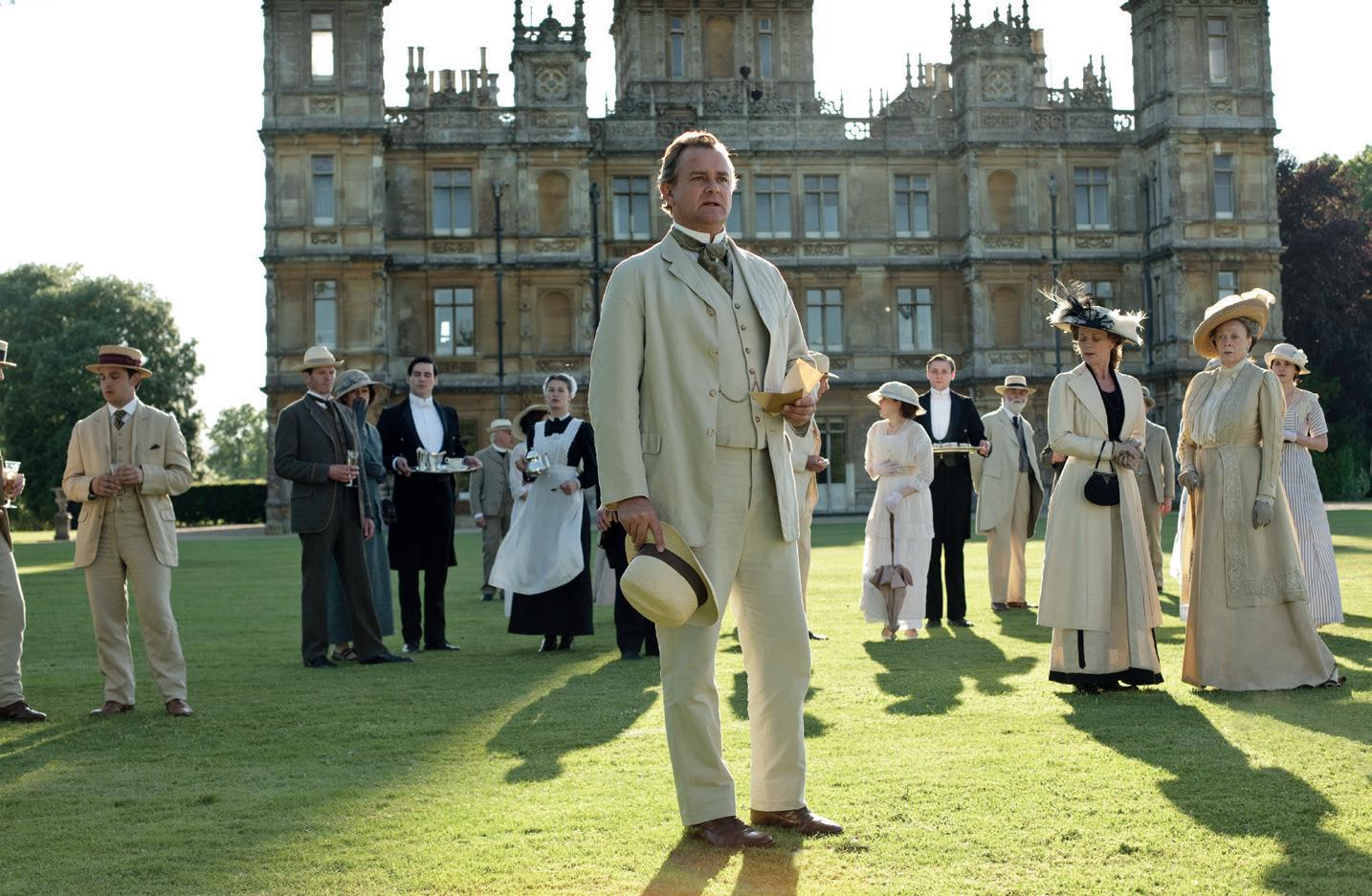
Highclere Castle – the ‘Real Downton Abbey’, as it is now affectionately known – became the backbone of our world, though viewers often forget that only the
exterior and state rooms are used. The bedrooms upstairs and the whole servants’ quarters were constructed on a sound stage. That’s why a footman could take a tray of food up the backstairs at Ealing Studios, to serve the dishes in the dining room, filmed at Highclere about a month later, with the extraordinary Van Dyck portrait of Charles I gazing down.
For the village itself, Bampton in Oxfordshire was selected. Again, this picturesque Cotswold village had never appeared on screen, though it is now famous enough to merit coach tours – unofficial and neither encouraged nor authorised by us, I can assure you, good denizens of Oxfordshire!
You’d think that choosing locations is all about creativity and the look, though, as with practically everything in life, it is ultimately about money. Many countries around the world offer attractive financial
16 The Oldie September 2023
Neame visited dozens of houses before casting Highclere Castle as Downton Abbey
incentives to producers to select their camera-friendly landscapes. In choosing where to shoot, I have to combine the on-screen visuals with the most costeffective locale based on my budget.
Only James Bond globetrots to all the real settings in those movies. For most producers, the trick is to find one place and create the world from there.
We once made an eight-hour American television series where every episode was set in a different country.
Stories set in Nigeria, Myanmar, San Diego, Paris, Kosovo, Kashmir and Haiti were replicated using a combination of South Africa and Prague. Strong tax breaks in both jurisdictions, you see.
When I made three seasons of Jamestown for Sky, the 1620 Virginia colony was constructed in Hungary, which has one of the best tax incentives in Europe and a first-class film industry.
Central Europe endures the contrast of bitterly cold winters and extremely hot summers. When Sky bought the show, I had to insist they stick to a defined schedule: while I could create a subtropical feel filming May to September, the other half of the year would be more appropriate for a show set in Siberia.
The River Danube became Chesapeake Bay and very convincing it was too. We flew Native American actors from North America and the soundtrack of insects added to the actualité.
Hungary also doubled as 9th-century England for all five seasons of our Netflix series The Last Kingdom and the subsequent movie Seven Kings Must Die. I shot a film about the Gallipoli campaign in Andalusia and a miniseries about the Gunpowder Plot in Romania.
Most films and television series require hundreds of different locations to tell the story. Film people get terribly excited when they are breaking new ground. The location manager proudly explains to the director and designer that this chalk quarry – or whatever – has never before been revealed on screen. In fact, audiences don’t really give a hoot about that, if they even notice at all.
For Downton Abbey, we use many of the same grand locations they use on The Crown, including Lancaster House, Wrotham Park and Goldsmiths’ Hall, but I doubt many viewers are troubled by the duplication. Because any production has multiple locations, it is how you curate these, and combine them, together with the set decoration and cinematography, that can ring the changes.
A lot of film-making is about logistics. Although Highclere Castle happens to be
both the exterior and the interior of Downton, it is perfectly normal to switch these things around and film the exterior of one building and the interior of another.
When a setting is particularly complex and the real thing just doesn’t quite exist as the script demands, then an on-screen setting can be a combination of multiple locations, giving the appearance of a single place in the finished show.
Woe betide the director who selects one location in the Highlands of Scotland and another in south-west England. In that scenario, we lose at least a day’s filming time getting from one location to the other, with trucks being driven through the night.
We like to cluster locations together and make a company move as infrequently as possible. A film crew is an enormous circus and there is no point us choosing the ideal-looking location if we can’t get all our machinery and personnel there easily. At times roads are even built!
There were some mumblings in Somerset when we decided to film Lorna Doone in the Brecon Beacons in 2000. We filmed right out in the wilds during the fuel-tanker drivers’ strike and came perilously close to running out of fuel.
The joy of location hunting is about landscapes and architecture, both in abundant supply in this country.
The BBC series Spooks was set inside MI5, supposedly. Shooting such a high-profile series on the street outside MI5’s real headquarters Thames House in Millbank would have been logistically impossible. So, we found an alternative central London building of the same era, in similar Imperial Neo-classical style, Freemasons’ Hall in Covent Garden, which doubled as our intelligence base.
In recent years, advances in visual effects have made so many things
possible that could not have been achieved before. Another challenge was our 2019 production of Belgravia. The SW1 postcode, with the majority of the capital’s embassies, plenty of high-end residences and busy traffic, absolutely prohibited filming on any scale.
I asked my colleague Donal Woods, also the Downton production designer, if we couldn’t make a show called Belgravia in Belgravia, then how could we do it?
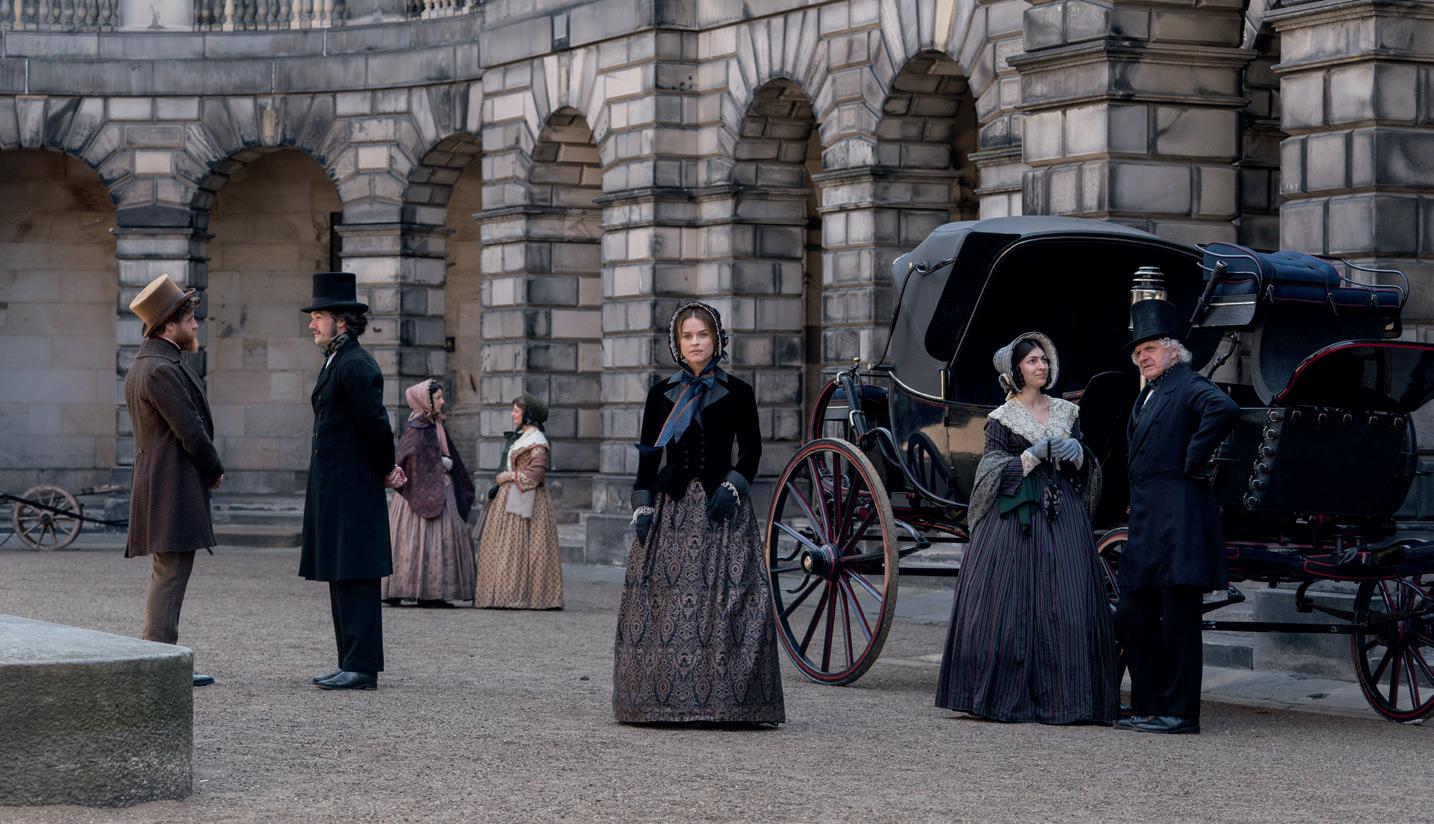
On his laptop he showed me pictures of Edinburgh’s New Town, with the obvious flaw that the stone buildings are not stuccoed – the signature look for Thomas Cubitt’s Belgravia development.
Furthermore, a large number of houses in Belgravia have rather grand porticoes, where in the New Town they tend to be flat-fronted. He then revealed images where the ‘stucco’ was artificially added on afterwards. And so, all the exteriors were filmed in Edinburgh, with white stucco and entire porticoes added on digitally. The results were remarkable.
As with cinematography, costumes and music, locations are one of the main components of the toolbox to create a film or television show. The possibilities really are endless and they change our own perception of the landscapes and built environments in which we live.
And we are so blessed in these islands. For an American or global audience, the appeal of Downton Abbey, The Crown or Bridgerton is their mystique. But, in this country, none of us live far from beautiful and historic locations.
Some are frequently – or famously – seen on screen, but many more are waiting for their moment in the limelight. We live among pictures and stories.
The Oldie September 2023 17
Gareth Neame is the producer of Downton Abbey
London Scottish: Belgravia was filmed in New Town, Edinburgh
You can’t have it all
Women are told you can be a good mother and have a dazzling career. It’s an impossible dream, says Charlotte Metcalf
Apsychotherapist once told me that around half her patients were middle-aged women trying to come to terms with not having children.
As someone who almost missed motherhood myself, I was struck by this and began wondering why my generation of female oldies had been so easily seduced by the idea of having it all when, simply, we could not.
When I arrived at Cambridge University at the end of the Seventies, there were still far fewer women than men. Those of us who’d somehow barged our way into this male-dominated bastion were made to feel like high-achieving pioneers, convinced we’d go on to have glittering careers, unlike most of our mothers.
My mother, a highly intelligent, competent woman, neither attended university nor worked. She was so in awe of my ability to enter a hallowed academic institution, an opportunity never presented to her, that she didn’t think it was her place to discuss life’s basic but important concerns with me. Only very occasionally did she suggest I should not leave it too late to have children.
After university and a sojourn in movies and pop videos, I became a documentary director. I travelled the world with my camera, congratulating myself on having a fascinating, fulfilling career. I’d bought a one-bedroom flat with a small mortgage in my mid-twenties and was earning enough to take holidays in nice hotels.
One day, I was filming in an African village and a group of women asked me how many children I had. I confessed that I had neither children nor husband.
‘Oh no! So then you having nothing!’ they wailed with pity. I ignored the niggling anxiety this exchange rendered and instead regaled guests at my 40th birthday party with the story, insisting friendship was the only necessary ingredient for having it all.
Allison Pearson’s 2003 book I Don’t Know How She Does It shed a harsh, unforgiving light on juggling motherhood and career. Wealth buys nannies and a supportive infrastructure, but it can never buy back those precious moments watching children’s first steps, the school plays, the sports day mini-triumphs.
For me, the book was proof that I’d made the right decision not to have children. Yet it was an omission rather than a decision, and, for all my stimulating, globetrotting jobs, I was miserable.
It was with joy that I discovered I was pregnant and gave birth to a daughter and inherited a stepdaughter in my forties. I thought my freelance career would be flexible enough to grant me the best of both worlds, but all too fast I floundered.
I was once filming at a Chinese takeaway on an Essex council estate under siege from a gang of racist boys.
It was around 1am and the children, aged between ten and 12, were becoming increasingly rowdy, threatening and taunting the beleaguered brothers who ran the place. I already had some good footage but I knew if I stayed another hour, I’d capture some even better, harder-hitting shots. Yet I left, yearning to return home to my baby. I hadn’t done my best work, but then arrived home too late to be of any use.
I’d failed at both job and motherhood.
To be a good film-maker demands grabbing a camera and leaving the house whenever the story demands.
Even with all the nannies in the world, who as a mother is ever really emotionally ready to leave a child’s bedside, birthday party or piano recital?
Motherhood makes you soppy. I used to be tough enough to point my camera at almost anything and made numerous films about female genital mutilation. With daughters, I’d become fearful, upset and emotional.
I became a journalist instead, believing this would allow me more time at home and less stress. I underestimated how hard it was to break into newspapers and magazines. On top of that, print journalism was floundering, migrating online. Pay was – and remains – pitiable.
There are of course many mothers in lucrative, leading roles today. My generation’s ‘have-it-all’ pin-ups are Nicola Horlick and Ursula von der Leyen (pictured), President of the European Commission with her seven children.

But lockdown made millions rethink their work-life balance. Now, as costs spiral and the recession bites, what’s really going to make us happy? A huge job will keep a decent roof over our heads but it detracts from the time with family and friends that keeps us sane.
Socrates had it right all along: ‘The secret of happiness, you see, is not found in seeking more, but in developing the capacity to enjoy less.’
My daughters face paying half their salary on rent and crippling university loans. They can’t envisage ever earning enough to buy a flat. Despite their generation’s collective anxiety, their expectations are more realistic than ours were. Without such an emphasis on over-achievement, they could end up being happier. My life has demonstrated that striving for it all is a sure route to failure.
18 The Oldie September 2023
Charlotte Metcalf is editor of Great British Brands
How does Ursula von der Leyen do it?

Forty years ago, John Lloyd wrote The Meaning of Liff with Douglas Adams – despite a huge row over their previous collaboration
The Hitchhiker’s Guide to the Dictionary
In my early twenties, my best friend was a tall, clumsy genius called Douglas Adams.
In 1978, he had got stuck writing the first series for BBC Radio 4 of The Hitchhiker’s Guide to the Galaxy and asked me to help him finish it.
We’d written together often before –so I said yes.
‘I don’t suppose there’ll be a second series, Johnny,’ he said, ‘but, if there is, let’s do it together.’
It had taken Douglas 10 months to write the first four scripts, but we polished off the last two in three weeks.
The series was an instant success and, before it had even finished going out, we’d been invited to lunch by no less than six publishers.
We signed with Nick Webb at New English Library for £3,000 – half for each of us – and booked a month’s holiday in Corfu to write it.
Then Douglas sacked me. He’d decided the episodes we’d written together weren’t as funny as the ones he’d written on his own.
I was blindsided, heartbroken and furious. I couldn’t even look at him. ‘Are you all right, Johnny?’ he asked solicitously. And when I made it very clear I wasn’t, he said, ‘Why don’t you get yourself an agent?’
So I went to see the redoubtable Marc Berlin, still my agent today and known (for his tough negotiating skills) as ‘The Berlin Wall’.
He ran London Management, the largest entertainment agency in the country, and told me gleefully, ‘We can take this guy for 10 per cent of anything with the name Hitchhiker on it for the rest of his life!’ I was appalled.
‘No, no,’ I said, ‘I just want my half of the advance for the book.’ And we settled on that, though Douglas wasn’t pleased.
‘When I said, “Get yourself an agent,”
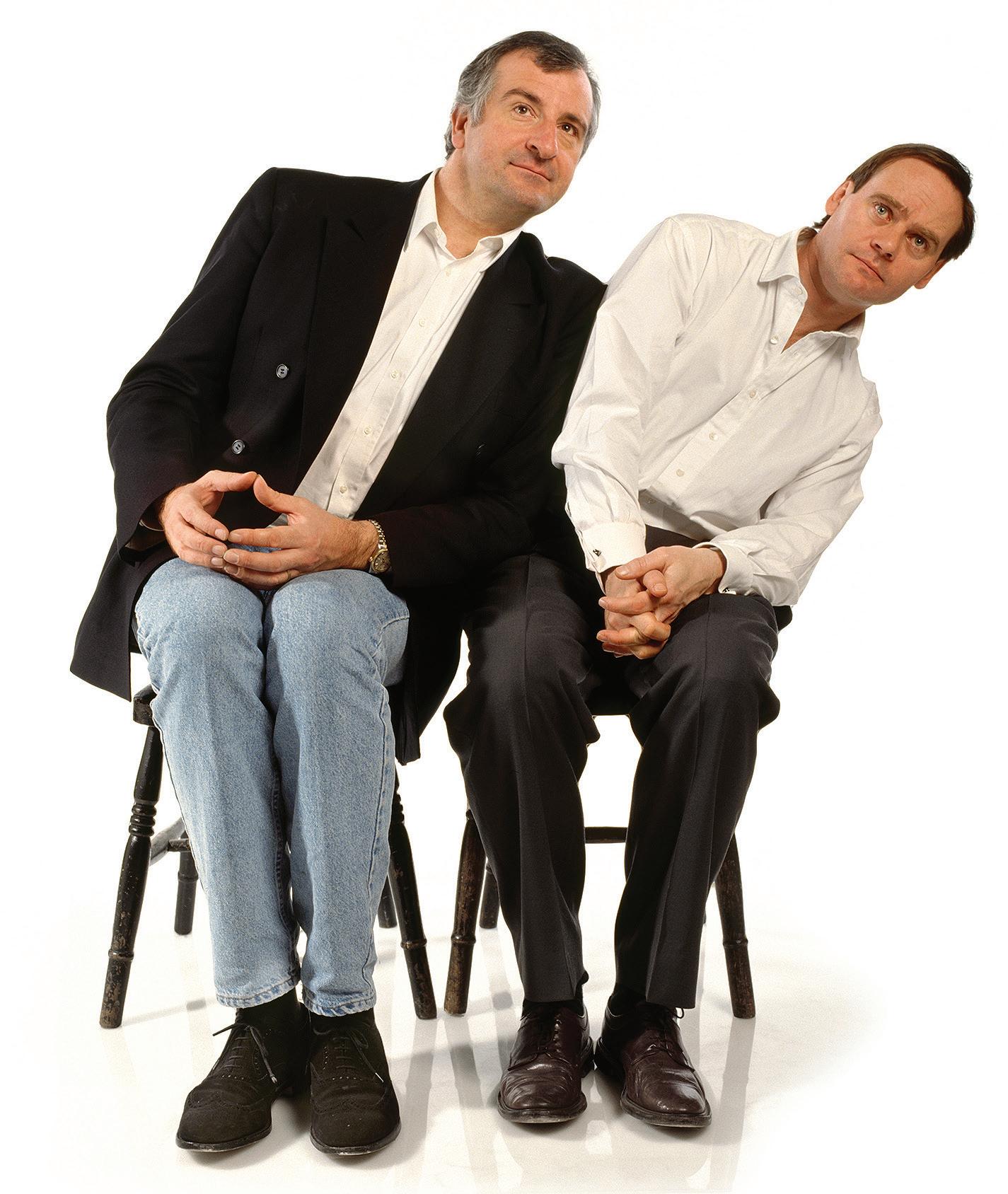
he yelled, ‘I meant, “And write your own bloody book!” ’
Astonishingly, given the acrimony between us, we set off for Greece together.
It was odd to begin with. Douglas would get up in the morning and sit at a table on the terrace in an enormous Terry Pratchett hat and start writing, while I went down to the windswept taverna on the beach from where the Great Novelist was visible to all.
By about 11am, the GN was creatively
exhausted. He’d trudge down the hill and we’d tuck into a bottle of retsina and play games. Our favourite was one Douglas’s old English master had introduced to his class in free periods, or at the end of term. ‘What do you think Epping means?’ he’d say. Or ‘What do you think an Ely might be?’
Ely was the first definition we came up with – ‘The first, tiniest inkling that something, somewhere, has gone terribly wrong.’ It was so neat, so useful and so satisfying that we became hooked. I
JILL FURMANOVSKY VIA ROCKARCHIVE.COM
20 The Oldie September 2023
Adams and Lloyd: ‘Imber’ – lean from side to side while watching a cinema car-chase
kept notes of all the best ones.
Douglas failed to finish the book on that trip, and I went off to television to produce Not the Nine O’Clock News
In 1981, Robert McCrum, the editorial director of Faber & Faber, got in touch about publishing a spin-off joke-a-day calendar from the show. I took on the job of editor.
Though Not the Nine employed dozens of freelance writers, finding two appropriate jokes for each day of the year (one for the front of each page and one for the back) was a huge task and I soon ran out of material. Scrabbling around for ideas, I found the notes of my chats with Douglas in 1978 and was surprised at how good the lines were.
Kettering n. The marks left on your bottom or thighs after sitting sunbathing on a wickerwork chair.
Silloth n. Something that was sticky and is now furry, found on the carpet under the sofa the morning after a party.
Motspur n. The fourth wheel of a supermarket trolley which looks identical to the other three but renders the trolley completely uncontrollable.
I put these into the book – which was called NOT 1982 – under the heading ‘Today’s new word from The Oxtail English Dictionary’.
When the proofs came out, Faber’s chairman, Matthew Evans, said, ‘There’s one idea in here that stands out and could make a book in its own right – the dictionary definitions.’
I told friends about this and soon had a peremptory message from Douglas: ‘Do nothing before you speak to me.’
So we wrote it jointly, co-published by Faber and Douglas’s imprint, Pan. By then, Douglas was an international
The Meaning of Li Glossary











Aalst n.
One who changes their name to be nearer the front.
Ahenny adj.
The way people stand when examining other people’s bookshelves.
Albacete n.
A single, surprisingly long hair growing in the middle of nowhere.
Articlave n.
A clever architectural construction designed to give the illusion from the top deck of a bus that it is far too big for the road.
Berriwillock n.
An unknown workmate who writes ‘All the best’ on your leaving card.
Fulking vb.
Pretending not to be in when the carol singers come round.
Grimbister n.
Large body of cars on a motorway all travelling at exactly the speed limit because one of them is a police car.
Harmanger n.
The person who takes the blame while the manager you demanded to see hides in his o ice.
Kentucky adj.
Fitting exactly and satisfyingly. The cardboard box that slides neatly into a small space in a garage, or the last book
which precisely lls a bookshelf, is said to t ‘real nice and kentucky’.



Lamlash n.
The folder on hotel dressing tables full of astoundingly dull information.
Ockle n.
An electrical switch which appears to be o in both positions.
Peoria n.
The fear of peeling too few potatoes.
Polperro n.
The ball, or mu , of soggy hair found clinging to bath over ow holes.
Shoeburyness n.
The vague uncomfortable feeling you get from sitting on a seat which is still warm from somebody else’s bottom.
Spo orth vb.
To tidy up a room before the cleaning lady arrives.
Stebbing n.
The erection you cannot conceal because you are not wearing a jacket.
Symonds Yat n.
The little spoonful inside the lid of a recently opened boiled egg.
Woking vb.
Standing in the kitchen wondering what you came in here for.
smash, with Hitchhiker books selling by the million. In meetings with the publishers, my suggestions were met with polite indifference and Douglas’s with rapturous admiration and applause.
I wanted the cover to scream, in bold letters: ‘DOUGLAS ADAMS – THE HITCHHIKER’S GUIDE TO THE GLOSSARY.’
I couldn’t have cared less where, or how small, my name appeared. Douglas, however, insisted on calling it The Meaning of Liff. This was because Monty Python had just released their film The Meaning of Life and he figured we might get extra sales from myopic people who thought it was the book of the movie.
To do him justice, he also insisted on equal billing (even though I argued no one would care, or even notice).
Then there was the sizing. I was happy for it to be in a standard format, but Douglas was adamant it should be small enough to fit in a breast pocket. And completely black, like a prayer book.
That was what happened, even though creating a unique size cost the publishers money and annoyed booksellers because it was almost invisible to the naked eye.
Nonetheless, the first run sold an amazing third of a million copies – or, as Douglas despondently put it, ‘only a third of a million’. It was well below the pay grade he’d become accustomed to.
The one advantage of the sizing was that we were able to adorn the back of later editions with three crisp reviews: ‘Brilliant’ – the Times; ‘Brilliant’ – the Sunday Times’; and ‘Small’ – the Cheshunt & Waltham Telegraph.
Douglas died in 2001, impossibly young, at only 49. I have never borne him any ill will. Quite the reverse.
I have a saying I try to live by: Disaster is a Gift. If Douglas hadn’t fired me from Hitchhiker, I’d probably never have done anything else and would have just been ‘that bloke what’s-his-name who works with Douglas Adams’.
Only the other day, a good friend of mine asked me if I’d ever read a book called The Meaning of Liff
‘Yes,’ I said, ‘I wrote it.’ He looked astonished and pulled his dog-eared copy out of his pocket. He stared at the front cover in disbelief. ‘Good Lord,’ he said, ‘I’d never noticed…’
John Lloyd and Douglas Adams wrote The Meaning of Liff – the Original Dictionary of Things There Should Be Words For (Boxtree)
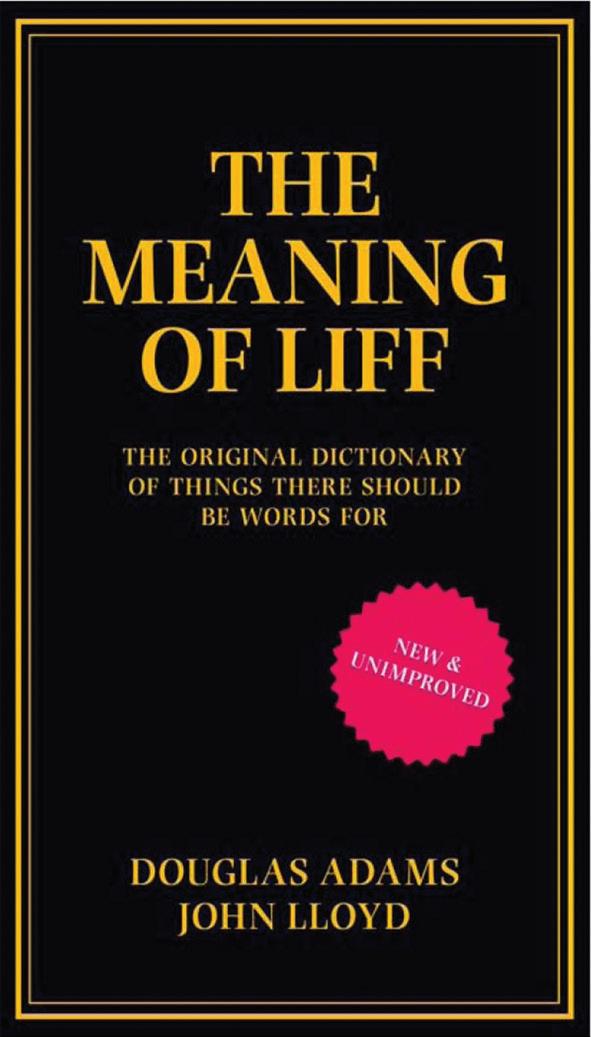
fit was the The Oldie September 2023 21

Je t’aime
The actor Simon Williams had a teenage romance with the late Jane Birkin – and was utterly bewitched by her
Andrew Birkin, Jane Birkin’s brother, and I were illicit smoking buddies at Harrow. His mother, Judy Campbell, and my father, Hugh Williams, were West End stars.
Judy performed A Nightingale Sang in Berkeley Square – perhaps it was from her that her daughter Jane learnt the subtle skill of not-singing.
Best of all, Andrew had a sister, Jane, whom I fell in love with before even meeting her. I too had a sister, Polly, and we soon became a foursome.
It was a special time – we were innocents halfway out of childhood – we played it cool, we jived and blew smoke rings; we played kick-the-can.
One Easter holiday, Andrew wrote a short film, a tragic story of a toff who falls in love with a working-class girl who is incurably ill.
We spent the holidays filming in Chelsea and on the Downs – it involved endless chasing – me grossly anguished in pursuit, and Jane breathless, pitiful and then dead in my arms.
Andrew very sweetly wrote in a love scene to be filmed on the boating lake in Battersea – which turned into a blissful afternoon of licensed kissing with many retakes. When they showed a clip of the film on my This is Your Life in 1986, Jane spoke from the heart about our precious childhood days.
The atmosphere in the Birkin household in Chelsea was not unlike the home of the Bliss family in Hay Fever I would pitch up in my tweed jacket and sit gazing at Jane – not easy as I always whipped off my National Health glasses. It was puppy love, of course – never really reciprocated – but she wasn’t averse to being worshipped even then.
I once found Jane and her father, the heroic David Birkin, drinking champagne and giggling. I had no clue what they were celebrating.
Years later, Jane told me the celebration was for her first period – she had been the last in her year to get it.
She would take me up the King’s Road pointing out all the astounding swinging people – long-haired beatniks, and everyone in bright colours determined to forget the war.
We went to see Audrey Hepburn in The Nun’s Story. Darling Jane had tears pouring down her cheeks and I loved her with a terrible ache – very slowly I put my arm round her.
There’s always been a gamine quality of Audrey Hepburn in Jane – gauche and elegant at the same time.
During the term, she’d send me little sketches of herself lolling about at home. I’m looking at one now of Jane with hair back-combed lying on a chaise longue with her parrot beside her, the walls covered with trendy pics.
When Jane first went to (and fell in love with) Paris, she was living en famille. I would hitchhike up from Tours where I was supposedly studying, and we’d spend hopeless afternoons wandering along the Seine trying to work out how to become movie stars. I gave her a Françoise Hardy LP.

She had a 7pm curfew and I told her
I was staying with friends and spent my nights in the waiting room at Gare Du Nord. In the morning, I’d wait outside the gates of her house with two pains au raisin. In terms of romance, we were in no-man’s-land. I had no idea how to move things forward and we lapsed into an on-off friendship that’s lasted ever since – founded mostly on nostalgia.
Jane went to improv classes at the Royal Court and became enthralled with the avant-garde. She was cast in The Passion Flower Hotel in 1965, the grooviest musical in town, while I was stuck playing the juvenile in drawingroom comedies. I would see her across the dance floors of West End nightclubs with men I never imagined to be her type – she was the beauty to a variety of beasts.
When she auditioned for and got a part in Blow-Up, Jane was nervous about the nudity required of her. ‘My tits are just minuscule,’ she laughed.
I had dinner with her after her first day’s filming in the nude and she was bubbling with liberation. Once she’d taken her dressing gown off, she said it was a piece of cake – ‘I walked about all day totally naked and nobody seemed to even notice.’ I bet they didn’t.
I’ve watched and marvelled at the variety of Jane’s life, the extraordinary choices she made of projects and partners, and the way she tapped so easily into the zeitgeist of Paris life and became an icon, a rebel with many causes. But she never lost her waif-like innocence or the ability to not take herself too seriously – she never lost the giggle of the teenager I had worshipped.
The newspapers say that she eventually gave up on love and was perfectly happy living alone. Maybe not. I remember her once quoting the famous Tennyson line: ‘It’s better to have loved and lost than never to have loved at all.’
We shook our heads – we weren’t so sure about that.
The Oldie September 2023 23
Simon Williams starred in Upstairs, Downstairs
Thrill of the chaste: Simon Williams, 17, and Jane Birkin, 16, in Paris, 1963


Don McCullin, 87, Britain’s greatest war photographer, turns his lens to the heavenly ruins of Asia Minor

My Turkish Odyssey
Ihave been travelling the world for the past 65 years – so I can’t explain how Turkey evaded me until recently.
A couple of years ago, I had the great pleasure of meeting the charming Turkish Ambassador to London at the time, Ümit Yalçın, and it was with his blessing, and alongside my dear friend, the author Barnaby Rogerson, that we embarked on a series of journeys to discover the remains of Roman Turkey. These, I thought, have been somewhat overlooked in a country so full of other historical treasures.
The ambassador opened all the most important museum doors for us, which was marvellous, and I was lucky that Barnaby was a fount of knowledge on the history of these sites.
I remember how I couldn’t get over the beauty of the exhibits at the Istanbul archaeological museums and didn’t know where to start.
The museum in Antalya was equally eye-opening, with the most impressive display of huge Roman figures and some of the best and most creative lighting I have seen in any museum, thanks to the director, Dr Candemir Zoroğlu, who studied for two years at the British Museum.
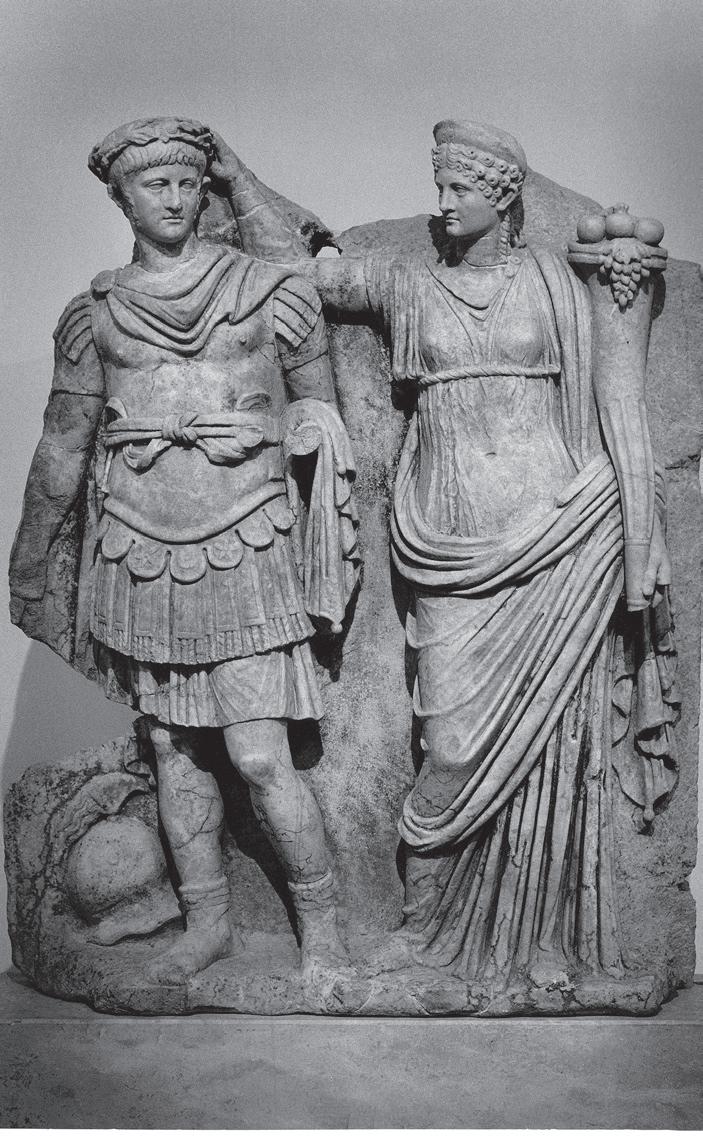
I realised I would need a whole lifetime to document Roman Turkey, as there are simply hundreds of sites waiting to be discovered. Sadly, I am past the age where this is possible, without the strength to clamber over beautiful temples and amphitheatres. A misplaced foot, as I have found to my cost in the past, can be dangerous.
I felt so rewarded by the visual feast presented to me, but also by the warmth and welcome of the people.
DON MCCULLIN
26 The Oldie September 2023
Don McCullin’s Journeys Across Roman Asia Minor (Cornucopia, 1st September), commentary by Barnaby Rogerson
Left: Early Roman Imperial agora, Sagalassos
Below: Agrippina crowning Nero in the Sebasteion, 1st century AD, Aphrodisias

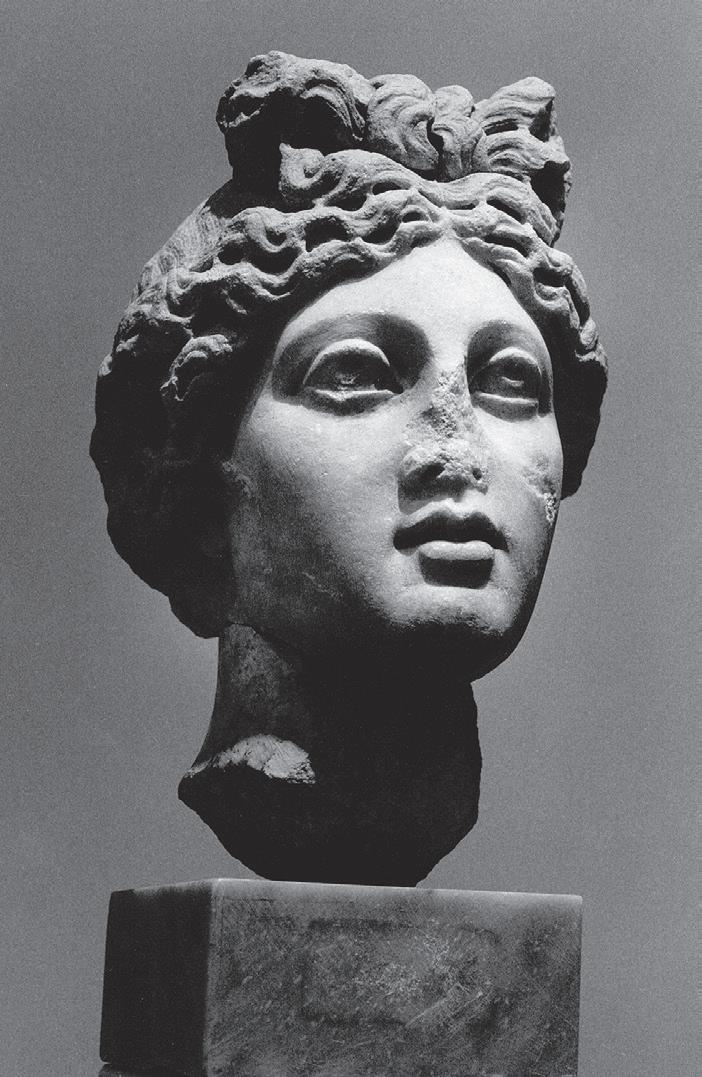
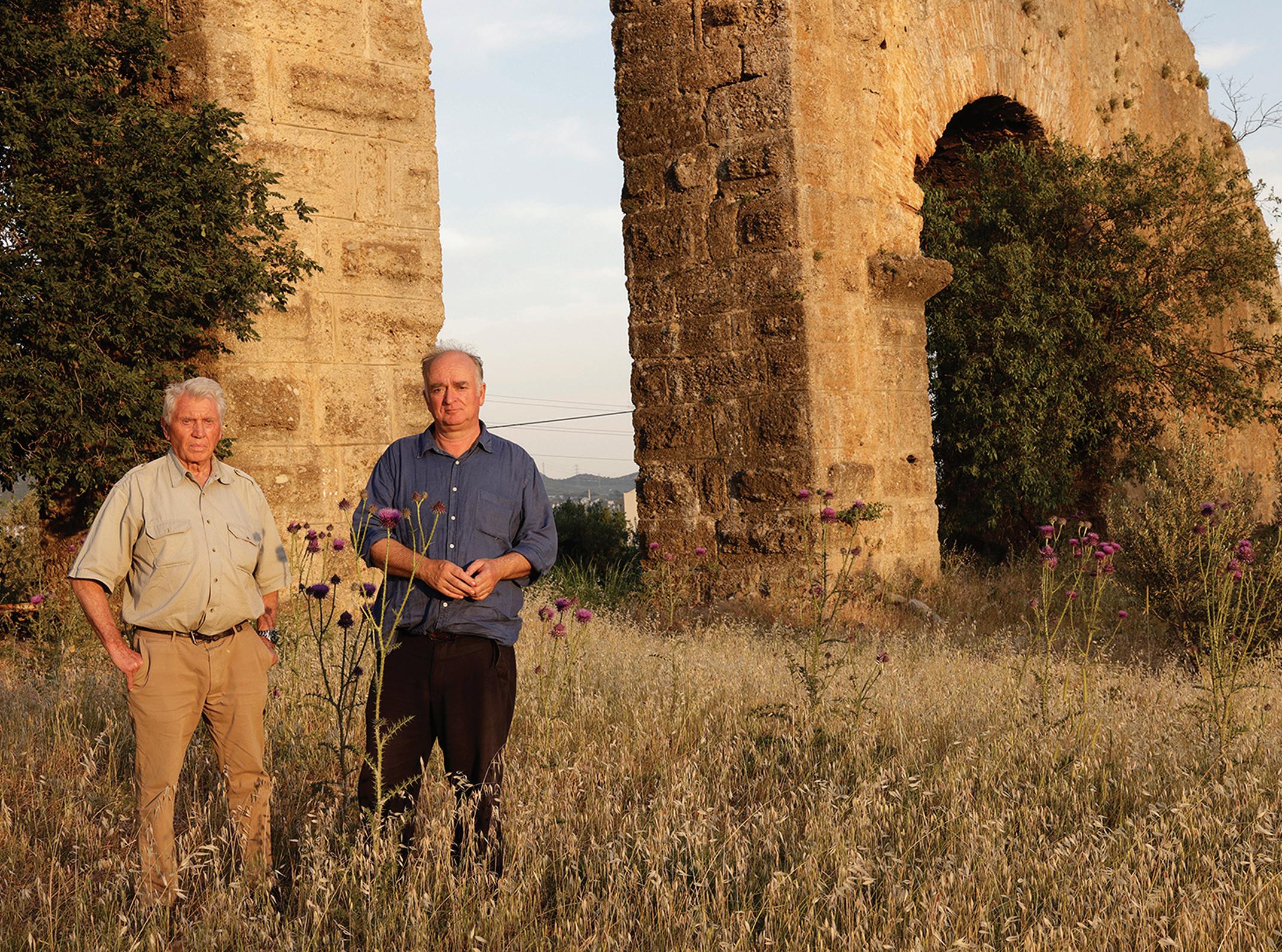
MONICA FRITZ The Oldie September 2023 27
Head of Aphrodite, 2nd-3rd century AD, Aphrodisias
The fourth-largest Ionic temple in the world: the Hellenistic and Roman Temple of Artemis, Sardis
Don McCullin and Barnaby Rogerson by the Roman aqueduct at Aspendos, 2nd-3rd century AD

Throw caution to the wind
The best decisions in life are made on the spur of the moment, says Piers Pottinger
Spontaneity can be wonderful. Several years ago, I was at Deauville Races on a glorious Normandy summer’s day.
Despite hours of homework, my selections had all failed to cross the winning line anywhere near the front. In the last race, I had ten euros left and decided on the spur of the moment to throw caution to the wind.
I picked four horses at random to finish in the correct order in the first four places – a real long shot. To my astonishment, it came off. My wife and I enjoyed a splendid dinner at Deauville’s finest restaurant that evening. In more than 50 years of backing horses this was, sadly, a unique experience.
Some of the most memorable moments in sport have originated in a single, spontaneous piece of skill: the inspired pass in rugby, the sensational shot in golf or the unexpected goal in football. Hours of training and meticulous planning become insignificant when a Messi, Seve or Gareth Edwards produce the moment of magic.
The same applies in comedy, where the term ‘ad lib’ is short for ad libitum, Latin for ‘according to pleasure’.
Jimmy Carr today and Max Miller, in the music-hall days, had the gift. Frankie Howerd could not ad lib, even if his carefully rehearsed asides often appeared spontaneous. He said the best ad libs were the ones he had practised longest.
The master of the wisecrack, Groucho Marx, hosted a television show in the early 1950s where, each week, he would have a guest who had done something unusual. One week, this was a formidable lady who had had 17 children.
When asked by Groucho why, she said, ‘The answer is simple, Mr Marx. I love my husband.’
Without missing a beat, Groucho was rumoured to have said, ‘Well, I’m kinda fond of my cigar, but I take it out of my mouth sometimes.’

It was television in a prudish era, and
it is believed the notorious quip was edited out before the show was aired.
Great artists add a flourish at the last minute to enhance their work.
In 1446, Petrus Christus added a fly, seemingly sitting on the frame, to his Portrait of a Carthusian. Turner added a last-minute splash of red to his painting Helvoetsluys on the eve of the Summer Exhibition of 1832 – simply to irritate his great rival, Constable.
My late uncle, Don Pottinger, was one of Scotland’s top portrait painters. He would spend months on a single portrait. Yet he admitted he often captured the true essence of his subject best in the lightning-fast first sketch.
‘I’ve got it!’ he’d shout.
He felt that the best portraits looked as if the subject was almost conversing with the artist. A wonderful Rembrandt self-portrait in the National Gallery of Scotland epitomises that thought.
Even in the normally staid world of
business the occasional spur-of-themoment gesture can be effective. The great tycoons were often flamboyant characters who revelled in making spontaneous gestures.
Lord Fraser of Allander, the original Hugh Fraser of House of Fraser, was legendary for his humanitarian gestures and sometimes his more commercial ones. He was once asked at a dinner if he felt his business was too Scotland-centric. He replied, ‘See what happens tomorrow.’
The next morning, he announced to his board that he was going to buy Harrods. He did.
The most dangerous – indeed terminal – form of spontaneity is spontaneous human combustion. Larry E Arnold, director of ParaScience International, recorded in his 1995 book, Ablaze!, that there had been 200 cases over the past 300 years.
In 1746, Paul Rolli of the Royal Society wrote of the death by spontaneous combustion of Countess Zangheri Bandi. Described as a ‘large, dull woman’, she frequently doused herself with camphorated brandy to clear her multiple skin blemishes. She also consumed two bottles of brandy a day.
She was found as a pile of ash one morning by her maid, after sitting by her bedroom fire to enjoy a nightcap before turning in. As she was probably almost entirely composed of brandy, it’s likely that the fire ignited the alcohol, causing the fatal explosion.
Most recent cases of supposed spontaneous combustion are explained by doctors as being caused by copious intakes of alcohol. Worth bearing in mind when a friend suggests ‘One more for the road?’ and you make a spur-of-the-moment decision.
The Oldie September 2023 29
Very wise cracks: Groucho Marx, master of the lightning-quick riposte
From rags to rich men
Coco Chanel designed the little black dress and Jackie O’s pink suit –and had a gift for attracting tycoons. By Philippa Stockley
Today the word Chanel conjures up sugary tweeds and perfume.
In fact, Gabrielle ‘Coco’ Chanel was the 20th century’s most influential designer. During a 60-year career, her designs shaped generations, from the 1926 little black dress to the famed suit of the Fifties. She died in the Ritz in 1971, aged 87, after working all day.
And now a new V&A show is paying tribute to her genius.
Chanel used rich and aristocratic men as a climbing frame to bankroll and promote her. She constantly refreshed her designs, running an empire by her forties, and outlived all her competitors.
But her meteoric rise had a dismal start. She was born illegitimate to market traders in 1883. Her mother died when Chanel was 11 and her father sold her two brothers and dumped her and her sisters in an austere Catholic orphanage. They never saw him again.
So began a lifetime of lying: about her background (rich, loving father, rich aunts); her age (she knocked years off, even in her passport); and her abilities (she said she couldn’t sew, yet hemmed sheets at the convent, then worked at a tailor’s, adjusting soldiers’ jodhpurs).
So also began a life of work, innovation and ruthlessness, plus a constant search for a rich man to protect her.
She landed her first useful beau at the tailor’s. Womanising textile heir Étienne Balsan had a hunting lodge north of Paris. In 1905, Chanel moved in as his mistress. Thin, small and intense, in her early twenties but pretending to be younger, she wore Balsan’s clothes. Her gamine look, at odds with fashionable S-bend corsets, trailing skirts and huge hats, enchanted Balsan’s rich women-friends. She began to make hats for them.
At Balsan’s, she met ‘Boy’ Capel, whose family money came from coal. She followed Capel to Paris — yet the dumped Balsan generously loaned her his Paris apartment to open a shop in, and then sent his society friends there.
She worked hard at hats, got into magazines and, with Capel’s backing, bought her first premises, at 21 Rue Cambon. In 1912, they visited Deauville, where Boy bought another shop.
She began designing clothes with easy, loose lines; uncorseted and sporty — a revelation to women accustomed to being trussed up like chickens.
A 1916 ‘Jersey’ collection, made with a knockdown job-lot of stretchy underwear fabric, put her firmly on the fashion map: magazines raved and satirical cartoonist Sem, who was a friend, documented her clothes and glamour.
In 1919, Capel died in a car crash. In 1920, Chanel took up with the impoverished Grand Duke Dmitri of Russia, who had connections. In return, she bankrolled him. He introduced her to Ernest Beaux, the perfumer who actually created Chanel No 5 (whatever she claimed), which by 1924 was being mass-produced by the Bourjois-owning Wertheimer brothers.
Chanel only got 10 per cent, which rankled so much that in 1940 she tried to get the Nazis to close them down.
Dmitri also introduced her to the Duke of Westminster, for whom she dumped him. This massive promotion resulted in stupendous gems and a shop in Mayfair, where she offered ‘Le Style Anglais’, with exclusively woven tweed. Meanwhile, she went around in men’s cardigans and brogues, and fished with Winston Churchill. Westminster married. But now she was world famous.
Americans adored her androgynous styles; Garbo and Dietrich wore her widelegged trousers, stripy tops and berets. In 1930, Samuel Goldwyn paid $1 million for her to design for him in Hollywood. She hated it.
She employed thousands and her designs continued to evolve, from gossamer organza dresses to gold and enamel jewellery, all illustrated in leading magazines.
The war changed everything. She stopped production, but shrewdly kept her perfume shop open to retain her premises. A long affair with a former German diplomat has since raised eyebrows, but MI6 cleared her of wrongdoing.
In 1954, she staged a remarkable comeback, adored (again) by Americans, who found her styles, including the now established Chanel suit, ideal for the modern working girl. They considered ‘Mademoiselle’ a feminist. Sales spiralled.
Then came the most famous suit of all: Jackie Kennedy’s pink one, worn the day of her husband’s 1961 assassination. Even though Kennedy only wanted his wife to wear American-made fashions, Chanel fan Jackie had the pattern, fabric and trimmings sent over, and the suit was… made in America.
Chanel never missed a trick. As the Sixties rolled on, she ditched men, becoming the darling of film stars from Jeanne Moreau to Romy Schneider, who all wore Chanel in films. As the Seventies began, the old chain-smoker, in tweed suit, wig and hat, was busy designing hippy-happy, drop-waisted outfits in dazzling, clashing brocades.
Yet, secretly in 1954, she’d sold Chanel to the Wertheimers. In return, they bankrolled her. The Ritz and all her expenses were paid for by rich men, while she retained complete artistic control.
It suited her.
Gabrielle Chanel – Fashion Manifesto is at the V&A, 16th September 2023 to 25th February 2024

30 The Oldie September 2023
‘Mademoiselle’: Coco Chanel in 1938
Michael Cole sacked Coutts long before they sacked Nigel Farage
You’re fired!


Ten years before Nigel Farage was de-banked, I sensed it was all going wrong behind the Coutts pepperpot façade in the Strand. So I sacked the royal bankers.
It was a hard decision. I had been a member of Coutts & Co for 41 years. But I had to leave because it was no longer the bank I joined in 1972.
The manager of the Norwich Coutts office wore a frock coat, wing collar and cravat. He signed me in with his quill pen. Mr Masters then visited me at home, met my wife, opened an account for her and promised one for our baby daughter when she grew up, which happened as night follows day. It was that sort of bank, friendly but correct. We were encouraged to think of ourselves as members of a nice club, not mere customers.
Coutts didn’t indulge in gimmicks. The only ‘welcome gift’ was a brown leather wallet for the chequebook.
I had switched banks, from Lloyds, because my accountant said Coutts were ‘good lenders’. I never borrowed a penny and kept my account in credit.
I was invited to lunch in one of those pepperpot turrets decorating the frontage of the Coutts HQ. The chairman was Sir Ewen Fergusson, a former Scotland rugby international, whose size-14 feet qualified him to have his shoes made on the NHS. He was succeeded by David Douglas-Home, formerly of Morgan Grenfell, who became the 15th Earl of Home on his father’s death.
I was invited mayfly-fishing on one of Hampshire’s celebrated chalk streams. There the bank’s chief executive, Perry Littleboy, kindly encouraged a small brown trout to attach itself to my hook so that we could forget about the wretched business of angling and go to lunch.
If Giovanni de’Medici can be accused of inventing banking, Thomas Coutts (1735-1822) gave it the English patina of respectability. He cleverly distanced it from its usury by adopting a solemn facial expression in a gloomy office with a
loudly ticking clock, to disguise the fun of getting rich using other people’s money.
That worked very well for more than 300 years. Things went wrong after the financial crisis of 2008. The owner of Coutts, NatWest, was bailed out by the government and is still 39 per cent owned by us, the taxpayers.
I then received a gilt-edged invitation from Coutts to the louche Groucho Club in Soho. The new Swiss CEO had decided that Britain’s ‘old money’ wasn’t the future. He was after newly rich clients –rock stars and TV personalities. At the same time, he accelerated branch closures; Cavendish Square, Hanover Square and Mount Street closed in London’s West End.
I complained. He smiled and suggested I use the NatWest branch in Berkeley Square. That was it. I didn’t join the royal bankers to be told to use what was effectively a nationalised bank.
It’s much worse now watching what was ‘my’ bank behaving like the Stasi, cancelling customers whose views and beliefs it does not like.

The late Queen would be appalled to know her bank was discriminating against customers, without telling them what was going on and why.
It is simply un-British. My views on Brexit are the opposite of Nigel Farage’s but I would have gone to the Coutts HQ to see the chairman, were I still with the bank, to demand an end to this pernicious persecution of clients.
I’ve received several invitations to return to Coutts. I declined them all.

How different things are now from the morning a traffic warden approached a royal car parked outside Coutts in the Strand, while the Queen’s financial comptroller was inside cashing a cheque.
‘You can put your book away, young man,’ said the royal chauffeur. ‘It’s not called “the Queen’s Highway” for nothing.’
Michael Cole was the BBC’s Royal Correspondent
BEAT THE PRICE RISE AND GET TWO FREE OLDIE BOOKS WORTH £14.90
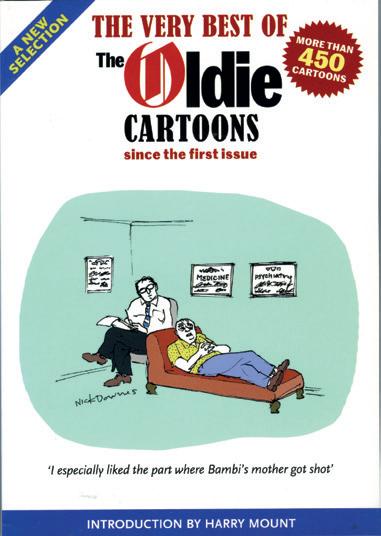


WHEN YOU TAKE OUT (OR GIVE) A 12-ISSUE SUBSCRIPTION FOR £49.50* SAVE £13.50 over 12 issues
* Books for UK addresses only Europe/Eire: £58; USA/Canada:£70; Rest of world: £69
To order your subscription(s), either go to www.subscription.co.uk/ oldie/o ers or call 01858 438791, or write to Freepost RUER–BEKE–ZAXE, Oldie Publications Ltd, Tower House, Sovereign Park, Market Harborough LE16 9EF with your credit-card details and all the addresses. Always quote code POLD0923
This o er expires 30th September 2023. Subscriptions cannot start later than with the October issue
Smoking’s hotter than vaping
Cigarettes are lethal but cool – vapes are just vapid, says Richard Howells
In one of the best smoking scenes in English literature, Charles Ryder and Julia Flyte are motoring to Brideshead. Julia is behind the wheel of her open-topped car and nods towards a box of cigarettes: ‘Light one for me, will you?’
‘As I took the cigarette from my lips and put it in hers,’ writes Charles, ‘I caught a thin bat’s squeak of sexuality, inaudible to any but me.’
But, of course, we all heard it. Imagine for a moment that, instead of lighting her cigarette, Charles had offered Lady Julia a pull on his vape. Things would have turned out so very differently. Why? Because vaping can never be cool. Smoking, on the other hand ...
Smoking, for all we know about it today, used to have a place not only in literature but also in film, photography and public life. It was usually a stylish one, and one that had narrative and symbolic potential.
Film-makers understood this. Take Now, Voyager (1942): Charlotte (Bette Davis) and Jerry (Paul Henreid) have just made an emotionally constrained deal about their romantic future.

‘Shall we smoke on it?’ asks Henreid. The music wells (along with Davis’s eyes) as she delivers the famous closing line: ‘Don’t let’s ask for the moon; we have the stars.’
What the bare dialogue doesn’t reveal is that, between the two spoken lines, there are more than 30 seconds of distinctly smoky, visual storytelling: the offering of the silver cigarette box, the lighting of two cigarettes in (again) one mouth, the click of the lighter, the flash of the flame, the exchange of exquisitely art-directed smoke. Sound and vision combine; sentiment, cinema and cigarettes.
Actors know (or at least knew) about the craft of smoking as ‘business’ on stage and screen. It’s not just a part of narrative and timing, but also of character – what different people
smoke and how they smoke it: seductively, needfully, angrily, resignedly, classily (even). And, when they have finished, how do they stub it out – or even dismissively throw it away? Try that with a vape.
And what about the style of the cigarettes themselves? Think of James Bond and his custom-made Morland & Co cigarettes with the three gold bands.
Pipes send out different signals: solid, avuncular, affable, thoughtful. Take Sherlock Holmes and his trademark calabash, put to contemplative use in The Red-Headed League (1891).
That, declares Holmes, ‘is quite the three-pipe problem and I beg that you won’t speak to me for 50 minutes’. That’s 50 minutes – not just of smoking but also filling, tamping, lighting, re-lighting...
Ah, yes! The paraphernalia of smoking. Who ever heard of a ‘vaping jacket’?
For Joseph Conrad’s narrator Charles Marlow in Heart of Darkness (1899), it was cigars. ‘Perhaps it would be after dinner, on a verandah draped in motionless foliage and crowned with flowers, in the deep dusk speckled by
fiery cigar ends.’ We can see the cane chairs, feel the stillness and smell the cigars.
Cigars speak differently than pipes. They share the need for leisure, but signal success, wealth and sometimes celebration. Give that man a cigar! But never a vape.
Think of a French intellectual and it is hard not to think of a smoker. Roland Barthes understood the symbolic value of signs, symbols and visual images, and frequently posed for photographs with a smoke in hand: a ‘semiotics of smoking’, if you like.
You do not have to be French to understand this – as Harold Wilson certainly did. Like any good actor, he knew the power of a prop. The late Labour Prime Minister and his pipe were seemingly inseparable in public (even though it was both rumoured and denied that in private he favoured cigarettes and even cigars).
In Ruskin Spear’s portrait of Wilson in the National Portrait Gallery, the pipe is supreme, in the process of being lit, with quantities of obscuring smoke between the politician and the viewer.
For Churchill, the cigar was the thing, signifying confident Tory leadership and old-school values.
Look for a photograph of Churchill with a cigar and you will be spoiled for choice. Read about his iconic photograph by Karsh and the mythology is all about the cigar that was not there.
It would be hard to find a mainstream politician today who would be happy to be photographed smoking, but harder still to catch one vaping. Not even Nigel Farage.
We know now that smoking tobacco is extremely bad for both smokers and the people around them. But there once was a time when at least the act of smoking could be performed with style. Vaping is a utilitarian, electronic delivery-system based not on pleasure but purely on the need for nicotine.
That can never be stylish – or cool.
32 The Oldie September 2023
PHOTO 12
Smouldering: Paul Henreid and Bette Davis in Now, Voyager (1942)

Man on the run
Sixty years after the Great Train Robbery, Duncan Campbell remembers Ronnie Biggs – and other crooks who went AWOL
Ever wanted to disappear? Just slip out of the house one day and start a new life in a new place with a new identity?
How easy is it? A bunch of new books by or about people who have been ‘on the run’, sometimes for decades, are full of tips – and warnings – about how to vanish.
It’s 60 years since the Great Train Robbery took place on 8th August 1963.
It led to the arrest of a dozen or so suspects and the jailing of some of them for 30 years. Those long sentences would prompt the robbers still at large to flee and others to escape from prison and disappear.
The mastermind, Bruce Reynolds, fled to Mexico with his wife, Frances, and young son, Nick. The latter, now a musician with the Alabama 3, has produced an audio book, Fugitive! On the Run with Britain’s Most Wanted, which recounts his and others’ experiences of a life in hiding.
As a little boy, Nick thought his father must be a secret agent – which seemed to explain to him why name changes were necessary. Even when the family returned to England, still on the run, he reckoned the large number of detectives who finally came to arrest his dad in Torquay must surely be colleagues and he was puzzled when they took him away.
Ronnie Biggs escaped from Wandsworth Prison in 1965, headed to Paris, had plastic surgery to change his appearance and made it to Australia.
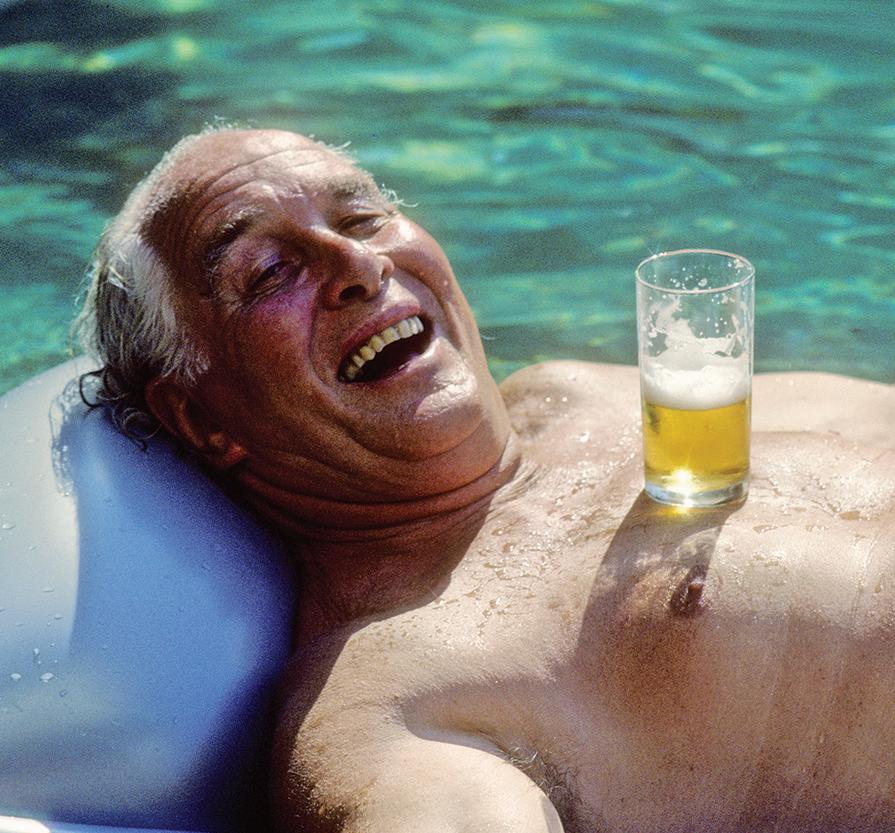
When his cover was blown there, he fled to Brazil in 1970 where he fathered a son, Michael, with his girlfriend, Raimunda, meaning he couldn’t be extradited. He told his tale in The Great Train Robbery, written with Chris Pickard, which has just been republished. Biggs would have stayed there happily for the rest of his life had ill health not intervened.
As he said, ‘If I’m to become a dribbling nuisance, one of Her Majesty’s hostelries might be just the place to spend
my twilight years.’ He duly returned in 2001 after suffering strokes and spent the next eight years behind bars before being released and dying in 2013.
In their book, A Million Ways to Stay on the Run, Donal MacIntyre and Karl Howman tell the story of Kenneth Noye, who was acquitted of killing the undercover detective John Fordham.
In 1996, Noye was a wanted man for the road-rage murder of Stephen Cameron. He made it out of the country and into France, Morocco, the Ivory Coast and Cuba before the law finally caught up with him in Barbate in southern Spain. He spent the next 21 years behind bars in England.
Tony Sales, author of The Big Con, was a very active fraudster, who was about to go on trial but went on the run instead and created hundreds of new identities. Six years later, when he was finally arrested, he found out that if he had just faced the music at the time he would only have got 18 months’ probation. ‘Criminals rarely get away,’ he writes. ‘Happy endings are few and far between.’
But how do you get a new identity? Back in 1971, Freddie Forsyth’s Day of the Jackal (currently being remade as a film with Eddie Redmayne as the Jackal) explained how to scour a graveyard, spot the grave of a child born at roughly the same time as you and apply for a passport in their name.
How do you do it now? Anthony Beard was jailed for six years at Reading Crown Court in March for providing bogus identities to criminals.
He went to homeless hostels and persuaded people with drug and alcohol problems to lend him their identities for £100. He then renewed their expired passports with a photo of a criminal on the run. The fugitive would pay up to £20,000 for the new identity.
But where to go? Spain was the place when the extradition treaty with Britain lapsed in 1978 because of a dispute between the two countries. Dozens of
villains headed for the Costa del Crime. Although the treaty was reinstituted in 1985, it is still a popular place to hide.
Currently the ‘Most Wanted’ list published online by the National Crime Agency shows that all the men they want so badly are in Spain. The previous campaign led to the arrest of 86 offenders, usually after being ratted on by rival criminals. Turkish-occupied Northern Cyprus, which also had no extradition agreement with the UK, and Thailand both became popular hideouts. Does life on the lam pall? Remember Catch Me If You Can, starring Leonardo DiCaprio, about the real-life conman, Frank Abagnale, who had a handful of different identities and bogus professional qualifications.
He told me that, in the end, it was a relief to be arrested: ‘You don’t want to live your whole life looking over your shoulder. Down deep, we all want to get caught eventually.’
Maybe not quite all. More than 170,000 people go ‘missing’ in the UK every year, according to the charity Missing People. Most return or are traced but there are still those – maybe someone reading this article as they sun themselves on a beach far, far away –who are happy to disappear for ever.
34 The Oldie September 2023
SUE CUNNINGHAM PHOTOGRAPHIC
Duncan Campbell was the Guardian’s crime correspondent and LA correspondent
Crime pays: Ronnie Biggs, Brazil, 1990
I love shoehorns, body and sole
Mark Palmer on how to get out of a tight squeeze
We credit Elizabeth I for all sorts of achievements. Turning down Phillip II of Spain’s proposal of marriage in 1559 was astute. Encouraging Sir Francis Drake and Sir Walter Raleigh in their explorations paid dividends.
But so too was recognising the importance of shoehorns – known variously in the past as ‘shoespooners’, ‘shoe schlipps’ and ‘shoe tongues’.
Between 1563 and 1566, Her Majesty ordered 18 of them from her shoemaker, Garrett Johnson, and promptly dispensed them to members of her household who were struggling every morning to put on their boots. Then, three years later, she acquired a further three, made in steel from the blacksmiths Gilbert Polson and Richard Jeffrey.
The shoehorn’s origin goes back further. A ‘schoying horne’ is referred to in literature from the 15th century – and strikes me as a more lyrical and transformative name for such an important piece of kit.

Mind you, until recently, I had entirely overlooked them. Not any more. My collection gets bigger with each passing
year, as bending down to put on a pair of proper lace-ups becomes yet another frustrating burden of old age.
I haven’t quite reached the point where I engrave my shoehorns – as was the habit a few hundred years ago. The inscription on one reads: ‘This is Ambres Bvckells shoeing horne made by Robart Mindvm Anno Domini 1598.’ But I am becoming something of a collector.
My current favourite – which hangs by the front door ready to help out at any time of the day or night – is made from spruce and was bought in Norway at an arts and crafts shop within the Vest orden region.
It’s a beauty, smooth throughout, thin at the top and then widening into the all-important spoon shape at the bottom. It cost me around £20.
Originally, shoehorns were made from animal horns or glass; luxury ones fashioned from ivory, shell, silver or bone. Strictly on cost grounds, I have several plastic ones – but don’t like any of them. You can get two-foot-long ones for less than a fiver with the Timpson name on them: I’ve always had a soft spot for Mr Timpson because he employs
those who have spent time in prison.
The longer a shoehorn, the easier it is to use. A four- or five-foot job needs no bending down at all – and I have seen some retractable shoehorns, which strike me as pointless. A proper, long shoehorn deserves to stand tall in amongst a stack of walking sticks.
Shoehorning has of course become a modern term, suggesting a degree of coercion or pressure to fit into or deal with a tight situation. I dare say one can be shoehorned into a shoebox of a flat or some such.
A Dutchman called Martien Tuithof is the current Guinness Book of Records champion when it comes to shoehorn collectors. He has amassed nearly 1,600 since 1977. They now reside in the Zijper museum in Schagerbrug.
Through my work, I get to stay in quite a few fancy hotels and the first thing I do is seek out a shoehorn loitering in a drawer. The temptation to squirrel a nice one away along with the single-use conditioner is becoming hard to resist.
Mark Palmer is Travel Editor of the Daily Mail


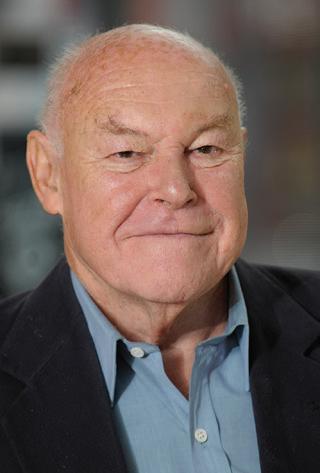
The Oldie September 2023 35
Literary
17th October 2023 At the National Liberal Club, 1 Whitehall Place, London SW1A 2HE TO BOOK TICKETS email reservations@theoldie.co.uk or call Katherine on 01225 427311 (Mon-Fri 9.30am-3pm). The price is £79 for a three-course lunch including wine or soft drinks ● Fish and vegetarian options available on advance request ● Meet the speakers from 12 noon; lunch at 1pm ● Authors speak 2.30pm Forthcoming dates at the National Liberal Club: 14th Nov, 12th Dec Timothy West
Don
Simon
Sing as we goBritain
the Wars NEIL SPENCE Sponsored by
Lunch
on Pru and Me
McCullin on Journeys Across Roman Asia Minor
He er on
Between

The strange death of tolerance
Over the last generation, free speech has taken a battering a n wilson
The silly donkeys at Coutts got their just deserts in the Nigel Farage affair.
A few grossly overpaid execs stood down, and they will no doubt move on to even more overpaid positions. The irrepressibly perky Farage will feel he has won a great victory for freedom of expression and freedom of thought. But he hasn’t really.
Someone who got much less publicity than Farage was the Rev Richard Fothergill, 62, who had been investing his modest savings with the Yorkshire Building Society for 17 years.
In the modern way, the building society asked their clients for ‘feedback’. Mr Fothergill, being a conscientious chap, provided some.
It was ‘Pride’ month, and this conservative-minded clergyman said he did not agree with the building society’s relentless promotion of trans and gay ideology. He took the old-fashioned –and now utterly unallowable – view that homosexual activity is forbidden by the Christian religion.
They closed his account, pompously announcing they have a ‘zero tolerance approach to discrimination’ and that their relationship had ‘irrevocably broken down’.
‘I wasn’t even aware that our relationship had a problem,’ said the baffled cleric. ‘They are a financial house – they are not there to do social engineering.’
The key phrase is ‘zero tolerance’. These two words define the atmosphere of the age. Some young commentators occasionally express gratitude that they live in an age which is more tolerant than the one in which we oldies grew up.
They point to the fact that we no longer discriminate against people for being gay, trans, Jamaican, disabled, fat or indeed all five things at once. Hooray.
The trouble with this optimistic view of things is that it overlooks the
atmosphere created by the phrase ‘zero tolerance’.
Any person whose views differ from those of the ‘liberal’ consensus – about sex, abortion, Brexit or racial politics –can no longer debate their point of view. They must simply shut up or be punished.
The career of Kathleen Stock shows that zero tolerance can, on occasion, have truly sinister implications. Here is an obviously liberal-minded, decent, intelligent academic philosopher who was not, as it happens, hostile to transsexuals. But she had the temerity to question whether ‘identifying’ as a certain category of person automatically made you into that person.

I suspect that 99 per cent of reasoning people would agree with Stock. Merely to ‘identify’ as a woman does not make you a woman, any more than ‘identifying’ as Napoleon – or a fried egg – makes you into the phenomenon denoted.
The result of her simple Aristotelian distinction? She lost her job. Her colleagues were not brave enough to defend her. When she addressed the Oxford Union, there was a baying mob.
Zero tolerance is the rule of our day. Rose Hudson-Wilkin, the ludicrously self-important Suffragan Bishop of Dover, has moved that the Church of England’s Liliputian parliament, the General Synod, revoke its agreement to the clergy and parishes who do not want to have women priests.
Those priests only represent a tiny proportion of the national church –though, as it happens, their views coincide with the great majority of the Christians in the world who belong to the Orthodox and Roman Catholic churches – namely that women cannot be priests. Bishop Hudson-Wilkin is offended by their viewpoint – so they should be silenced or driven out.
The point isn’t whether they are right
or wrong, any more than whether Farage is right about Brexit, or Stock about the transsexuals. It is whether one is nowadays allowed to have views that depart from the Liberal Elite Agenda. Clearly, one isn’t allowed to dissent. The zero tolerance of current liberal opinion is in its way as relentless and unforgiving as the Spanish Inquisition. In universities, colleges and the BBC and even in the ‘Right-wing’ journals and newspapers, it’s foolhardy to risk dissent.
There was recently a solemn documentary on television presented by David Harewood, the first actor of colour to play Othello. He turned his attention to a dead boring programme of yesteryear called The Black and White Minstrel Show, in which choruses of white men in black greasepaint sang numbers such as Tulips from Amsterdam and Sing Something Simple.
I remember, as a child, asking my telly-addicted parents why the minstrels painted their faces and was told they were imitating a famous American performer called Al Jolson.
This drivel was watched by millions of viewers before there were many –in most areas ANY – people of colour living in Britain. Once we became a mixed society, the programme died a death and it became no more than an embarrassing memory.
In the Harewood version of events, the programme was a sinister engine of authority, designed to engender racism in the minds of the millions. A possible truth but – this is my point – anyone who dared to question this would immediately find themselves in the Naughty Corner with David Starkey and the late and much-lamented Roger Scruton. It’s safer not to ‘go there’.
Do we want to live in a society where dissent is simply not allowed? And whether we do or don’t, do we really live in a more tolerant age than our parents?
Oldie Man of Letters
The Oldie September 2023 37
History
Fear and loathing in Mesopotamia
david horspool
In these sensitive times, when hurt feelings can start a witch hunt and end careers, it’s no surprise that historians have come over all emotional.
There are centres for the study of the history of emotions in London, Berlin and across Australia and the United States. Historians in France and Sweden research the emotions of the Middle Ages and ‘pre-modernity’.
In 2015, the British historian Thomas Dixon re-examined our island story through a misty lens, in his book Weeping Britannia
A new book by the New York-based historian Robert Peckham takes a single emotion and uses it to frame ‘An alternative history of the world’: fear.
He takes us from the terrifying march of mortality of the 14th-century Black Death, via the religious fears of the Reformation and the perverting of popular revolution in France into an instrument of Terror, through ‘Death Camps and Dictators’, to arrive, hearts racing and blood pressure through the roof, pretty much back where we began, with ‘Pandemic and the Rule of Fear’.
It’s a persuasive thesis – if a depressing one. For all that, Professor Peckham is at pains to argue that ‘the history of fear… is more hopeful than many accounts would have us believe.’
His history of fear could be extended much further back, beyond his nominal starting point of the late Middle Ages. He mentions Thucydides’s reason for the Peloponnesian War – it was motivated by Spartan fears of Athenian power.
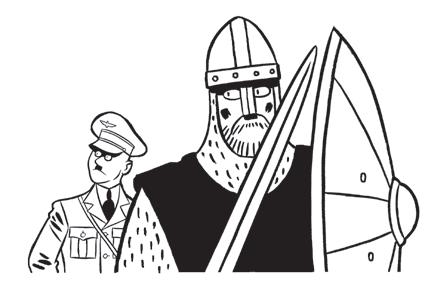
A visit to the British Museum reminds us that, for a very long time and across the whole world, most cultures have had fear very close to their foundations.
Those massive statues of Egyptian gods or the colossal, winged lions of Ashurnasirpal (pictured) from 9thcentury BC Nimrud in Mesopotamia were not intended to cheer you up.

From the kifwebe masks of the Congo to all those Chinese dragons, making us afraid has been the aim of monarchs, governments and religions.
A return to the solid world of objects is a reminder that the previous fashion in history, before these histories of fear, lying, curiosity and crying, was for the history of – and through – things.
The British Museum and its ex-director Neil MacGregor are the fons et origo of this turn, with the smash-hit History of the World in 100 Objects.
There have been other popularisers, most notably the American writer Mark Kurlansky, who has told global history through salt, cod, paper and milk, and the history of New York through the story of the oyster. Even this pioneer of objecthistory has been seduced by the fashion for intangibility, though, publishing Non-Violence: the History of a Dangerous Idea (in ‘25 lessons’) in 2006.
What’s behind the shift in historical fashion towards emotion and the intangible? It’s related to the everwidening scope of historical enquiry in general, which really begins with the rise of social history from the 19th century. Once you begin to focus more on ‘ordinary’ people, who do not stand out for their individual achievements or exalted (though often unearned) place in society, you are naturally drawn to expand the areas of their lives you’re interested in.
There are only so many times you can count how much money they earned, children they had and lost, or houses they lived in. It is natural to wonder what their
experiences felt like, and to begin to think about ways of finding out that don’t simply impose outsiders’ views. Paradoxically, if there aren’t first-hand accounts of such experiences, the historian of emotions will be drawn back to objects: the treasured piece of tableware, the links of an enslaved person’s chain, the clothing and furniture. In that way, the history of the intangible becomes tangible once more.
Since all history cannot help being contemporary history (we don’t write it in a vacuum), there are good, present-day reasons, too, for historians getting emotional.
Although by any measure the previous century was, in aggregate, more traumatic than this one, it is in the 21st century that researchers, and the public, have really begun to understand the nature, depth and heritability of trauma. We really can feel our ancestor’s pain.
Whether such negative emotions –anger, fear, hatred – leave a greater mark than happier ones is difficult to say. But, to judge by the subjects of history books on the emotions, which skew towards the gloomy, it certainly looks that way.
Both developments – the emotional and the ‘objective’ – are reminders that history is always being reframed; constantly being rewritten even.
Fear may not explain the whole of human history, any more than cod or milk or even the British Museum’s top 100 do. But it can certainly make us think about that history again.
That is what historians are for.
Fear: An Alternative History of the World (Profile) by Robert Peckham is out on 7th September
38 The Oldie September 2023
For 3,000 years, monarchs and governments have tried to terrify us
PETER HORREE / ALAMY
Human-faced lion, Nimrud palace, 9th century BC

Town Mouse

A love letter to Brutalist tower blocks tom hodgkinson
sheer number of buildings in the book. There are 260 – which gives you an idea of the speed of the post-war building boom.
For each building, he gives a crisp commentary. He describes the extension to the Mayfield School in Putney as ‘one of the best modern buildings in Britain’. He adds, ‘If the book had to consist of one building, I think it might be this for its burning humanity.’
Another favourite is the Golden Lane estate near the Barbican, finished in 1982, by architects Chamberlin, Powell and Bonn. While Nairn concedes that ‘the stained balconies and stairwells are very depressing’, he reckons that the ‘landscape and townscape ideas are first rate’. Golden Lane has indeed stood the test of time, with residents still loving it.
It has a swimming pool, gym and tennis courts and, says one happy resident, ‘No one leaves Golden Lane estate unless they die.’
Nairn also quite likes the tower block on Berwick Street in Soho. I remember visiting Jeffrey Bernard there in the Nineties, and enjoying the view from his 12th-floor flat. Bernard had only one leg and so didn’t see the view much, being largely confined to the sofa.
Nairn says, ‘Not a great building, but worth seeing to understand how quite a tall block can be fitted into a crowded bit of Soho without breaking it open too far.’
Mrs Mouse and I were recently invited to dinner by friends who live in Rowley Way. It’s a curious street in north London, next to Abbey Road – as in the album by the Beatles.
Rowley Way is the unofficial name for the Alexandra and Ainsworth Estate, a housing scheme of 520 flats and houses built in 1978 by the architect Neave Brown.
Now, like many Oldie readers, I am guessing, I have an in-built prejudice against modern, Brutalist buildings.
My favoured architectural styles are 18th and 19th century and medieval. I’d like to live in Dr Johnson’s house or a medieval manor. I actually do live in a Victorian terrace in west London, with cornices and open fires. It’s great, and very neighbourly.
My friend’s flat has done a lot to disabuse me of my King Charles-ish attitudes to the buildings of the 1960s and 1970s. Rowley Way is actually quite a beautiful and elegant development: leafy, low-rise, spacious, car-free and with its own community centre.
It was utopian in its conception. Brown wanted pleasant, affordable council housing and saw the estate as a reinvention of the Victorian terrace.
It’s now listed, and around half the properties are on the open market.
Architects love it, and so do the residents. Architectural historian Mark Swenarton described it as ‘the most architecturally celebrated housing scheme built in Britain in the last half-century’.
Resident Sara Bell told the Guardian, ‘It makes me smile every day. I’ve always loved it. My kids could play out on the car-free street when they were growing up, and it’s such a sociable place to live. We formed a co-operative and redid the park, and we even make our own honey.’
While pondering Rowley Way and the modern block of flats, a reissue of a classic study by architecture critic Ian Nairn called Modern Buildings in London landed on my desk.
Nairn (1930-83) made TV programmes on architecture, wrote for the Observer, and is the author of classics such as Nairn’s Towns, Nairn’s London and Nairn’s Paris. He wrote the Pevsner guide to West Sussex, too. Fond of beer, he died in 1983, aged only 52.
Modern Buildings in London was published in 1964. So it predates Rowley Way but I think Nairn would have loved it. The first thing that strikes you is the
The block of modern flats next to St James’s Palace works well, too, he says. ‘It is a masterpiece, and it could so easily have been a disaster.’
He really hates other buildings. The United States Embassy in Grosvenor Square, which has just been redeveloped, is described as ‘pompous and tragic’.
Looking at various new structures east of St Paul’s, he complains about the ‘grinding Neo-Georgian horror of the Bank of London & South America, 40 Queen Victoria Street, EC4, one of the deadest buildings in the whole of London’.
Now I’ve read the book, my cycle routes around London town have been greatly enriched. I now notice modern buildings and realise that some are great, some not so.
Some would make very pleasant retirement homes for oldies. I’ve long dreamed of living in a flat in the Barbican.

So, thank you, Ian Nairn and Rowley Way, for ridding me of my ridiculous prejudice.
Modern Buildings in London (Notting Hill Editions, £15.99) by Ian Nairn is out on 5th September
40 The Oldie September 2023
Country Mouse
A wolf among sheeple on my night flight
giles wood
How long will it be before overweight airline customers like me will be weighed along with their luggage and compelled to pay for two seats on budget airlines?
The sardine-can-like conditions of my short-haul aisle seat from Klagenfurt to Stansted seemed worse than usual, owing to my recent fondness for breakfast croissants with black-cherry compote, a balm in troubled times.
It meant, as part of a cohort of other overweight Britons, that I hardly had room to fold down my tray for my warm gin and tonic without ice.
There wasn’t any of the latter on our ‘no frills’, two-hours-delayed night fright. Or have I spelt that wrong?
My editor was sat – to use common parlance – on the opposite aisle seat and, being taller than the average Briton, his legs struggled to find repose as the passenger in front had put hand luggage under her seat.
As he dozed off, his restless left leg found blessed relief in the narrow passageway used by unsupervised toddlers, toilet-seekers and cabin crew.
With lightning and thunderclaps without the fuselage of the plane, I took it upon myself to act as a watchman to warn oncomers that an obstacle –namely Harry’s boot – posed a fresh trip hazard.
Mimicking the hand gestures of the cabin crew’s pre-flight safety demonstrations, I distracted myself from the oppression of the claustrophobic conditions and the turbulence of the flight.
Leaning outwards from my aisle seat, if anyone approached, I grabbed their attention by first waving my arm, index finger pointing up, then raising my elbow and theatrically rotating my index finger downwards in the direction of the clear and present danger of Mr Mount’s protruding boot.
It worked well throughout the flight so that my editor could doze without interruption. It worked well for me too as it reconnected me with my former Wolf Cub persona and my vows to do my duty to my country and to the Queen.
Meanwhile, no member of the cabin crew intervened to tap my editor politely but firmly on the shoulder to request that he reallocate the offending left leg into a ‘safe space’.
Voltaire famously observed that ‘common sense is not so common’, yet it used to be a hallmark of our national character.
This summer, however, just like brown furniture in modern homes, it seems to be in short supply.
The Silly Season started early this year. It was only May when Mary and I attended a litfest in the Cotswolds, where we were promoting our new book. To our astonishment, we were ushered onto a stage in the centre of a circular, opensided bell tent, with hay bales as seating, all around the perimeter – which meant we had our back to half the audience.
Our bell tent was positioned only a few yards away from a stage, where there blared, at full volume, a local amateur
rock band giving it their all. I asked Mary whether, in my capacity as a Leader of Men, it was my public-spirited duty to bring this anomaly to the attention of the event manager.
She shut me down, accusing me of drinking too much coffee. We went on to suffer a less than satisfactory auditory experience, characterised by frowns and ear-cupping from the audience.
Where was the patrician, ex-military leader, whose training in emergencies and man management could have equipped him to take charge and bring a sense of order to a civilian situation in need of it? Absent, for sure, from that particular event in the Cotswolds.
But British Common Sense can resurface in the oddest places.

Awaiting the return flight from Klagenfurt airport, one of our houseparty exuded a natural sense of authority just by his appearance. At six foot five and with a shock of silver hair kept in place by a pair of black, horn-rimmed spectacles, this octogenarian glared like an eagle at everything that was going on around him. This was his first experience of a budget no-frills flight and he was clearly finding it wanting.
No slouch, despite his advanced age, on the technical front, this close relation of the founder of the SAS was not one of the ‘sheeple’. That’s a term used by conspiracy theorists in describing the supine way humans comply and cave in to authoritarian political systems.
Unlike the sheeple, who were content to mill around waiting for scant information on our two-hours-delayed flight, he used a flight-tracker app to pinpoint the awaited aircraft’s position, which happened to be still over France despite the order for passengers to queue at the departure gate, as boarding was ‘about to commence’.

The golden moments pass and leave no trace, according to Chekhov, but I will savour the moment this distinguished gent challenged the Ryanair staff to explain, why oh why, we were being herded from our comfortable bar, with ample seating and access to drinks and ham-and-cheese baps, to stand in a no-frills makeshift container on the edge of the landing strip for a full hour before we could conceivably embark onto the aircraft.
And yet the sheeple were still prepared to comply when the flight attendant admitted he was right but, ‘We always do it this way.’
‘He loved his video games’
Power to his elbow, he is a wolf among sheep. But, along with common sense, his vintage of Britons is in diminishing supply.
The Oldie September 2023 41
A stitch in time saves millions

Two French ideas are worth copying.
One is that cash is categorised as legal tender, and payment in readies cannot be refused: no signs in shops saying, ‘card payment only’. The abolition of cash not only means the banks control our lives (and can therefore ‘de-bank’ us if they choose, as in the Nigel Farage case).
The disappearance of cash is also unfair to the poor, to charities and to those whose livelihood is helped by tips, and by grandparents who enjoy the pleasure of slipping a grandchild a tenner – somehow more spontaneous than a financial transfer.
And who doesn’t derive a small glow of virtue in dropping a couple of coins into a busker’s mendicant cap?
The second admirable measure of President Macron’s administration is to make a commitment to the practice of repairing clothes rather than chucking them away.
Because France currently discards 700,000 tonnes of clothes a year, the ecology minister has promised that government financial reimbursements for repairing – rather than binning – older clothes will be available from October.
My town, Deal in Kent (the second most desirable English seaside town, according to a recent survey), already has an excellent clothes repair service, called ‘A Stitch in Time’.
Margaret, our seamstress, shortens, lengthens, expands, takes in, renews and repairs all garments brought to her, applying quite modest charges.
Every town should have an appointed seamstress (or seamster). I feel sure King Charles, who extols mending and repairing, would endorse the concept.
Sir Keir Starmer, when he becomes prime minister – imminently expected
– plans to expand the skills of young people by offering them a course in ‘oracy’. School pupils are to be taught to speak articulately, to improve their chances of getting on in life. Jolly good idea, even if it does slightly smack of reinventing the wheel.
When I was a schoolgirl, in the far-off 1950s, we had a weekly session called ‘elocution’. During this period, Miss Ena Bourke, a formidable Dublin spinster, would teach us to stand up, speak up and perfect our DICTION.
‘Every word you enounce,’ said Miss Ena Bourke, ‘should be heard clearly by whosoever is listening to you. Do not ELIDE your sentences, girls.
‘PRONOUNCE your words properly – I want to hear that epiglottis doing what it was made to do. Practice – “She sells seashells on the seashore!” Do not GABBLE.’
How often have I thought nostalgically of Miss Ena Bourke and her endeavours. She sallied forth into inner-city schools, as well as into genteel convents, where she exhorted a, shall we say, more proletarian demographic to exercise CORRECT DICTION.
But then it came about that elocution was dismissed as a waste of curriculum time and, moreover, something rather snobbish.
So, it disappeared. And speech came to include the ellisions, the gabblings, the mutterings and mumblings that are now part of everyday communication (especially to those of us whose hearing is not what it was).
When Margaret Thatcher took elocution lessons to improve her speech, some regarded this as pretentious and social climbing.
So, bravo to Sir Keir for reversing that notion, and recognising that CLEAR DICTION and ARTICULATE
PRONUNCIATION are an asset in any young person’s education.
Immigration is often seen as problematic, and accommodating new populations is a challenge. Yet sometimes the influence of immigrants can be unexpected.

Britain is an increasingly secular society, but London is one of the most religious parts of the United Kingdom – because its immigrant population tends to be more religious. Ireland has a high percentage of immigrants – 20 per cent of the population were born outside the country.
For years, secular campaigners have sought to silence the Angelus being relayed by RTE TV and radio, calling it an outdated relic of bygone Catholic Ireland.
But every time the national broadcaster does the market research, they find the Angelus is popular –Muslims in Ireland are often particularly appreciative. And so, a renewed set of Angelus films and bell-ringing were launched over the summer airwaves. Ecumenism has many faces.
Authors today are supposed to carry out speaking engagements, appear at writers’ festivals and promote themselves publicly.
Some enjoy these events – The Oldie’s lunchtime speakers always have great fun. But some have blanched at the prospect. My late sister worked for the BBC in New York, and I have just found, among her correspondence, a message to that effect from the late John Updike.
In 1970, the BBC sent a flattering letter to the famous American novelist, asking him to be part of an important forthcoming broadcast series on the future of religion. Updike was a Dutch Calvinist, despite his novelistic themes of sexy romps.
‘Thank you for your kind invitation,’ he replied. ‘But, in an attempt to purge myself of evil humours, I have renounced all speaking engagements, interviews, symposia and other modes of self-display.’
How very quaint!
TOBY MORISON Postcards from the Edge
President Macron’s plan to help seamstresses is a brilliant idea, says Mary Kenny
42 The Oldie September 2023

Did Himmler’s masseur change history?
Massage relaxes almost everyone – even Nazi monsters
It is almost always sensually pleasurable and stress-relieving to be tampered with while unclothed.
When the opportunity arises, and if we can afford it, I’m often tempted to have a massage – a treat or spa massage as opposed to a medical massage.
But spa massages should not be viewed as self-indulgent or time-wasting. On the contrary. They often send us into a profound, deeply relaxing daytime sleep. To quote the late guru Betty Parsons, ‘You are never wasting time when you are recharging your batteries.’
It’s so pleasant to feel the touch of another human’s hands on your skin.
Radio Four’s Inside Health programme once looked into the phenomenon of tickling therapy. Was it to be the Next Big Thing? We heard testimonies from converts who declared that various conditions such as polymyalgia and arthritis had been dramatically improved by tickling therapy.
Sadly the medical expert on board declined to give tickling any credibility. It was more that some people, living alone, never experienced any human touch at all. So touch-deprived patients had confused the happiness-inducing experience of being tickled with an improvement to their medical condition.

Some masseurs have more of a knack than others. You can tell with one touch if they have ‘healing’ hands: the force is with them. Other masseurs are frustratingly limp-wristed or, worse, their touch is clammy.
Whatever the quality of touch, don’t make the mistake of chatting to the masseur. They may not stop. Having to stay fully conscious and chat away will prevent you from blissing out.
Most masseurs know it is unprofessional to chat to the client. One man I know found there was something about him that seemed to prompt outpourings whichever salon he visited.
In despair, he ended by going to a salon where no one except the receptionist spoke English.
The tragedy of wonderful massages is that they tend to end after an hour. Then you hear the dread words ‘I’ll leave you now to get dressed when you are ready.’ What they really mean is ‘as quickly as you can’ because there is another client waiting to occupy the space.
At the Hôtel Royal in Évian, when the massage session ends, you are led in your towelling robe to a sun terrace and tucked up on a padded lounger, so that you can sleep a couple of hours away in your altered state.
Enough of treat massages. Some masseurs are required to put right the likes of acute back pain and musculoskeletal sports injuries. One of these was Felix Kersten (1898-1960), a controversial Finnish masseur, with premises in Berlin and the Hague. His training came from a Chinese doctor who taught him how to leave his own body and enter the body of the patient and to make his diagnosis through the fingertips.
His miraculous ability to restore function to the agonised drew him, unfortunately, to the attention of Reichsführer-SS Heinrich Himmler.
In The Man with Miraculous Hands, author Joseph Kessel alleges that Kersten, a natural opponent of Nazi ideology, used his power over Himmler to save 60,000 lives by his ability to influence policy.
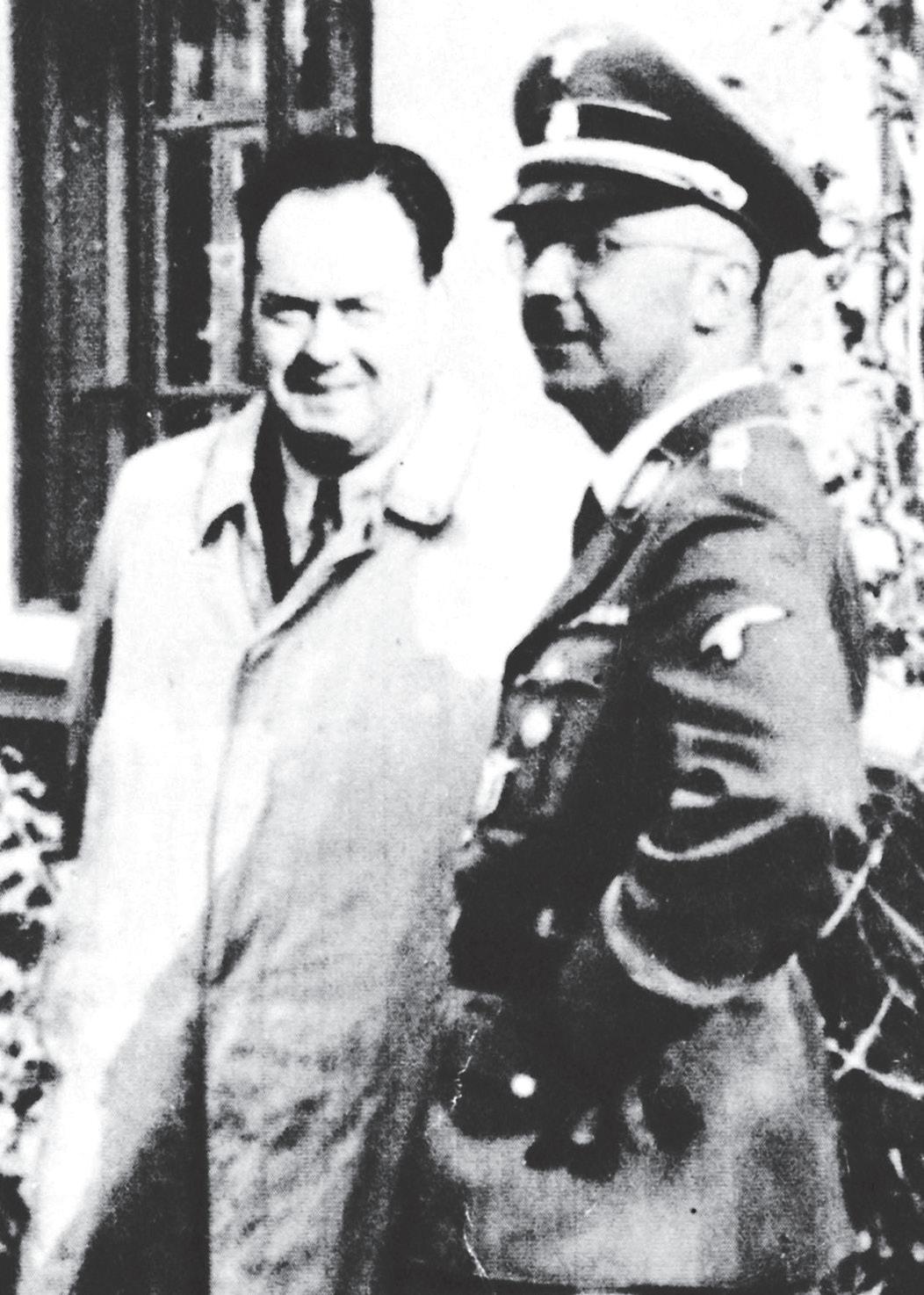
Himmler’s agonising stomach pains (embarrassing for someone claiming to be a healthy specimen of the Aryan elite) could only be relieved by Kersten’s magic touch. Kersten, it is claimed, was forced to take the job as Himmler’s full-time medic.
He allegedly went to the Finnish embassy and asked to be repatriated. But the diplomats begged him to stay in Berlin so he could report on any war secrets Himmler might blab during
the ecstasy of his blessed relief from the agony.
Kersten said his power over the Nazi leader meant he had been instrumental in saving the Dutch Jewry after Hitler had charged Himmler with deporting them to Poland.
Kersten told the contorted, waxenfaced Himmler he would be unable to treat him successfully as the challenge of arranging this chore on top of expanding the Wehrmacht from 100,000 to one million soldiers, would be too much for his nervous system to bear. The massages would no longer be effective.
War historians claim this was never a plan. However, Kersten did act as a significant broker to allow the release of certain high-level prisoners.
The story is about to be made into a film, with Woody Harrelson playing Kersten. I will be looking for sensual relief by proxy when watching Harrelson going about his business on screen.
Harrelson is a good actor but I wonder if he will have the magic touch.
Mary Killen’s Beauty Tips
44 The Oldie September 2023
Miracle hands: Kersten and Himmler, 1944
Small World Barbecue from Hell
What’s on the menu? Buckfast, Benson & Hedges – and my fatty liver
jem clarke
Jem Clarke is in his very, very early fifties, is five foot zero inches tall and has never left the family home in Cleethorpes, which he shares with his parents…
I have enough trouble with my selfesteem without my doctor fat-shaming my individual organs.
I have also been spending more time in the company of the local brassy bar-flirt, Ramona.
My mother is indifferent about my imminent organ failure, but has a killer bee in her bonnet over Ramona, claiming, ‘If you lay down with a dog, you’ll get fleas.’ So unfair – Ramona has been flea-free since she was rehoused.
Ramona’s morning breath may be contributing to the enlargement of my teetotal liver. There has been no carnality yet. She simply meets me for liquid brunch at 11. From the chaste kiss she plants on my cheek, I get a full-bodied blast of Buckfast, with delightful notes of Benson & Hedges.
She has started inviting me as her ‘plus one’ to the season’s social events. In fact, I’m part of a ‘plus two’ or a ‘plus three’. She always invites a man to accompany her. When she’s drunk, she forgets and asks another.
I spent an unforgettable evening at Ramona’s nephew Kelsey’s ‘Tag Coming-Off’ party as a foursome with Ramona, a Somalian sous-chef and a young guerilla-tattooist.
The party came to a grinding halt after just half an hour, when Kelsey hacked his tag off, leapt over a wall and headed into town.
Ramona then asked me – alone, she said – to attend her father’s annual barbecue at his house in the country.

Was Ramona the black sheep of a well-heeled family? Alas, no. There was a small council housing estate in the countryside where they put families evicted from town for antisocial behaviour.
She did attempt to reassure me: ‘Dad’s all right now. More sensible now he’s 60. He’s at that Goldilocks
age, still young enough to run away if the alarm goes off, but old enough to stop resisting when the dog’s on your ankles.’
At the barbecue, Ramona, came running over to me, doe-eyed and bangle-rattling, whispering that she had messed up again. She re-introduced me to ‘Danny K’, the tattooist and fight-aficionado. I joked that he could just call me ‘Bing’, as in Crosby. Which he did for the rest of the evening.
Then I met Ramona’s dad. I was expecting a Tyson Fury sort. I was put in front of a man barely taller than me. All sinewy and fat-free, he looked like a shaven whippet on two thin legs.
Once Ramona left us alone, he beckoned me to come closer.
‘I don’t know whether I can tell you or not,’ he whispered. ‘You know the SAS and the SBS, right?’
Luckily, Channel 5 runs an excellent series of entry-level populist war documentaries. I said, in a butch, knowledgeable way, ‘Why, yes, I do!’
‘I was in the SPS – Special Prisoner Service – released from jail with the
promise of reduced time if we went on dirty black op missions.’
‘Ooh, like The Suicide Squad,’ I said, referring to a recent film series.
He grabbed my collar and shouted, ‘Who’s been talking?’
Ramona interrupted: ‘Dad! Put him down, you dick. Eat this chilli dog.’
The brute went from chewing my ear off to chomping the hot dog, nodding towards me, ‘He knows his stuff, this one.’
Danny K was making all the running and Ramona was laughing receptively. Feeling a spare part and noticing that some of the younger member of the family had sourced some air rifles, I made a French exit.
Ramona and Danny K are now an item. I lay prone on my bed. I even confided in my father: ‘I’m having to really resist the urge not to just call.’
‘That sounds like love, son,’ he said. ‘I think you’ve fallen for Ramona.’
‘Ramona?’ I said. ‘I’m trying to resist the urge to call my doctor. He’s left me with this time-bomb liver and no aftercare.’
The Oldie September 2023 45
STEVE WAY



The public-school gift for public speaking
Oracy is all the rage these days. While the newspapers howled at the word, it has been used in schools for as long as I have been teaching. It does not seem to be unreasonable to suggest that our school-leavers should be able to add up and talk clearly.

One of my daughters just sent me a message from her holiday with a family which includes some teenagers. ‘Thank you, mum, for teaching us how to hold a conversation,’ she wrote. ‘We can all talk to anyone. I wish the teenagers here could.’
She compared the difference in articulacy between two of the guests, a 14-year-old public-school boy and another from a state school, two years older.
My children may have been brought up by a single mother and sent to state school, but they can indeed hold their own with anyone. How can this be? Quite simply, they were brought up in a large, extended, discursive, talkative family.
There was such a thing as a table at which we all sat, adults and children, eating and arguing together. When they were tiny, a friend laughed at me, asking why I talked to my toddlers ‘as though
they can understand’. Because, my friend, one day they will do exactly that.
So where do schools come into this? As with so much, the inarticulacy of the young is in large part because of the lack of engagement of the old. Therefore, schools must step in to fill in the gaps from home.
We used to have a ‘speaking and listening’ component to the GCSEs. Students had to give a presentation and take part in a discussion and a drama performance.

However, they disappeared from the qualification, mostly because it was far too easy for school to invent grades to bump up their pupils’ results.
Now there is just one task – a presentation – which has to be passed, but which is given a separate certificate. It is frankly not worth the paper it is printed on.

In the half-term before the summer holidays of Year 10, students prepare and present their talk. One child read out a cookie recipe. Another gave an amazing talk on the fall of the Roman Empire. I could just about (according to the assessment objectives) give the cookie
child a pass, while the Roman Empire boy was an easy distinction. But in neither case will the certificate awarded give any real idea about the students’ abilities.
This is maybe the first time since Year 7 that the children have had to stand up and speak in front of their peers. So, maybe we are doing a disservice to those children who are not used to voicing their opinions at home.
It turns out that public-school children are endlessly encouraged to stand up and speak, whether in debating clubs or assemblies or just in classrooms. At our school, we just don’t.
Even when we do ‘group discussion’ and ‘feedback’, it is always the same children who are prepared to contribute. When it came to the Year 10 oral assessments, many children flatly refused and will have to be chased up next year.
We should do more to help our children’s spoken competence. It is going to cost a lot of money; the only way to make it worthwhile is to have outside examiners come in to assess the children.
Will it happen? Probably not.
Quite Interesting Things about … of fices
The most commonly asked question at Hanna-Barbera’s head o ice is: ‘What did Barney Rubble of The Flintstones do for a living?’
When The O ice rst aired in 2001, it had the secondlowest audience appreciation score on the BBC after women’s bowling.
The Swiss Air Force monitors its airspace round the clock but only
Ricky Gervais in The O ice

intercepts illegal ights during o ice hours.
When he was Chancellor, George Osborne kept a padlock on his o ice fridge.
In the Cabinet O ice at 10 Downing Street, the Prime Minister’s chair is the only one with arms.
Until 1993, the location of the Post O ice Tower was an O icial Secret. It was illegal to photograph it and it didn’t appear on any maps.
Until the First World War, o ices for women had separate entrances and staircases, for reasons of ‘morality’.
The rst woman to run a post o ice in Germany was later burned as a witch.
In 2017, six Chinese o ice workers were punished for dozing o in a meeting about how to motivate lazy bureaucrats.
From 2003 to 2008, the lost property o ice at Madame Tussauds collected 123 pairs of false teeth and a false leg.
The mayor of High Wycombe in Buckinghamshire is weighed each year to see if he’s got fat while in o ice.
The wheeled o ice chair was invented by Charles Darwin. The average wheeled
o ice chair travels about eight miles a year.
The average o ice worker spends 50 minutes a day looking for lost les.
A third of British o ice workers have the same thing for lunch every day.
The last words of Henry Royce, co-founder of Rolls-Royce, were: ‘I wish I’d spent more time in the o ice.’
JOHN LLOYD
222 QI Answers to Your Quite Ingenious Questions is out now

For more on QI, visit qi.com and, on Twitter, @qikipedia


The Oldie September 2023 47
Sophia Waugh: School Days
sister teresa

Green thought in a holy, green shade
Our monastery is fortunate in having a meticulous bursar. Her grasp of the complexities of our finances never fails to impress our professional advisers.
As with all Carmelites, hers is a life of sacrifice. She would far rather be out in the garden, whatever the weather, coaxing the plants she has taken under her care, as opposed to battling with the accounts. Keen on wilding and with green fingers, she is at her happiest planting, transplanting and, very occasionally, weeding. As far as she is concerned, very few plants are weeds at all, though ground elder occasionally goes too far, even for her.
There is an eccentric quality about the way she plants. She is squirrel-like in that she will sow seeds in the ground, forget where she has put them and forget what they are. The results can be spectacular and her wild border by the dustbins would impress any passer-by from the Royal Horticultural Society.
At the moment, she is supervising 30 oak saplings, a generous present from the Woodland Trust. Next year, they are
destined to be planted out in the wild to fend for themselves. When asked why she has voluntarily taken on this strenuous work, she says she does not mind at all that she will never see the saplings become fully mature.
The future remains unknown to us all, but that is no reason for not trying to improve it in any way we can.
The great sadness in her life is the way the planet is being systematically exploited and ruined. Her way of coping
Memorial Service
Donald Trelford was editor of the Observer from 1975 to 1993 – and was also acting editor of The Oldie, when Richard Ingrams took a sabbatical.

with this tragedy is to make sure the tiny patch of the Earth on which she lives should survive and thrive. She regularly counts the local bumblebees, catches (and releases) moths throughout the year because she has come to appreciate their spectacular beauty, however small they may be, and she welcomes destitute hedgehogs, nurturing them until they can be let loose in our fields.
‘Is this what God wants?’ is a phrase that’s voiced all too often in monastic circles and elsewhere. It easily becomes a way of expressing our own desires rather than God’s. God cannot possibly want a great many horrible things that are going on at the moment, not least of which are global warming, pollution, the war in Ukraine and child abuse.
There is a dark side to life but, by tiny and continuously positive acts, we can force a chink of light through the gloom. We may never know the results of our efforts this side of eternity, but our faith assures us that all the good we do will reap for us and others an eternal and heavenly harvest.
Donald Trelford (1937-2023)
or at best lower middle-class provincial backgrounds, the first in their family to go to university – Donald to Cambridge – and both learned their trade on provincial papers. ‘What few realised is that, though professional rivals, they were good friends.’
quickly and fluently, never to greater effect than with his brave scoop of the Matabeleland massacres in Zimbabwe that so infuriated our proprietor Tiny Rowland that he publicly threatened to fire him. Donald didn’t back down.
Former Observer journalist Bob Low led tributes to him at St Bride’s in Fleet Street. He said Trelford’s 18 years in charge at the Observer ‘would be unusual in today’s world, where editors have the life expectancy of football managers – or prime ministers’.
Low said, ‘People often compared him to the Sunday Times editor Harry Evans, with whom he had much in common: both diminutive in stature, from working-class
After Evans’s death in 2020, Donald wrote of him, ‘Maybe because of our size, or lack of it, we were sometimes mistaken for each other. Once, on a railway journey from Sheffield, Tony Benn greeted me as Harry Evans and flatly refused to believe my repeated claims to be myself.’
Low recalled that Trelford was ‘the consummate all-rounder; he could write, edit, and lay out pages: he was never happier than in designing the front page on a Saturday afternoon. He wrote
‘Above all, Donald was a fully paid-up member of the human race. If his door was always open, so was his drinks cabinet on a Saturday evening after the second edition had been sent away.’
Observer economics commentator Bill Keegan gave the second address and Observer editor Paul Webster a tribute. Donald’s wife Claire read from Ecclesiastes: ‘To everything there is a season.’ Geraldine Sharpe-Newton read Maya Angelou’s poem When Great Trees Fall.
JAMES HUGHES-ONSLOW
48 The Oldie August 2023
NEIL SPENCE
Nature boy: Jan van Scorel’s Madonna with field flowers (1528)
Back pain taught me a lesson
Don’t delay your operation – early surgery is crucial
dr theodore dalrymple
There are many things that I do not want in life – and quite high up on the list is back surgery.
I do not want a surgeon digging about among my vertebrae. Though I am sure it has improved greatly and become more refined since I last witnessed any, it was so awful then that it has put me off for life.
I have suffered from low back pain from time to time, and it can be very severe when it strikes. My back pain taught me a useful lesson in psychosomatic medicine many years ago, however: that I was as susceptible as anyone to psychological effects upon my musculo-skeletal system.
I had not previously believed this. I thought doctors were immune from the weaknesses of lesser breeds.
I was stuck in a distant foreign land and there was a problem with my ticket home that lasted for two weeks – my return was imperative.
During this fortnight, I developed one of my bouts of severe back pain. When the ticket problem was solved, the back pain dissolved within an hour. It was only then that I made the connection between my anxiety and my pain.
Luckily, I have never suffered from sciatica. I am sure that the surgeons in
the old days of brutal back surgery were acting with the best of intentions (for example, of making an excellent living).
But now that we have MRI scans and other technological marvels, back surgery is much less horrific, and people recover from it much more quickly.
Nevertheless, of the people I have known who have had surgery for sciatica, few seem unequivocally to have benefited from it.
Recently, a review of all the scientific literature on the treatment of sciatica found that the evidence in favour of any of the treatments in use is of very poor quality and none is convincing. It is just as well that, in general practice, twothirds of cases resolve spontaneously.
Surgery, by removal of the prolapsed disc, brings immediate relief (which, of course, is not to be sneezed at). But, 12 months later, it has no benefit compared with other treatments.
There is usually a three-step approach to sciatica: first physiotherapy and analgesia, then steroid injections, and then, when both have failed, surgery.
This may be wrong, because there is some evidence that, where the disc prolapse is evidently the cause of the sciatica, early surgery produces better results than late. This may help to
explain why the results of surgery are so poor: by the time surgery is performed, it is too late.

Demand is so great, however, that speeding up the process is difficult and, in the NHS, probably impossible. Just think of the obstacles that exist (I won’t say are placed) in the path of early surgery.
First, the person with sciatica has to get to see their GP, which may require the skills of a Talleyrand.
Then the GP must go through the three-step process or else they are not following the protocol –a medical crime worse than destroying the countryside.
Finally, when all else has failed, the patient may be granted an MRI scan, like a winning ticket in a lottery.
Then comes the problem of the appointment with the surgeon. That alone can take months, if not longer.
And if the surgeon thinks an operation might help, there is the waiting list. We don’t just have waiting lists but, in effect, waiting lists for waiting lists: meta waiting lists, as it were.
If, in the end, the operation is performed, it is too late – at least if it is true that early surgery for prolapsed discs has good results and late surgery has bad ones.
The Oldie August 2023 49
‘He’s a member of the Magic Circle’
The Oldie, 23–31 Great Titchfield Street, London, W1W 7PA letters@theoldie.co.uk
To sign up for our e-newsletter, go to www.theoldie.co.uk
Edwardian Liverpool St
SIR: We East Anglians are justifiably alarmed at the prospect of losing beloved Liverpool Street Station (August issue).
My father enjoyed recounting the tale of his mother’s gardener and two village worthies who ventured ‘up Lunnun’ in the early 1900s. They biked to Ipswich station to catch the early train and on their return to the pub that evening a crowd gathered, eager to know what ‘Lunnun’ was like. In those days, few people travelled far from their village.
Well, they said, there were hundreds of folks, some in a hurry, some just walking about and others sitting on benches. There were a lot of shops, a florist, newsagents, a pub, barbers, a large hotel and even public toilets.
When asked what sort of weather they had, they replied that they don’t have weather in ‘Lunnun’ because the whole place is covered in glass.
It transpired that they’d spent all day in Liverpool Street Station.
David List, Bedingfield, Suffolk
Lego on the M4
SIR: Perhaps Matthew Norman (August issue) needs to get out a bit more often – Windsor Safari Park has been gone for more than 30 years. In its place is Legoland Resort, which might create a problem on the M4, should a lorry shed its load of plastic pieces.
Phantom traffic jams and mythical beasts? Not in that particular picturesque part of Slough.
David Ball, Marlow Buckinghamshire
Learn to speak proper
SIR: I found the debate about Oracy (Radio, August issue) very interesting. In my adult life, I have been forever grateful that, despite my south London, workingclass upbringing, my mother insisted that both my sisters and I ‘spoke properly’. No dropped aitches, tees or sloppy pronunciations. We learned the correct words for things and how to say and spell them. This has proved
invaluable when dealing with officialdom, call centres and other ‘difficult’ individuals. To have good speech and enunciation is to have power. Bring it back, Keir!
Judith Bretherton, Bromley, London
The funny pages
SIR: Roger Lewis’s hankering for a gazetteer of our great unsung character actors (King Charles, August issue) could be met by getting hold of a copy of Terence Pettigrew’s British Character Actors published in 1982.
It doesn’t cover all of the supporting actors he mentions but many of the stalwarts are there, from Harry Andrews to Naunton Wayne. The only problem is that, at 208 pages, it’s far too short.
Ian Garland, Chesham, Buckinghamshire
Charles Hawtrey’s chums
SIR: How interesting that the article about Charles Hawtrey (King Charles, August issue) bracketed him with ‘stalwarts’ Richard Wattis and Raymond Huntley, among other well-known names from the post-war period.
Great character actors they were indeed. Thanks to the excellent Talking Pictures channel, I’ve just watched them both in David Lean’s Hobson’s Choice (1954). I found it a delight from start to finish. Wattis as a youthful swain and Huntley as the disapproving father of another such had very few lines but more than made up for it with their facial expressions and body language. Unsung heroes indeed!
Maggie Cobbett, Ripon, North Yorkshire
Edna, the Inebriate Woman
SIR: I suspect that, like myself, the first encounter that Oldie readers will have had with Charles Hawtrey was in his partnership with Patricia Hayes, on BBC Radio’s Children’s Hour in the 1940s, as Norman and Henry Bones, The Boy Detectives, a long-running series created by Anthony C Wilson. It’s intriguing to reflect on the seamless manner in which
Norman morphed into Private Widdle and Henry into Edna, the Inebriate Woman. Truly, one person in their time plays many parts.
Peter Rowland, Wanstead, London
The good bookie
SIR: It was nice to see mention of the betting shop featured in the BBC comedy drama Big Deal (Olden Life, August issue). My late father-in-law, Frank Mills, played Gil, the grumpy proprietor of that shop, in the three series from 1984 to 1986. Frank was an Oldie subscriber and he would be tickled to see the reference to the show’s authenticity.
Tim Hammond, Braintree, Essex
Bore no more
SIR: Oliver Pritchett’s piece about anecdotes (August issue) reminded me of a childhood experience some 80 years ago. We had visitors and my father, who was a rather formidable character, launched into a story that I had heard many times before. Not only had I heard it, I had learned it, and decided to join in.

The moment my piping treble was heard, wrath erupted and I was immediately sent to bed (as naughty children were in those days).
I doubt, however, that my father would have appreciated the Borenomore
50 The Oldie September 2023
‘Well, maybe you should have gone for a wee before the lunchbreak’
app, as he was oblivious to the unease of repetition.
P J Walter, Wellington, Somerset
Denis Norden’s menace
SIR: Oliver Pritchett (August issue) is right to warn that the use of certain phrases is a reliable indicator of the onset of anecdotage, but he does not mention the most difficult one of all to avoid. As Denis Norden said, this is ‘…which was a lot of money in those days’.
David Culver, London SE9
Chinese takeaway
SIR: The article on ‘white people food’ (Modern Life, August issue) reminded me of a visit to my workplace, by a party of teachers from Jiangsu. At lunchtime, I took them to the canteen, where they stared in disbelief at what was on offer.
They attempted to eat a salad in an uncharacteristic silence, finally broken by the comment: ‘British food, so many colours, but so little flavour.’
The return visit wasn’t without its culinary differences. When an English colleague explained that she was a vegetarian, our hosts gave a loud sympathetic ‘Ahhhhhhh’.
Meanwhile, I gamely finished a sort of kebab of locusts deep fried in garlic, before attempting chicken’s-foot soup. No stranger than blue cheese, I suppose.
Anthony Bennett, Ormesby St Margaret, Norfolk
Girton puts a spurt on
SIR: I very much enjoyed Pamela Howarth’s Memory Lane (August issue). It was fascinating to learn of The Holme’s use as the location of the English and Italian departments of Bedford College.
I was surprised, however, that Pamela described Bedford College as the first women’s college, ‘predating those at Oxbridge’. Founded in 1869, Girton College predates Bedford College by nine years, with the building on its current site commencing in 1872. Girton celebrated 150 years in 2019.
Thank goodness for those pioneering ladies, enabling young women to gain a university education.
Marie
Rutterford,
Swaffham, Norfolk
I saw Lord Lucan in 1987
SIR: The summation by Algy Cluff that Lord Lucan committed suicide is untrue (July issue). I lived in the UK from
November 1974 until retiring back to Australia in 1985. Every year, the murder was replayed on television. In 1987, I visited Hamilton Island, off the coast of Queensland, and saw him standing under a balcony, looking with that stare he had towards a marina. He had waved his hair and removed his moustache but could not shorten his height. He was wearing an English suit with a stiff collar, whereas all the other people were in casual clothes. Now that was a shocker!
In a book by Roy Ransom, he was also recognised at an Alcoholics Anonymous group in Queensland where, asked what he did, he answered, ‘I was a butcher.’ Marjorie
Brown, Glenunga, South Australia
Pros of prostate test
SIR: I once met Theodore Dalrymple 30 or 40 years ago in Guatemala. I was mildly ill, and he was kind and thoughtful. Unlike Dr Dalrymple, I’m no medic, but I write in case the tone of his article (The Doctor’s Surgery, July issue) could deter some readers from taking the PSA test for prostate cancer. Without doubt, every man over 50 should take this test once a year.
Opponents of the PSA test claim it is erratic. This is true. There is a small chance it could miss the cancer. More likely is a high reading that may be caused by an enlarged prostate capsule, or by energetic sex on the day before.
Nevertheless, some opponents of the test don’t fully realise that medicine has moved on. If the reading is high, you no longer start with an unpleasant biopsy. You can move to an MRI scan which will nearly always indicate whether you have a tumour, and whether it is dangerous.
Another advantage of the PSA test is that, even if sometimes inaccurate, over time it will give a useful and crucial record of trend.
Dr Dalrymple is correct that most elderly men have some degree of prostate cancer; and indeed, that it is slowgrowing, and that mostly these men die with this cancer, not because of it. But prostate cancer in England does kill more than 10,000 men a year – often a lingering painful death that could have been avoided with an earlier diagnosis.
He is also correct to point out the nasty effects of radiotherapy; and that the full prostatectomy, even though improved, can lead to incontinence and impotence. But if the cancer is diagnosed in time, there are now several treatments that are far less invasive, and with far lower rates of incontinence or impotence.

In my own case, my prostate cancer was diagnosed ten years ago. Each year I take two PSA tests (done free in my local NHS surgery) and one MRI scan, for which I pay (partly to get quick results). So far, I have had no treatment. But if the cancer does reach a dangerous phase – likely to metastasise – my specialist tells me that the operation might be just a day case and then several days of recuperation with a catheter.
If you are a male over 50, then, until a better test comes along, take the PSA test every year. There is now no downside, and it could save you from an unnecessary and unpleasant death.
John Hatt, Sedbergh, Cumbria
Lavatorial Latin
SIR: When I taught Latin (Veni, Vidi, WC, August issue), I pinned a poster on my classroom wall of the military latrine at Housesteads Fort with the legionaries happily seated and engaged in conversation and the communal sponge stick ready to hand. The pupils’ horror at the idea of this public display was compounded when I told them one of the possible derivations of the phrase ‘getting the wrong end of the stick’.
Chris Beharrell, Heytesbury, Wiltshire
The Oldie September 2023 51
‘Even people in care homes are looking younger’
Met Josephine Baker

It was 1943. I was 21 years old, and in half of what they used to call a ‘sister act’. We were staying at an extremely plush hotel in Damascus.
I’d met my dancing partner, Pauline, while performing with a troop of Tiller Girls in Aladdin at the Prince of Wales Theatre in Birmingham.
We managed to get a booking at Collins’ Music Hall in Islington and were seen by Bob Lecardo, the man in charge of variety for the Entertainments National Service Association (ENSA).
Lecardo offered us a contract and so it was that, full of patriotic fervour, we soon found ourselves being shipped off to the Middle East aboard the SS Volendam along with the Phoenix Varieties.
I think we sailed from Liverpool (during the war, there were no signposts). The Suez Canal was closed so, we sailed out into the Atlantic, then back to Freetown, down the west coast of Africa, round the Cape to Durban, then on up the east coast to the Red Sea and past Aden, completing our voyage in Suez.
We performed on the boat (not easy!) and then gave shows all around Ismailia in Egypt and on to Tel Aviv, Netanya, Haifa, Tiberias, Nazareth, Beirut and
finally Damascus. We arrived in the evening and began to relax in the sumptuous lounge of the fabulous hotel.
We noticed that uniformed bodyguards in skirt-type garb, bristling with sidearms, had positioned themselves at the doorways. The room was fast filling with Middle Eastern gentlemen, apparently arriving for a meeting of great importance.
Then in walked a beautiful black woman, closely followed by a small man in a brown, hooded robe. The woman appeared to be acting as hostess to these
powerful-looking gentlemen, greeting and introducing them to one another.
She was Josephine Baker, unmistakable star of the Folies Bergère. Pauline and I were so thrilled at the sight of her that, without thinking, we shot across the room. I managed to catch her eye and stammered an introduction but there was no need for nerves. She was as charming to us as she was to the entire gathering. Thinking back, she gave us no opportunity to ask about her. She made us feel that she was only interested in us.
‘It’s lovely to meet you,’ she said, her voice soft as butter. ‘What are you girls doing here?’
We described our act and our travels. When we asked for her autograph, she said, ‘Of course!’ But then the short man in the brown robe appeared at her side, frowning. ‘Perhaps later,’ she said. And then she was gone.
I don’t know if it’s true that Josephine Baker was a spy, and I don’t quite know what she was doing in Damascus that night, but I’m proud to say that I briefly basked in her glow.
And sure enough, true to her word, she later returned with those signed photographs (pictured).
Josephine Masters, aged 101
Buried alive by a wartime bomb
previously, when I was two. We had just crossed the road when the bomb exploded.
It was a sunny evening on 6th June 1942. My young aunt, Ditty, suggested we should take a trip to the local shop to buy a bottle of lemonade.
There were lots of people in Gurney Street, London, with children playing, enjoying the short period before dark when a siren announced the nightly bombing raids.
My mother watched from the window to see how I walked with my orthopaedic shoe for my right leg — I had contracted polio two years
Everything blew up, buildings were destroyed and all the people who had come out to enjoy the sunny evening were taken by the blast and buried under the falling debris.
The explosion had been unexpected, so it was likely caused by the detonation of an unexploded bomb.

Relatives raced out to try to nd their loved ones, unknowingly trampling on people trapped beneath the rubble.
Luckily, my aunt managed to free her face and arms, but not her legs, which people were running over.
She repeatedly told the rescuers that her niece must
be close by, as we had been holding hands. So they found me, completely buried but for a small opening for air to come in.
They dug me out and I remember a man holding me in his arms and rushing over to a re engine. He kept on saying, ‘Take it easy, sonny. You’ll be all right now.’
I couldn’t open my eyes but remember being confused and rather indignant that he couldn’t see I was a girl!
I was taken to Guy’s Hospital, and don’t remember anything more. My aunt was taken to St Thomas’ Hospital. My mother and grandmother did not know this, as they desperately tried to nd us.
I only had minor injuries
and left the hospital after three days. My aunt’s were more serious: a fractured eardrum and severe sores on both legs. She was kept in hospital for a month.
We both came out to a di erent home. The block we lived in was demolished.
We considered ourselves lucky to have survived. I never saw the frightening sight of the street in ruins until I watched it recently on a video.
I believe that if I had seen it at the time, I would never have been able to forget it.
By Marjorie Lund, Oslo, Norway, who receives £50
Readers are invited to send in their own 400-word submissions about the past
I
Once
52 The Oldie September 2023
From one Josephine to another: the photo signed by Josephine Baker

Books


Tragic Truman show
NICKY
HASLAM Capote’s Women
By Laurence Leamer Hodder & Stoughton £25
In 1949, in Paris, in a Chinese restaurant, Lady Diana Cooper lunched with some friends. They introduced her to ‘a sturdy little pink girl of 14, with her blonde hair plastered down all round… short for her age, in rather light grey trousers and turtleneck with feminine curves suggested, and lovely little white hands... rings and bracelets’.
Lady Diana’s description of first meeting Truman Capote is a far cry from his photograph as a floppy-fringed, frightened faun that had adorned the cover of his startling early novel, Other Voices, Other Rooms (1948). Cooper added, astutely, that ‘he’s longing to be liked’.

And soon, due to a seemingly inexhaustible cornucopia of literary dazzlement, being liked was a cinch, though the cancer was already in the prose.















In 1954, a mere five years after that Parisian lunch, Capote told his publisher he was planning a bank-breaking novel about his friends ‘to be called, but don’t breathe a word, Answered Prayers’.
It took its name from the quotation attributed to St Teresa of Ávila – ‘More tears are shed over answered prayers than unanswered ones.’
Capote’s book was so outrageous that he should really have warned his friends to be prepared to shed tears immediately rather than wait 20 years for publication.
One chapter of the book, La Côte Basque, was published in 1975. But the complete volume, Answered Prayers, didn’t come out till 1986, two years
Swan song: in Answered Prayers, his last book, Capote attacked his Swans (clockwise from top left): Slim Keith, C Z Guest, Babe Paley, Gloria Guinness
after Capote’s death at the age of 59.
During this payola-promising but tainted egg’s long gestation period, he played the globetrotting, celebcollecting, bizarrely dressed wunderkind – before deciding to settle almost permanently in New York where any anxiety about being merely liked had been allayed by widespread adoration.
Novels, articles, profiles and screenplays poured from his not-yetpoisoned pen. There was even Broadway, though production meetings of his musical House of Flowers were somewhat jinxed by Capote’s insistence
on sitting on the knee of its composer, who was profoundly heterosexual –unlike producer Arnold Saint-Subber, director Herbert Ross and designer Oliver Messel.
The show’s short-lived run prompted its star, Pearl Bailey, to remark, ‘That’s the first time four queens ever beat a full house.’
Due to constant publicity and frequent TV chat shows, Truman became the familiar, lisping, laughing, lunching, name-dropping, secret gathering, hat-wearing, cashmerescarved elf-about-a-town, where certain

GARY WING 54 The Oldie September 2023
beautiful, rich, stylish ladies lunched.
Capote recognised their innate unhappiness, their unspoken disgust at their husband’s tawdry affairs. Like a restaurant Rothbart, he lured them as his chosen, doomed corps de ballet. But these swans were not mute, and they told ‘Trueheart’ every innermost secret, every lurid detail.
And Capote’s Women is about them, poor things. It’s the most recent of many factoid and fictionish accounts of these women, universally admired in their time as the apogee of taste and sophistication – true ‘influencers’, their doings and their dresses the daily diet of the fashion press.
It is a deeply meretricious work, cobbled together from previous books with a few new bits of unsubstantiated gossip and hearsay that further plucks out the remaining feathers of their mystique and in some cases dignity.
It is being published here now to puff up an upcoming Netflix series of Feud (with, joy of joys, Tom Hollander – gay’s the word since his turn in The White Lotus – playing Truman).
One feels, however, that ‘feud’ is hardly a strong enough word to define the vituperation this serenely swimming flock felt when Capote, overnight, besmirched their coutured white wings and trashed their swansdown-lined lives in La Côte Basque
I knew them all in varying degrees. Slim Hawks was the wittiest and sharpest. Pam Harriman and Gloria Guinness were naturally canny. Pam married and/or had affairs with rich and clever men.
Gloria hid a shady past by becoming the mistress of Duff Cooper – the only one of many that his wife disliked. Asked on the Guinness boat, Diana, an excellent seafarer, replied, ‘Sic transit, Gloria.’
Lee Radziwill, Jackie Kennedy’s sister, had, at least, a fabulous beauty Truman tried to promote. But, of Boston aristocratess C Z Guest, friends used to say the only person dumber than C Z was her husband.
For the most part, they’d had the slimmest education. As Truman told anyone who’d listen, ‘I’m writing a little storwy about my fwends’, it seems inconceivable they didn’t twig it was going to be about them and rather more than their mutual mealtime merriment.
One suspects they were flattered; he was the conjurer du jour after all.
Almost the saddest thing in the whole book is the daughter of Babe Paley, Truman’s most adored and adoring swan, saying her mother was thrilled he might
be writing about her. Instead, he published his crass calumny as she lay dying of cancer.
The book ends with Truman in the mad embrace of Joanne, the Late Show host Johnny Carson’s ex, with them both seemingly thinking they were on show and it wasn’t too late.
The real irony is that if Answered Prayers hadn’t been a hatchet job à clef, it would have been read as yet another cutting-edge Capote composition. Sadly no such knife slices though Capote’s Women
Laurence Leamer shoots down both swan and pen alike with a cluster-bomb prose. He can’t even get the few jokes right. He mangles this one. On a Guinness trip in Greece, someone asked where ‘the delicious melons’ were from.
Here is the real punchline: ‘Pittsburgh,’ said Capote, referring to the Mellon steel tycoons.
Nicky Haslam is author of Redeeming Features: A Memoir
Ashes to Ashes
PAUL CARTLEDGE
Turning Over the Pebbles: A Life in Cricket and in the Mind
By Mike Brearley
Constable £22 (John) Michael Brearley is, in hard fact, an oldie (present age 81).
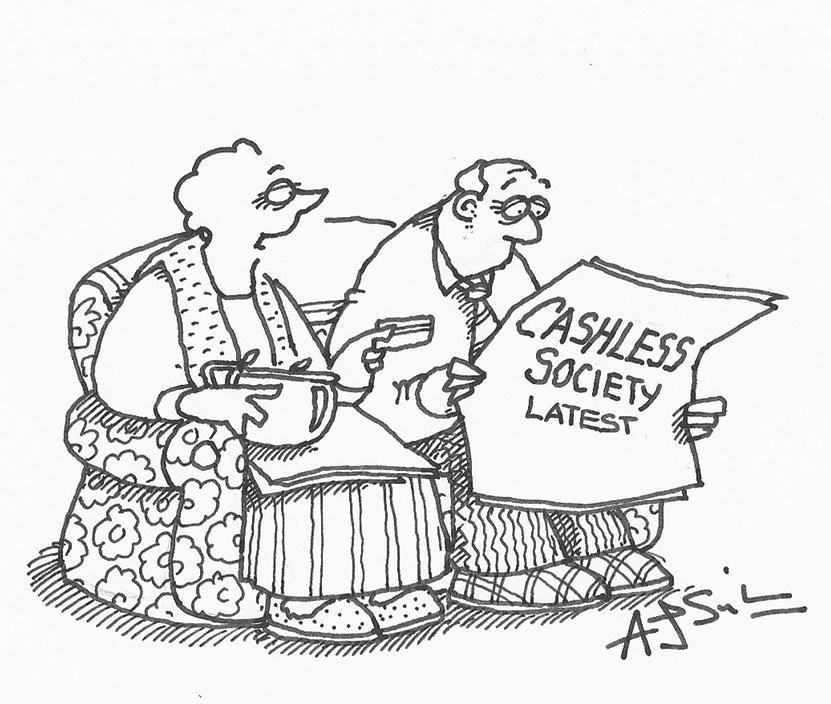
But, for this not quite so ancient reviewer, he will be forever young: stuck in a time warp, 1981, at what he too considers the most exciting period of cricket in his life.
Then he was not, of course, merely a journeyman professional but captain of the England team that, against considerable odds, not least thanks to him, won that year’s Ashes series against the old enemy, Australia. Ashes to Ashes – as I write this, England has just drawn this year’s series.
But I hasten to reassure those Oldie readers who are not sports- or cricketlovers that this very consciously conceived, exceptionally carefully thought-through and most intriguingly written kind of memoir-cumautobiography is very far from being all or even mainly about cricket. Not least because, as he’s written elsewhere, cricket ‘is violence’.
Some of Pebbles is chronological. It begins with his early life and ends with deep ruminations about last things.
But, in between, the chapters are by
no means narratively organised to take him from cradle to (we hope nowhere near) grave.
The book is set, to put it another way, much more in his Mind than in his Cricket.
His thoroughly immersive Classical education was taken to the point of embarking after school (City of London) and university (St John’s College, Cambridge) on a doctorate in philosophy and a three-year stretch of university lecturing (at Newcastle).
Our hero then made not one but two quite radical changes of professional direction. First – at an unusually advanced age – into professional cricket, captaining both his county (Middlesex) and his country. Then, less expectedly, he went into psychoanalysis, of a postFreudian variety – what he calls a ‘rum job’. Dreams figure prominently before and after the switch, as does the unconscious, but complexes less so.
His title’s metaphor is twice cashed out. He envisages the writing of the book as an exercise in turning over the pebbles of his lived self or selves to see what lies beneath – whether murky detritus and/or richer patterns or, more pithily, muck or beauty.
That formulation surely stems from the outlook of the later, psychoanalytical Brearley who, in order to practise as an analyst, had concurrently to be analysed himself as an essential part of his training.
Rather astonishingly, he was already in his late thirties when he made that second, life-determining and lifeenhancing career move.
As a truly young man, he had been both prodigiously good at all sorts of ball games – not just cricket – and exceptionally good at his largely ancient Greek, Latin and Roman school work.
Happily, his long engagement with Classical and philosophical studies, which introduced him to debates about democracy, slavery, class, gender, empire and tyranny, has left him a lifelong ‘A
The Oldie September 2023 55
card payment for your thoughts’

advocate of the study of the arts and humanities.
Still, characteristically, he gives that advocacy a peculiarly psychoanalytic twist: ‘The humanities call for the development of empathy and selfawareness, for a broadening of our emotional intelligence.’
It has also developed in him an enduring love of literature, modern as well as ancient, non-Western including Indian (a tribute to his wife’s ethnicity), as well as Western – although it has not saved him entirely from committing what we Classical academics call a ‘howler’ or two.
But it would be entirely wrong to end on any sort of negatively critical or even a querulous note.
This is a truly lovely book, full of wise saws and not only modern instances. ‘Old age is not for the faint-hearted but feels better than the alternative’ strikes a chord, though it does not ring a bell. His love of music – check out his appearances on both Desert Island Discs and Private Passions – shines through.
‘We all, with differing degrees of intensity, not only fear death but wish for it’: discuss.
His Cambridge mentor Renford Bambrough and one of my own mentors, John Crook, would surely posthumously approve their gifted, sensitive, moral, rational, courageous and intensely self-aware former pupil’s tribute to their pedagogy.
Mike Brearley plays down – unduly, I’d say – his literal captaincy roles, but of one thing I’m certain. He not only has a doctorate in people but is also the captain of his soul. O lucky man.
Paul Cartledge was Professor of Greek Culture at Cambridge University
King George’s golden touch
MARK BOSTRIDGE
The Maverick: George Weidenfeld and the Golden Age of Publishing
By Thomas Harding Weidenfeld & Nicolson £25
‘If you don’t f***ing well deliver your typescript by Tuesday, I’ll come and prise it from you with my teeth.’

Oh, the halcyon days of British publishing. This was the late Carmen Callil, of Virago and Chatto, seething with rage and tapping out a letter to me on her typewriter when my first book failed to materialise as expected in the late 1980s.
Kingsley Amis once wrote that if a publisher can be called a genius –a notion he considered distinctly ‘uncertain’ – then his own former publisher Victor Gollancz could certainly be counted as one.
Drawing up a list of publishing ‘geniuses’, one might also place on it the names of Allen Lane, with his revolutionary paperbacks of the 1930s, and Callil herself.
Half-a-century later, she helped transform the publishing landscape with the greenback Virago classics.
Another publisher, who made a lasting impact before the conglomerates moved in to cannibalise the august British publishing houses, and who undoubtedly merits a place on this list, is George Weidenfeld (1919-2016), the subject of Thomas Harding’s book.
A Jewish émigré from Vienna, fleeing Nazi persecution, Weidenfeld arrived in London in 1938 carrying a suitcase and a postal order for 16 shillings and sixpence.
A decade later, in partnership with the Conservative MP Nigel Nicolson, he formed Weidenfeld & Nicolson. Over the next 67 years, up to Weidenfeld’s death in 2016, the company would publish some 6,000 titles.
As Harding puts it, this was an astounding contribution to the world of literature and ideas, with lists especially strong in history, biography and politics.
Weidenfeld himself, ennobled in 1976 by one of his first authors, Prime Minister Harold Wilson, was a classic example of an outsider who became an integral part of the British Establishment. He was the supreme networker, numbering popes, presidents and the rich and powerful among his friends and associates.
He liked nothing better than the ‘mating’ of an idea for a book with its potential author. Books, he believed, could help build bridges between people.
The ideas they contained formed the basis for his own commitment to free speech, Zionism and greater amity between Jews and Christians, among a host of other causes to which he was passionately devoted.
Weidenfeld’s autobiography, Remembering My Good Friends, was derided on publication in 1996 as ‘an almanac of name-dropping’. But it provides a strong impression of Weidenfeld’s warmth and charm, as well as his short attention span.
Harding’s The Maverick is a bit of a bloodless hybrid, part biography, part compendium of Weidenfeld’s greatest hits. One moment, Harding is gingerly touching on the subject of Weidenfeld’s casual infidelities with women (he was married four times) as if he, the author, is being arraigned before a committee of MeToo members.
The next, he is giving us a rousing account of Weidenfeld’s courage and foresight in facing down opposition, on the ground of its obscenity, to the publication of Nabokov’s Lolita.
It isn’t easy to write about publishing – the humdrum nature of the editing process, the boardroom machinations that swiftly pall – in a way that seizes the ordinary reader’s attention.
Perhaps the late Oldie deputy editor Jeremy Lewis’s exhilarating memoir of his misadventures in publishing, Kindred Spirits, is one of the few books to succeed in this respect.
The riveting standout among Harding’s chapters is the story of Weidenfeld’s publication, in 1976, of David Pryce-Jones’s biography of Unity Mitford.
The revelation of the extent of Unity’s attachment to the Führer, and her overwhelming attraction to Nazi ideas, produced a vicious backlash from members of the English aristocracy who, in accusing Pryce-Jones of betraying his own class, exhibited evidence of their own anti-Semitism.
Other behind-the-scenes tales of books Weidenfeld published, or hoped to publish, fall flat. The narrative of his abortive attempts to make Mick Jagger sit still long enough to record impressions of his life for an autobiography quickly turns tedious.
For light relief, there is the account of Princess Michael of Kent, as neophyte biographer, copying ‘page after page’ from someone else’s book.
The Oldie September 2023 57
‘At school, I got punished for copying. Now it’s all I’m asked to do’




A spokesman for Weidenfeld & Nicolson issued a statement, delightfully to-thepoint in its defensiveness: ‘We are not embarrassed.’
Harding does make sadly clear one point in his comparison between the ‘Golden Age of Publishing’ that George Weidenfeld knew and influenced and the publishing world of today.
Whereas major figures such as Weidenfeld stood firm for the rights of free expression, today’s publishers are just as likely to act as censors, dropping writers and cancelling books.
Viennese whirl
BENEDICT KING
Vienna – How the City of Ideas
Created the Modern World
By Richard Cockett Yale University Press £25
The story of Vienna’s role as a radical cultural centre from around 1870 to the 1930s is fascinating.
The Habsburg Empire was an amalgam of countries, nationalities and religious groups yoked together under the conservative leadership of the Emperor Franz-Joseph I.
But Vienna stood apart in important ways. Not all of Vienna was liberal or radical, but liberal/radical Vienna was intellectually and culturally dominant.
Throughout this period, the Viennese were committed to Bildung — selfrealisation through broad education and culture.
Liberal Vienna’s answer to the problems besetting the empire (and mankind generally) was scientific rationalism, based largely on the theories of Ernst Mach. His name is now associated with measuring high-speed fluid movements relative to the speed of sound – Mach 1, Mach 2 etc.
But in pre-1914 Vienna he was not just a physicist but a philosopher, who elaborated an approach to life and everything, rooted in the idea that all we could know derived from our sensory experience.
Don’t be put off! This book is not a dry-as-dust story about cone-headed philosophers and physicists fleeing Austria to continue their impenetrable cerebrations at Cambridge and Harvard.

The second part of the book tells the story of how the radical liberal thinking
of the dying years of the empire (explored in part one) fed into a social democratic programme implemented by the Viennese municipal government after the war.
The radical programme met with some success. The biggest housing blocks in the world were built in 1920s Vienna to supply the housing needs of the working classes and create a communal life.
There were schools, shops and communal laundries, with all the conveniences of life attached to these new municipal homes.
The fitted kitchen was invented in this period by a woman, Margarete Lihotzky, to free womankind from the slavery of domestic drudgery by making housework quicker and easier.
Unfortunately, in the 1920s, Vienna was a social democratic island in a deeply conservative and much diminished Austria. In 1934, the homegrown fascists took over and then, in 1938, the country was absorbed into the Third Reich.
Over the course of the 1930s, many leading lights of Viennese society, either because they were on the left or because they were Jewish (often both) fled.
The really remarkable story this book tells follows in part three, tracing the impact the Viennese diaspora had on the West after the Second World War.
The Nobel prize-winning economist Friedrich Hayek was hugely influential on both Margaret Thatcher and Ronald Reagan, their economic policy and the political rationale behind it.
Through his founding of the Mont Pelerin Society and its offshoots, Hayek helped to build the institutional underpinning of neoliberalism. The founders of Wikipedia have cited Hayek’s thinking on the distribution of knowledge as inspiring their work.
Other Viennese economists developed game theory’s economic applications, which transformed how economists think about almost everything.
At a more obviously practical level, the shopping mall was invented by
Victor Gruen, another Viennese. The disciplined application of psychology to advertising and PR was developed by yet another, Edward Bernays. He was Freud’s nephew, who sold cigarettes to women as ‘torches of freedom’.
Market research, media studies, focus groups, all were developed with intellectual rigour by Viennese exiles in the United States.
The Viennese impact on Hollywood was huge, helping to dismantle the prudish regulation of the film industry.
The list goes on. This book argues convincingly that modern, democratic, consumerist capitalism is Viennese in its inspiration.
More trivially, the interior of Donald Trump’s Mar-a-Lago estate was created by a Viennese set-designer.
Britain absorbed the Viennese economic-cultural contribution to America in full but had its own significant Viennese diaspora. As well as Hayek, who was at the LSE for most of his career, Freud, late in life, was adopted by Britain. Ernst Gombrich’s The Story of Art is still the runaway bestseller of its kind.
Ludwig Wittgenstein and the publisher George Weidenfeld (whose biography is reviewed in these pages) were also British Viennese. The founders of the Thames and Hudson publishing house, ‘a museum without walls’, were Viennese exiles.
But our greatest monument to Viennese culture is the Edinburgh Festival, conceived by another Jewish, Viennese exile, Sir Rudolf Bing, to demonstrate ‘the emergence of a truly international culture’ and ‘provide a platform for the flowering of the human spirit’.
In its widely variegated forms, inspired by the unique cultural milieu of their native city, that was the objective of all the remarkable people discussed in this fine book.
Benedict King worked at the Bank of England
The Oldie September 2023 59
Mark Bostridge is author of Florence Nightingale – The Woman and Her Legend
‘Look, mum - a shoal of wet wipes’


Not so plain Jane
PHILIPPA STOCKLEY
Jane Austen’s Wardrobe
By Hilary Davidson Yale University Press £25
What did Jane Austen wear on a daily basis?
There are two known watercolours by her sister Cassandra. In Jane Austen’s Wardrobe, Austen authority Hilary Davidson forensically unpicks Jane’s letters to Cassandra to reveal much more. Only 161 of about 3,000 exist, as Cassandra burned most before her death.

Clothes are discussed frequently and familiarly, but often using arcane fabric terms. The author explains these, as well as sisterly assumptions about, say, a particular dress’s colour (which the sisters already knew).
When, in 1796, Jane remarked that a dress was ‘washed out’, it implies that it must have been made of cotton, for wool or silk were not washed.
Remarkably, Davidson identifies 32 gowns (dresses), 11 coats and wraps, 13 pieces of headwear, 15 accessories, four pairs of shoes and ‘many undergarments’.
Fascinating facts abound. Women’s flimsy shoes — and men’s stouter ones — were made identical; the foot itself moulded them.
Jane mentions ‘caps’ most frequently. Encompassing all headwear, they were the cheapest way to enliven an outfit. Throughout her 41-year life, she was on a budget.
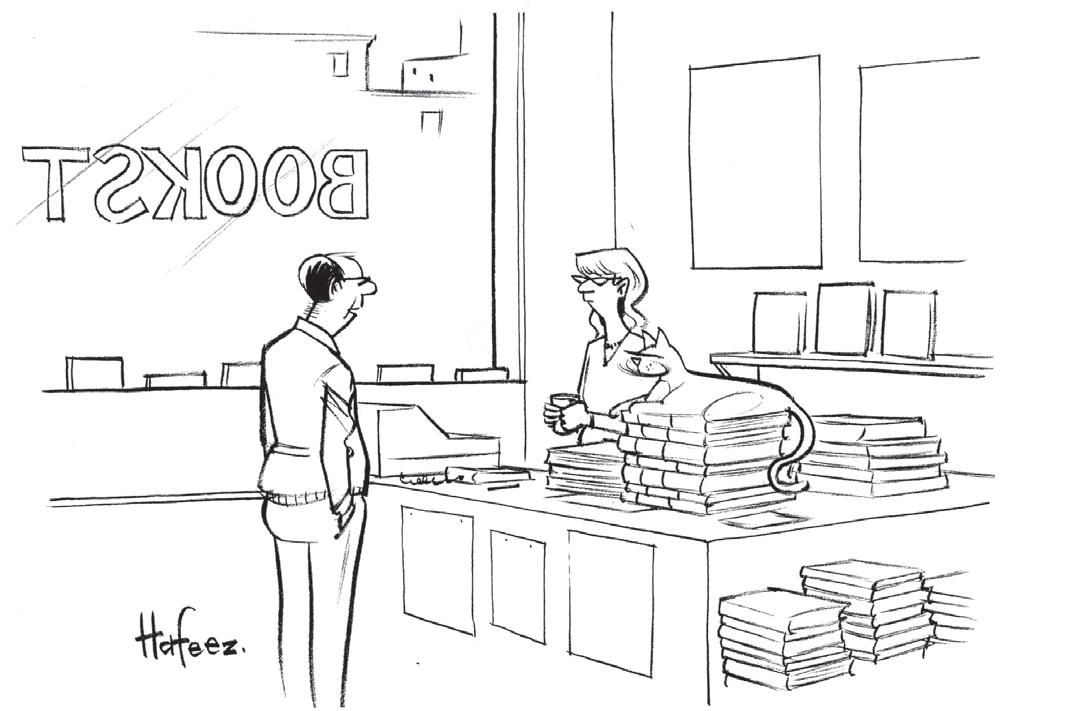
She always wore a cap over her knee-length, plaited and coiled hair, leaving a naturally curling ‘front’ (fringe) on show.
Fashion plates show the variety of often hideous caps to order, from nightcaps to bonnets to Mamelouc caps, in vogue after Nelson’s victorious 1798 Battle of the Nile. Supposedly ‘Egyptian’, albeit as Egyptian as a doughnut, these resembled plumed turbans. In 1799,
frugal Jane borrowed one, rather than forking out.
Fashion’s borrowing of a military style also resulted in the rage for high-necked ‘pelisses’. Loosely based on hussars’ fur-lined pelisses, they evolved into a sort of long, fluid day-coat.
The dashing coveralls were popular. Jane had one made in lustrous brown silk, woven with gold oak leaves. She evidently loved it, for an 1814 letter asks Cassandra to send it to her in London.
The garment survives, and Davidson has reconstructed it, revealing Jane’s figure. As she said herself, she was tall (about 5 ft 5in) and willowy — although an acid-tongued neighbour called her ‘a thin, upright piece of wood or iron’.
The letters are counterpointed with 200 illustrations: garments, fashion plates and paintings. Numerous Gallery of Fashion (1794-1803) engravings by German Nicholas Heideloff are joyful, as ‘Do you have any “How-to-get-out-ofdoing-it” books?’
well as packed with detail. Davidson invites one to ‘dip and browse-read her book, as one might rummage through a closet’.
It’s divided into sections, from Clothes Press, revealing Jane’s dresses, to Closet (outer garments), to various other parts of ‘dress’ (everything in an outfit, down to accessories). It concludes in the wittily entitled Drawers (undergarments and nightwear).
Naturally, one is inclined to plunge into the knickers drawer first. During the period covered, from about 1795 to 1817 when Jane died, women did not in fact wear drawers (knickers). Next to the skin was a shortish linen ‘shift’, beneath a short corset.
Even middle-class women like Jane hand-stitched their shifts, economically cut from oblongs, but bespoke almost all other garments. The often tiresome activity consumed much of the sisters’ time, money — and conversation.
Jane declares in 1798, ‘The Overton Scotchman has been kind enough to relieve me of some of my money in exchange for six shifts and four pairs of stockings.’ Here, ‘shift’ meant a length of linen sufficient for a shift, just as ‘gown’ also meant an appropriate length of cloth. Davidson further reveals that a ‘scotchman’ was not Scottish, but a peddler who ‘scotched’ (notched) a stick as a tally.
The section on gowns builds up an absorbing picture of Jane’s care over her dresses, in both style and maintenance.
The sisters often had dresses made in tandem or bought each other fabric. They followed fashion closely, despite Jane remaining cash-strapped until her novels were published. In 1807, from her disposable annual income of £50, almost half went on clothes and laundering.
Making do, making over, dyeing a gown black for frequent mourning, mourning a dress laundered to destruction, or adding adornments to refresh, were all discussed.
All women were at the mercy of their dressmaker. In 1813, describing a forthcoming stylish white gown, the author who controlled every aspect of her fictional world drily lamented, ‘My gown is to be trimmed everywhere with white ribbon plaited on, somehow or other. She [the dressmaker] says it will look well. I am not sanguine.’
As gripping as a corset, this superb book is a must-read for Austen lovers and scholars.
The Oldie September 2023 61
Sarah Carteret-Hardy’s fashionable muslin dress (Thomas Lawrence, 1801)
Philippa Stockley is author of Paint & Make (Pimpernel Press)

Dog days of Diogenes
THOMAS W HODGKINSON
The Dangerous Life and Ideas of Diogenes the Cynic
By Jean-Manuel Roubineau OUP £14.99
Plato once described the philosopher Diogenes (born late 5th century BC323BC) as ‘Socrates gone mad’.
That was quite a claim, since Socrates was already pretty eccentric. He had little time for sex and whenever he had an interesting thought, he would stand stock-still for hours, until he had worked out the implications.
According to Diogenes, though, Socrates was a lightweight. He criticised him for occasionally wearing sandals instead of going barefoot, and for spending too much time with the rich and famous.
Diogenes, who believed that people were unhappy because they bought into artificial conventions (marriage, for instance) and weighed themselves down with unnecessary possessions (sandals, for instance), dedicated himself to living authentically.
This involved begging for food, sleeping in a large ceramic jar in the Athenian agora, and openly insulting the powerful. On one occasion, Alexander the Great, the most powerful man alive, came to pay his respects.
‘What can I do for you?’ Alexander asked. ‘I’ll give you anything you want.’
‘You can take a step back,’ the philosopher replied. ‘You’re blocking the sun.’
Alexander was impressed, remarking later that, if he wasn’t Alexander, he would be Diogenes. When he learned of this, Diogenes declared that, if he
wasn’t Diogenes, he would still want to be Diogenes.
This is just one of a collection of killer anecdotes about the founder of the Cynicism movement, after the Greek word for ‘doglike’. The point of the name was that Diogenes lived more like a dog than a human, masturbating and going to the loo in public, on the grounds that both were natural.
The first achievement of the French historian Jean-Manuel Roubineau is to have seen that these stories, which are alternately shocking and hilarious, make the philosopher a terrific subject for a biography. His second is to have strung them together to create an account that, clocking in at just over 100 pages, is as terse and clear as its unsentimental subject could have wished.
A book so short inevitably leaves a few stones unturned. The author argues that dogs had a bad reputation in classical times, but doesn’t mention the loyal Argos in The Odyssey, who would have been an obvious counter-example. Beggars were the lowest of the low but The Odyssey provides a telling counterexample, which he omits: Odysseus is disguised by Athena as a beggar.
It’s strange, too, that Roubineau doesn’t find space to tell one of the best-known tales about Diogenes. He used to wander around in broad daylight holding up a lamp. When asked what he was doing, he replied, ‘Searching for an honest man.’
It seems to have been a strategy of the philosopher to behave oddly until someone commented, at which point he could whip out a one-liner. Once he walked around backwards until he was asked why. ‘You ask me this,’ he replied, ‘who have spent your whole life walking in the wrong direction?’
Another time, he knelt before a statue and begged. Why? ‘I’m just trying to get used to rejection.’
On the plus side, I was fascinated to learn that the practice of living in ceramic storage jars, which could be large enough for a man to stand up in, had begun in Athens during the dark days of the Peloponnesian War (431-404 BC).
By making his home in such a jar several decades later, Diogenes implied that he was himself at war – with absurd human conventions.
Intriguingly, though, Roubineau points out several ways in which Diogenes, for all his extremity, was more conventional than he claimed. While rejecting marriage, he denounced adultery. Although he claimed to believe in the equality of the sexes, when he selected mythological examples of virtue, they tended to be male.
When one of his followers asked him how to achieve fame, Diogenes replied, ‘By thinking about it as little as possible.’
Depending on how you take this, he either couldn’t care less about fame – or he cared enormously. He devoted a lot of energy to drawing attention to himself.

As the book progresses, Diogenes emerges as an ambivalent hero for our times – a man who would have stirred up a storm on Twitter, attracting millions of followers, while protesting his indifference to how many he had. In this respect, too, he was more conventional than his reputation suggests.
If Diogenes himself didn’t take his philosophy as far as it would go, might someone else? What would a Diogenes gone mad look like?
Thomas W Hodgkinson is author of How to Sound Cultured
The Oldie September 2023 63



You have no idea how much nastier I would be if I was not a Catholic. Without supernatural aid, I would hardly be a human being.
Evelyn Waugh in a letter to Nancy Mitford, who had been shocked at his unkindness to a young fan
I was in the Virgin Islands once. I met a girl. We ate lobster, drank piña coladas. At sunset, we made love like sea otters. That was a pretty good day! Why couldn’t I get that day, over and over?
Bill Murray in Groundhog Day (1993)
Four be the things I’d be better without: Love, curiosity, freckles and doubt.
Dorothy Parker, Inventory
God may pardon you but I never can.
Elizabeth I to the dying Countess of Nottingham
All the inspiration I ever needed was a phone call from a producer.
Cole Porter
Old age is the most unexpected of all the things that happen to a man.
Leon Trotsky, Diary in Exile
I never saw a wild thing Sorry for itself.
D H Lawrence, Self-Pity
Mom and Pop were just a couple of kids
when they got married. He was 18, she was 16 and I was three.
Billie Holiday
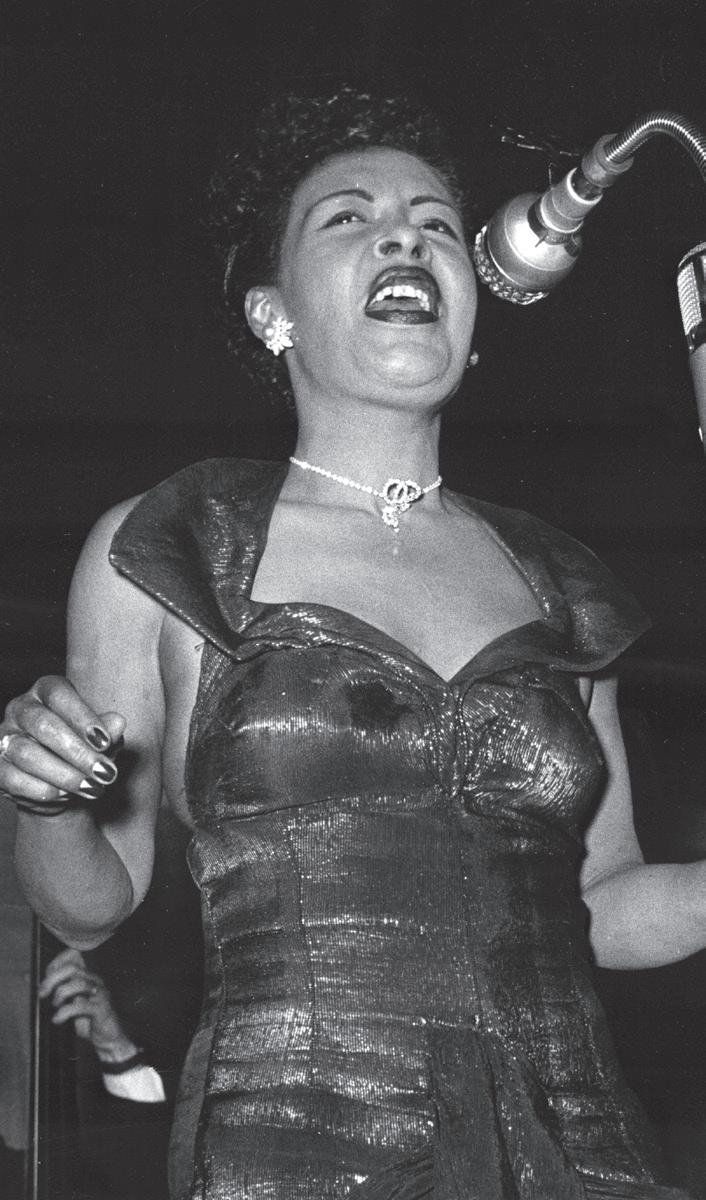
If you have nothing to say or, rather, something extremely stupid and obvious, say it, but in a ‘plonking’ tone of voice – ie roundly, but hollowly and dogmatically. Stephen Potter, Lifemanship
and Lexus’s ‘Experience Amazing’. Note the banishing of the adverb: Old Speckled Hen’s ‘Drink Curious’.
Another subset appeals to the narcissistic. ProTan’s can of lotion proclaims:
‘It’s All About Me!’
The man who hides one thing in his heart and says another is as hateful to me as the gates of Hades.
Homer, The Iliad
They thought, because I was from the South, that I just mumbled.
Elvis Presley
Forsan et haec olim meminisse iuvabit – Perhaps one day it will cheer us up to remember even these things.
Virgil, The Aeneid
Most people experience love without noticing there is anything remarkable about it.
Boris Pasternak, Doctor Zhivago
He was a man who had discovered that alcohol was a food long before the doctors found it out.
P G Wodehouse, Psmith in the City
One of these days in your travels, a guy is going to show you a brand-new deck of cards on which the seal is not yet broken. Then this guy is going to offer to bet you that he can make the jack of spades jump out of this brand-new deck of cards and squirt cider in your ear. But, son, do not accept this bet, because as sure as you stand there, you’re going to wind up with an ear full of cider.
Marlon Brando, playing Sky Masterson in Guys and Dolls (1955)
work? Neville Johnson, furniture manufacturers, want you to ‘Find Your Fabulous’, no doubt mislaid on the top shelf.
Artois or Total’s ‘Our energy is your energy’. While its cousin, ‘Your Toyota is My Toyota’, sounds like a threat of repossession.
Moronic adverts
Admen once aspired to wit or cleverness, but the target audience today seems to be the illiterate or moronic.

‘Live Brilliant,’ shouts Hyundai. ‘Eat More Amazing,’ urges Deliveroo. ‘Find Your Happy,’ says Right Move. If you’ve already found it, Tui wants you to ‘Live Happy’. Deliveroo’s ‘Amazing’ has to share the stage with ‘Let’s Do Amazing’ (Hewlett Packard)
Tu (whatever that is) begs you to ‘Be You with Tu’, though Holiday Inn goes one step further with ‘Stay You’. Amex is resigned: ‘Keep Being You’, a useful followup to Diet Coke’s ‘You Do You’. Jack Daniels pushes the boundaries: ‘Be the Best Version of You’, achieved, one assumes, by getting legless on bourbon.
Some admen reach for the mysterious. Adidas proclaims that ‘Impossible Is Nothing’. How does that

Subaru shouts ‘Way of Life!’, even though the rest of the sentence has gone missing. Likewise, Hitachi’s ‘Inspire the Next’ and the government of Abu Dhabi’s ‘Find Wonder’.
The nonsensical is popular, as in ‘Be Legacy’ from Stella
SMALL DELIGHTS
Post that arrives the next day, with a secondclass stamp.

CAROL FREE, SWAFFHAM
Email small delights to editorial@theoldie.co.uk
One expects better from Heineken than the vacuous ‘Open Your World’ or Dom Perignon’s laboured ‘Creative Freedom is Power’, but Lanson delivers the goods with a rousing ‘It’s All About Love!’
After this avalanche of blandness and incoherence, it will be a relief to older readers to recall the poetry of ‘Murray Mints, Murray Mints! Too good to hurry mints’. Or the politically incorrect ‘Guinness is Good for You’. Younger readers will just have to get by with Sky’s ‘Believe in Better’ and Vauxhall’s ‘Embrace Life’.
STEPHEN BROOK
Commonplace Corner
TOM PLANT
The Oldie September 2023 65
Lady sings the Blues: Billie Holiday
FILM HARRY MOUNT THE GREAT ESCAPER (PG)
Next year will be the 80th anniversary of D-Day – the last chance for veterans, now all in their late 90s or older, to make the pilgrimage to Normandy en masse.
And so, too, with perfect, bittersweet timing, this marvellous film (released on 6th October) about D-Day veterans is the last outing for the great Glenda Jackson, who was 87 when she died in June.

She is absolutely magnificent as Irene Jordan, the wife of Bernard Jordan (Michael Caine). The film is based on the true story of Bernard, a Second World War Royal Navy veteran.
In 2014, on the 70th anniversary of D-Day, he absconded from his care home in Hove to attend commemoration events in Normandy. A mere 89 at the time, Jordan died shortly after, at 90.
Caine, also 90, is pitch perfect for the part – not least because he saw active service in the Korean war in the Royal Fusiliers 70 years ago. Looking frail and thin, he is very moving at portraying the indignities of age and the urge to
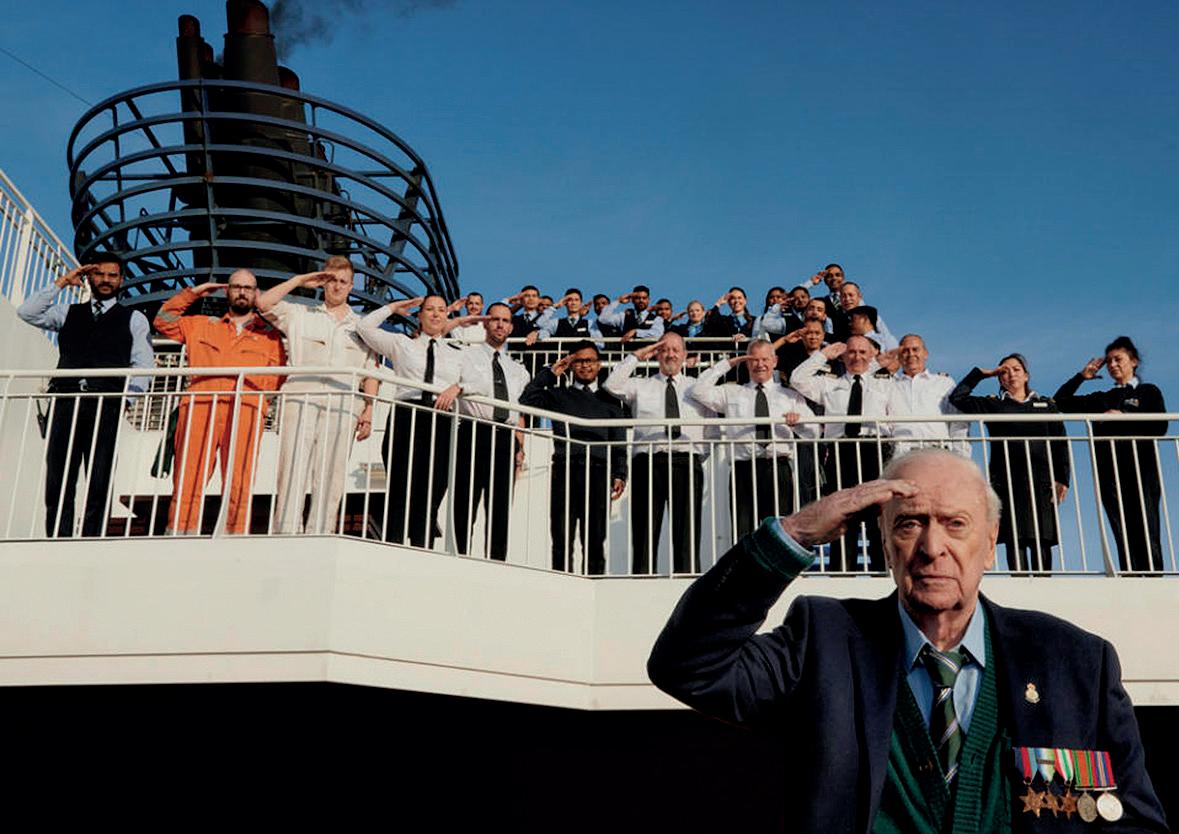
Arts


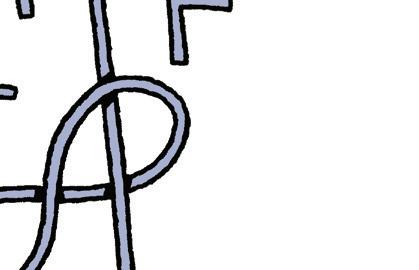

rage against the dying of the light.
Life in the Jordans’ nursing home is well captured by director Oliver Parker and writer William Ivory: the endless pills, the functional, semi-medical furniture, the stumbling on sticks and the slow progress in wheelchairs.
Caine has been famous for so long – Zulu came out in 1964 – that it’s easy to forget what a gifted actor he is. He underplays everything – he is very still –and so, when he does break into a smile or suddenly turn menacing, he multiplies the impact.
And that voice has been imitated so much that you forget how original – yet non-fake – it is. At one point, he’s offered a German chocolate bar and says, ‘If you wanna flog chocolate bars, don’t start a bloody world war.’ Wonderful shades of The Italian Job (1969) and ‘You’re only supposed to blow the bloody doors off.’

Just as Caine returns to his south London, Cockney youth, Glenda Jackson’s voice migrates to her Birkenhead roots. Alternately grumpy and charming, she is sublime – straight out of the Alan Bennett School of Northern Battleaxes.


And how unvain she is, gap-toothed,












all skin and bone, with the camera, zooming in on ultra close-up, catching every wrinkle in high definition. Caine, too, is vanity-free, content to have his ageing body filmed in a vest.
There is the odd clichéd moment, not least in the flashbacks to the Jordans’ 1940s courtship and the D-Day horrors inflicted on Bernard Jordan.

But the workmanlike if perfectly adequate performances of young Bernard (Will Fletcher) and young Irene (Laura Marcus) just heighten the greatness of Michael Caine and Glenda Jackson.
John Standing, 90 next year, is excellent, too, as a haunted D-Day veteran officer. His alcoholism has stopped him visiting the grave of his brother, killed in Normandy, for 70 years.
At one moment, Standing quotes from At the British War Cemetery, Bayeux, by the poet Charles Causley (1917-2003), himself a Royal Navy veteran of the Second World War: ‘I walked where, in their talking graves / And shirts of earth, five thousand lay.’
A fine elegy to the war dead – as this fine film is a just tribute to the rare talents of Michael Caine and the late Glenda Jackson.
66 The Oldie September 2023
PATHÉ Glenda Jackson’s last lm – as the wife of Bernard Jordan (Michael Caine), who ed his care home for D-Day’s 70th anniversary
THEATRE WILLIAM COOK
LA CAGE AUX FOLLES
Regent’s Park Open Air Theatre until 16th September
‘Content Advisory’, reads the trigger warning outside this outdoor theatre in lovely, leafy Regents Park. ‘The production contains loud whip-crack sounds and addresses themes of transphobia, homophobia and misogyny.’
Oh no, not another tedious play about sadomasochism and transgender rights. Why is everyone suddenly so obsessed with this sort of thing? In fact, this musical has been around for 50 years. And, despite its lurid content, it’s actually remarkably conventional.
La Cage aux Folles (literally ‘the cage of crazy women’) started life in 1973 as a comic play by French actor and director Jean Poiret. It was a succès de scandale in France and, in 1978, spawned an entertaining movie that transcended the language barrier to become a transatlantic hit.
In spite of its risqué subject matter, the plot was as old as the hills: nice young Frenchman Jean-Michel wants to marry his wholesome sweetheart, Anne Dindon, but before they can wed, he must arrange a successful rendezvous between his bohemian parents and Anne’s reactionary mum and dad.
So far, so familiar. The twist is that Jean-Michel’s loving parents are two gay men who run a notorious drag club called La Cage Aux Folles (‘folles’ doesn’t just mean mad women – it’s also French slang for homosexual).
Half a century ago, the concept of two homosexual men raising a happy, well-adjusted, heterosexual son was still extremely controversial, and when Harvey Fierstein and Jerry Herman turned Poiret’s play into a flamboyant Broadway musical, in 1983, social conservatives were aghast. But liberal audiences loved it. Its standout song, I Am What I Am, became a gay anthem, and a cri de coeur for outsiders and eccentrics of every stripe.
More remarkably, it also went down very well with mainstream theatregoers, not only on Broadway but also in London’s West End, and on tour.
Why was it so successful? Partly because Jean-Michel’s parents, Georges and Albin, were such rounded, sympathetic characters but, above all, because, beneath its radical veneer, La Cage Aux Folles is really a very traditional drama.

A gay old time: Georges (Billy Carter) and Albin (Carl Mullaney)
When Albin drags up to fool Anne’s parents, we’re back in the well-trodden terrain of Charley’s Aunt (written by Brandon Thomas way back in 1892) and countless subsequent crossdressing dramas. ‘Gender fluidity’ may seem new and daring to today’s trans-inclusive youngsters, but dramatists have been playing around with the concept since Shakespeare.
Tim Sheader’s bright and ballsy production hits all the right notes. The big ensemble numbers are funny and sexy, and the glitzy costumes are wonderfully OTT. Carl Mullaney’s Albin is an alluring blend of virtuosity and vulnerability – so confident in drag, so insecure beneath the make-up. Billy Carter is excellent as his partner, Georges, the club’s owner and compère. Surrounded by larger-than-life performances, he gives a relaxed, naturalistic presentation that holds the whole show together. His dry wit and easy charm reminded me of David Niven.
My only beef is with the setting. Sheader retains Poiret’s original Côte d’Azur locale, but his cast adopt a wide array of accents, which sometimes jars. The Teutonic accents work a treat, the broad Northern English accents somewhat less so. Would it have worked better if Sheader had been bold enough to transfer this French Riviera musical from Saint-Tropez to Blackpool?
No matter. This is a terrific show, with a good deal of substance beneath its gaudy surface.
I feel it’s only fair to sign off with a trigger warning of my own – wrap up well!
Regent’s Park Open Air Theatre has been going strong since 1932, attracting over 100,000 visitors every summer. I’ve been lots of times and I’ve never
seen a bad show, but my enjoyment has always been closely aligned with the erratic English weather. Last time I came, we got rained off – a rare occurrence, but an occupational hazard all the same.
This time, I hit the jackpot – the weather was warm and dry – but even on a hot day it can get very chilly after dark. I felt rather silly wearing thermal underwear on a midsummer evening, but I’ve never been more comfortable – certainly a lot more comfy than all the tightly corseted men onstage.
Wrapped up nice and warm, with a thermos and waterproofs in my rucksack, the transphobia, homophobia and misogyny didn’t bother me at all.
RADIO VALERIE GROVE
‘Beyond the Fringe first fell upon London like a sweet refreshing rain on 10 May 1961,’ wrote Michael Frayn.
‘That night, the theatre came of age,’ wrote Kenneth Tynan.
Bernard Levin called it ‘brilliant, adult, hard-boiled, accurate, merciless, witty, unexpected, alive, exhilarating, cleansing, right, true and good’.
Levin was OTT but, at 15, I agreed. Fringe paved the way for Private Eye, TW3, the Pythons...
Jeremy Front’s play Behind Beyond the Fringe (Radio 4) retold the story. John Bassett of the Edinburgh Festival assembled the distinctive Oxbridge quartet. Don Alan Bennett and Dudley (‘the piano’s his forte’) Moore were both Oxonians from state grammars. Then there were the two Cantabs from public schools, junior doctor Jonathan Miller and revue-writer Peter Cook.
Bassett introduced the four over lunch and lured them with his £100-a-week
The Oldie September 2023 67
GARY SMITH
fee: and so their hit show was born.
Tom Durand Pritchard excelled as Dr Miller, fluent and loquacious, interrupting Dudley’s ‘I’ve got a club foot’ with ‘Ah, Talipes equinovarus!’. Miller arrived on his Lambretta from performing an autopsy – ‘A goitre the size of a grapefruit.’
Front’s play prompted me to re-watch the whole show, on YouTube. I was reminded how quick, clever, likeable, funny they were. But they are also absurd and dated, with too-silly voices and lines you can’t now get away with.
The opening sketch about America includes the lines: ‘I gather the negroes are sweeping the country’ – ‘Yes, it’s the only job they can get’ – ‘And very well they do it, too.’
The excellent camp sketch, where ‘three outrageous old queens’ are joined by a fourth, who cries, ‘Hello, darlings!’ was bowdlerised by the Lord Chamberlain to ‘Enter three men of aesthetic appearance. Fourth man: “Hullo, men!” ’ Hilarious.
The arbitrary changes in what is allowed to be funny, and by whom, featured on Archive on Four, with Shticks and Stones by David Schneider, on the pitfalls of Jewish comedy. He replayed a Seinfeld scene where Jerry’s dentist announces that he has just converted and is now a Jew. He has been in a sauna – ‘More like a Jewish workout’.
Seinfeld: ‘D’you think you should be making jokes like that?’
Dentist: ‘Why not? Our Jewish humour has sustained us for 3,000 years!’
Seinfeld: ‘I believe you converted just for the jokes.’
Compare the 1920s recordings of Julian Rose: ‘I want to marry for love. But every time I find a girl I want to marry for love, I find she ain’t got any money!’
Then there’s Lenny Bruce: ‘There are no good opening lines in a concentration camp. “How’s it going? They treatin’ you OK?” ’ Well, goodbye to most of that.
John Humphrys fulminated in print about Radio 4, his old station. He hates ‘the plinky-plonk noise’ – portentous, pointless background music in documentaries – and the false mateyness (a contagion from podcasts).
James Marriott, the Times podcast critic, says he is ‘weekly crucified on the altar of human self-indulgence’ because people blether on too long.
Too right. I could sit through hours of Oppenheimer and even Barbie, but abandoned 20 radio episodes of the BBC
Banksy story, full of repetition, waffle and padding. Ditto an apparently popular podcast called Who Shat on the Floor at My Wedding? (Don’t ask.)
The Katie Price podcast (‘All about my life… answering random questions about the wild stuff we did as teenagers’) was worse. ‘I love it when people look up to me,’ preened Katie, ‘for my work ethic, for my strength.’
Enough! Such excesses of cretinous narcissism drive me back to produced, edited, crafted programmes. There was Fiona McAlpine’s The Venice Conundrum (Edalia Day as Jan Morris transitioning, while writing about Venice). Or Christopher Douglas’s play about the Bodyline tour of 1932. Stephen Fry’s effusions on Wodehouse excelled, as did a rich four-parter on Seamus Heaney.
And many thanks to a Sunday Worship on St Francis, with sublime choral music from Assisi. It propelled me to the National Gallery for the St Francis exhibition.
All, deo volente, available on Sounds.
TELEVISION FRANCES WILSON
I’ve been watching Alistair Petrie for some time now. It’s easy to do because he’s tall and ginger with a face you can – but should never – trust.

He specialises in minor characters who are also slimeballs. He played James Goldsmith in the superb TV movie Lucan and Sandy Langbourne in The Night Manager. He appears in various episodes of Midsomer Murders, Sherlock, Vera and Undercover.
It’s always fun when Petrie pops up in a scene because he has a menacing energy but he’s not, until now, been given the leg room to stretch himself into the role of a major slimeball.
In The Following Events are Based on a Pack of Lies (BBC 1), written and created by sibling writing duo Penelope
and Ginny Skinner, Petrie plays a chancer called Rob Chance. The character started out doing small-scale scams in Stoke and is now going for the big time as the ‘ecoprenure’ director of a ‘global climate academy’, operating out of an Oxford college.
His latest target is Cheryl Harker (Marianne Jean-Baptiste), the J K Rowling-style fantasy author who has fallen out with her fans.
‘Before I kiss you,’ Rob purrs, ‘I have to warn you: I don’t do strings, I travel light and I’m spending the next six months on a remote polar research station without wifi.’
Rebekah Staton plays Alice, Rob’s downtrodden ex-wife, now a downtrodden PA to a fashion designer. Cheryl lives with her poodle, Goblin, in a fantastical château in Boar’s Hill and Alice lives with her disabled father in a crappy bungalow somewhere on the outskirts of Oxford.
The only thing the two women have in common, apart from being taken in by Rob, is their experience as carers. Cheryl’s husband, now deceased, had dementia and Alice’s father (Karl Johnson), still living, was physically and mentally destroyed after he and Alice were robbed, by Rob, of everything they had.
The story begins 15 years after Rob disappeared from Alice’s life when he borrowed a tenner to get himself a curry. Alice is walking past the Radcliffe Camera when she sees him again in his new identity as a ‘disruptive explorer’, which involves wearing a hideous orange kagool and shouting into his iPhone.
In a state of terror and fascination, she turns up at an event to promote his climate academy where his face is projected onto the side of the Bodleian. He is then lowered from the roof of the building but the ropes go awry and he turns upside down, which is risky because he’s wearing a kilt.
No synopsis can do justice to the freshness and style of this drama. Petrie is superbly seedy and cringeworthily convincing. Setting the events in Oxford is a masterstroke and the comedy is striated with pure rage.
Who among us has not been scammed? Our lives have become scam: we are scammed all day and every day by ‘wellness’ entrepreneurs, fake philosophers, fake therapists, fake everything. And the fakes who operate these scams are treated as icons rather than held to account.
Episode one opens in documentary style, with victims of scams talking to the camera. An American, sitting outside his
68 The Oldie September 2023
Major slimeball: Alistair Petrie
caravan, explains that he gave two million dollars to a man who convinced him that he could reverse ageing: ‘I was dubious at first, but then Mom showed me the website.’
We then cut to Rob himself, in a black polo neck, telling us that he’s had to fight his way through a ‘corrupt system’, and warning ‘the doubters and the haters – yeah, you know who you are – I believe in a little thing called karma, and your karma’s coming.’
All the clothes in the show are witty, but the black polo neck is pure genius. It was Steve Jobs who turned it into a symbol of pure genius.
That’s why the biotechnology entrepreneur Elizabeth Holmes (now in prison) wore one to raise funds for her fake blood-testing company.
Alice’s signature look is a red cape she designed herself, and she makes one for Cheryl too. ‘The woman who wears this is not afraid to take up space. She is confident, she is creative, she is…’
Alice runs out of adjectives, but the woman who wears this is as hellbent on disruption as the dwarf in Don’t Look Now.
Bob Wilson
MUSIC
RICHARD OSBORNE
L’ELISIR D’AMORE BYRDWATCHING
‘In summertime on Bredon/The bells they sound so clear,’ wrote A E Housman. There are other sounds, too, in the Cotswolds in high summer: choral and orchestral music at the Three Choirs Festival, masterworks ancient and modern at the traditionally enterprising Cheltenham Festival; and opera at Longborough.
Heeding George Bernard Shaw’s advice ‘nothing is easier than not to go to Gloucester’ – he was dodging the 1892 premiere of Hubert Parry’s Job –I skipped this year’s Three Choirs Festival in Gloucester and settled instead for Cheltenham and Longborough.

Longborough’s summer treat was a delectable new staging of Donizetti’s perennially enchanting rustic comedy L’elisir d’amore (‘The Elixir of Love’). The opera’s everywhere at the moment. It’s at Glyndebourne during its summer and autumn seasons, and in cinemas live
from Covent Garden in October. Yet there was a special charm in seeing it in Martin Graham’s intimate 500-seat opera house near Stow-on-the-Wold.
The staging, by director Max Hoehn and designer Jemima Robinson, set the opera in a village in our own ‘green, pleasant and now protected’ land – the world of Jez Butterworth’s Jerusalem; only a touch less menacing.
It’s a score that gets richer by the minute, culminating in arias for the suitably chastened heroine and her lovesick swain – never has levelling up seemed so attractive – that are among the most affecting in the repertory
There’s also the opera’s comic lead, the travelling quack Dr Dulcamara, rousingly played by Emyr Wyn Jones. Snake-oil salesmen, like the poor, are always with us – so this is another role that refuses to date.
Cheltenham’s 2023 pièce d’occasion was ‘Byrdwatching’, a two-hour Sunday evening progress, with music by the great William Byrd sung and played by musicians from the Royal Birmingham Conservatoire in the intimacy of four privately owned drawing-rooms in
The Oldie September 2023 69
‘We’re going to need a lawyer, George’
the handsome 1830s Imperial Square. Byrd (c.1540-1623) was the finest musical craftsman of the Elizabethan age, as well as a man whose personal and political manoeuvrings make those of Johann Sebastian Bach seem provincial by comparison.
The 400th anniversary of Byrd’s death on 4th July 1623 prompted a host of retrospectives, some of the finest of which were on Radio 3. These included a predictably absorbing five-part edition of Composer of the Week, and two superb programmes compiled and presented by Tom Service. The first explored the launch of Byrd’s professional career in Lincoln Cathedral, from where a live Choral Evensong was also broadcast.
The glory of the Cheltenham progress – the kind of thing the National Trust used to do when music was heard in its houses – was the opportunity it gave to present, in context, works which out of design or necessity were written to be heard in private.

These included sacred music that would have been performed around the table of one of the several recusant Catholic households to which this all-licensed composer – licensed by the monarch, no less – was intimately attached. A vocal consort led by tenor Daniel Marles, gave us one particular gem, the sublime ‘Agnus Dei’ from the Mass for Four Voices.
Like most chamber music, Byrd’s keyboard music is best heard live in the presence of the performers. One of the student musicians, Aoife Fahey, played a Pavane and Galliarde from My Lady Nevell’s Book. This was no random pairing. Byrd composed these danceduos, much as Shakespeare composed his sonnets, for both art and exercise.
The Head of Historical Performance, Martin Perkins, threw his hat into the ring with a rousing account of Byrd’s ‘The Queen’s Alman’ – keyboard variations on
an Italian song about a girl who refuses to take the veil, that had become popular as a broadside ballad in the 1560s.
As cellist and gamba-specialist David Hatcher later explained, Byrd loved the popular songs of the day, much as his sophisticated patrons revelled in the orderly improvisations Byrd wove around them. We experienced this in what was the undoubted highlight of the evening, a glorious sequence of pieces played by the conservatoire’s consort of violas. This, appropriately, took place in what was the most beautifully appointed of the four drawing-rooms we visited.
If you weren’t in Cheltenham, despair not. The King’s Singers and our longest-serving viol consort, Fretwork, have recently released a CD celebrating the music of Byrd and that rather more iconoclastic figure – Donne to Byrd’s Spenser or Shakespeare – the great madrigalist Thomas Weelkes, who also died in 1623.
It’s called Tom+Will: Weelkes and Byrd 400 Years (Signum Classics). If there’s been a more stimulating disc released this year, I’ve yet to hear it.
GOLDEN OLDIES RACHEL JOHNSON SOUNDS OF SILENCE
This summer, something happened. I went to New Zealand during Glasto and British Summer Time, therefore missing Lizzo and Elton, and then the Boss.
I lost my AirPods. When I went to the Cyclades, from where I write, I failed to connect my iPhone to my Bose speaker in the Aristide Hotel, Syros, and gave up.
When we were lent a car on the dock in Tinos, there was an empty slot where the radio was.
In Sifnos, the rental car had a radio but when I tried to tune it to some bouzouki, I failed and found only
warbling static. I switched it off with relief. Katy Perry sang she kissed a girl and she liked it. Well, I found the sound of silence and I liked it even more.
Except, of course, it’s not silence. We are so used to being on screens or having audio piped into our ears at all times that when it stops, we become aware of other sounds anew. The distant traffic. The birdsong. The wind. The Jeep going up the hill by the white church.
John Cage – the composer of 4’33” (or four minutes thirty-three seconds) in which the musicians are instructed not to play throughout the three movements – was one of the first to demonstrate this, after visiting the anechoic chamber at Harvard.

Cage had gone to a place where he expected total silence, and yet heard sound. ‘Until I die, there will be sounds. And they will continue following my death,’ he said. ‘One need not fear about the future of music.’
I now appreciate peace and quiet more than rock and roll. This month, I should be writing about the fact that hip-hop turned 50 but I found I only wanted to play Stan by Eminem, Rapper’s Delight, and 99 Problems by Jay-Z, and then –nothing much. I wanted to tune into the music of the spheres again.
What’s wrong with me? Is this the summer I got old? I may not even replace my AirPods. After all, I need my Quies wax earplugs – for defence against my husband’s snoring – far more and, at £6 a packet, they are far cheaper and more useful.
The truth is that I only want to hear bangers and dance after a few drinks. No surprise then that one of the most lasting pop songs in the canon is The Sound of Silence. Another minimalist Philip Glass arranged and performed it when Paul Simon was awarded the Gershwin Prize for Popular Song. You don’t need me to remind you of the Tremeloes hit, issued three years after Simon and Garfunkel’s?
Silence is golden – especially in my bee-loud glade in Greece.
70 The Oldie September 2023
Magic potion: Donizetti’s L’elisir d’amore, Longborough Festival
Quiet man: John Cage in 1988
MATTHEW
WILLIAMS-ELLIS
EXHIBITIONS
HUON MALLALIEU SCOTTISH WOMEN ARTISTS, 250 YEARS OF CHALLENGING PERCEPTIONS

Dovecot Studios, Edinburgh, to 6th January 2024
A JOURNEY SHARED, BLACKADDER AND HOUSTON
Royal Scottish Academy, Edinburgh, to 12th September
‘Challenging perceptions’ must be the most time-expired cliché in the curatorial lexicon.
In general, it means challenging opinions that no one, other than exhibition organisers, has held for ages.
In the context of this show, the battle has been fought since the Glasgow Society of Lady (Women since 1975) Artists was launched more than 140 years ago. From the early 1900s, women have played a major role in Scottish art.
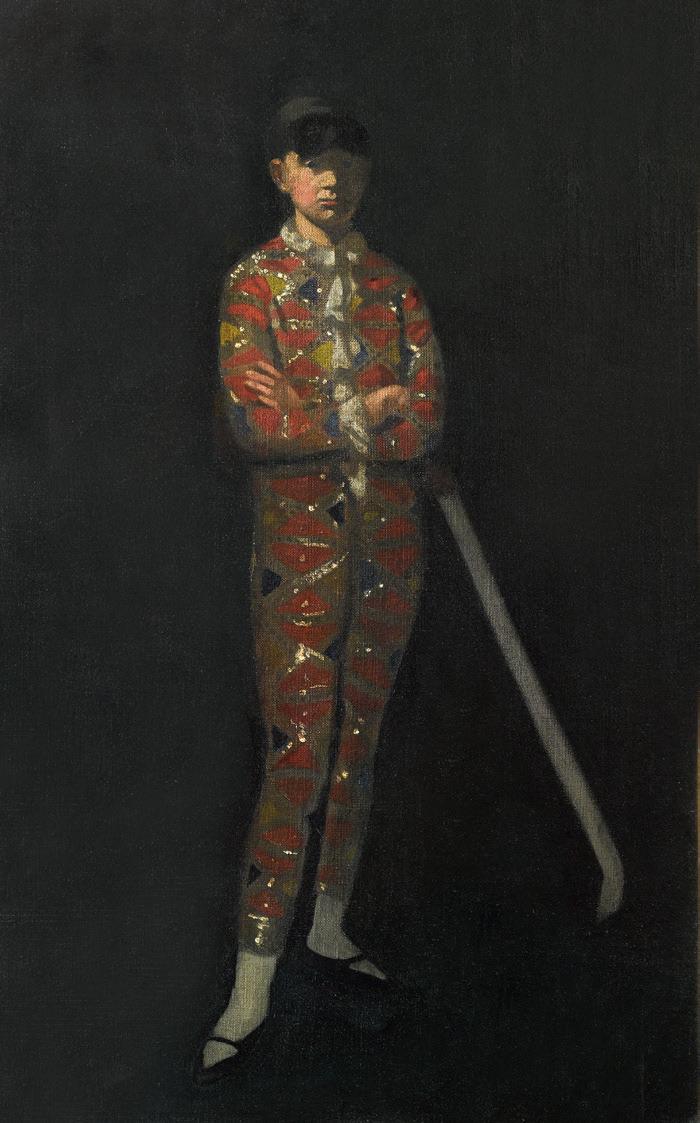
So the subtitle does little for this otherwise admirable exhibition.
It follows the publication of Scottish Women Artists (Fleming Collection, £9.95) by Charlotte Rosteck, who is doing such impressive work with the Dumfries House and Dalkeith Palace projects.
The first formally trained, female, Scottish artist was Catherine Read (1723 - 78). Her eminent clients included the Hanoverian royal family, despite her strong Jacobite connections, and she narrowly missed being a founder member of the Royal Academy.
The show includes several of Dovecot’s own fine and applied artists and designers, including my own
great favourite, Victoria Crowe.
A Journey Shared is a selling exhibition intended to further fund the Blackadder Houston Bequest left by the artists and managed by the RSA to provide bursaries, prizes and travel awards for graduate and mid-career artists.
Elizabeth Blackadder (1931–2021) and John Houston (1930–2009) met at art school and both became highly influential teachers.
As the first woman to score the double as RA and RSA, and the Queen’s Limner for Scotland, Blackadder has enjoyed the wider reputation. She is rightly loved for her watercolour friezes of flowers and her cats and still lifes.

This show should help to bring Houston forward again, especially for his forceful mastery of colour. Large canvases such as Gullane Bay or variations on the Bass Rock are controlled explosions.

Despite their long life together, they retained quite distinct artistic personalities, even if there is a natural kinship in drawings from their travels. There are prints, watercolours and drawings here, as well as some superb paintings. It is a very worthy cause.
If you’re visiting the RSA, have a look at the Scottish National Gallery’s Grayson Perry exhibition. A perception that does deserve to be challenged is that Perry does not take art seriously, and that, in the words of a newspaper pundit, his own work ‘relentlessly avoids poetry or depth’.
He’s no good because, like Betjeman, he can make us laugh. Nonsense.
Clockwise from top right: Beatrice Huntington, A Cellist, 1925; Mabel Pryde, The Artist’s Daughter, Nancy as Harlequin, 1925; Elizabeth Blackadder, Tulips, 1998; John Houston, Gullane Bay, Summer, 1992
The Oldie September 2023 71
THE FLEMING COLLECTION




Pursuits







GARDENING DAVID WHEELER PAMPER YOUR CLEMATIS
I’ve been planting clematis, a beloved genus of Deborah Kellaway, occupier of this column from 1995 until her death in 2006. A few months earlier, she was among a group I led through a string of glorious Italian gardens.
My first contribution to The Oldie was a tribute to her. Richard Ingrams then asked me if I’d take her place, although physically and intellectually I envisaged a struggle squeezing my size tens into her size threes.










Deborah wrote two books about clematis – a wildly diverse and decorative genus of (mostly) climbing plants. She also penned a very readable account of her horticultural achievements in Norfolk (The Making of an English Country Garden, 1988).

I have a signed copy of The Virago Book of Women Gardeners, a good bedside anthology published in 1995.
Born in Australia in 1922, she went to Oxford in the late 1940s, eventually settling in England in 1952. She was distantly related to Virginia Woolf.
An Observer article by her daughter Kate shortly after Deborah died is delightfully illustrated with shots from family albums – one shows the budding gardener midst a sea of flowers taller than her eight-year-old self.
Roses were another passion, but it has been the planting of my recently-bought dozen or so different clematis that brings Deborah most vividly to my mind.
Clematis need pampering. Until my world shrunk a couple of years ago, I was too busy to mollycoddle them.
Climbing varieties can be left to scramble through undergrowth, but to avail of their full potential they reward thoughtful siting (feet in the shade, head
in the sun is a good basic rule) and some attention to time-specific pruning and tying-in is beneficial. I prefer the smaller flowered kinds – the spring-blooming alpinas and the mid-summer to autumnflowering viticellas. Colours are many and magnificent.
I have walls and fences to stand them on, but I’m concentrating now on companion planting, placing them tight against other shrubs and small trees into whose limbs they can cavort.



The purply dark and mysterious viticella ‘Warszawska Nike’ is now housed in a dark-leafed Physocarpus ‘Diabolo’ and the fabulously luminous ‘Etoile Violette’ now finds herself in similarly-hued P ‘Summer Moon’.
The vines need to be cut almost to the ground in February, when the previous year’s growth can be teased away from the host plant. New shoots will quickly appear, and bear a long-lasting shower of flowers from June until the first frosts.
Witch hazels (hamamelis) provide equally good lodgings for clematis.
Having flowered from around New Year until March, they contribute little else until the cold wave of October brings rouge to their leafy faces.
Clematis like the witch hazels’ stout
and open structure, bringing to that plant a summer-long spectacle which alone it cannot do. Similarly the lilacs.
Few shrubs are more spectacular than lilacs while flowering. But once the flowers have passed the syringa is a dreary soul, perfect though for dressing up with clematis frills.
Hydrangea paniculata flowers from mid-summer onwards, so a clematis woven into its frothy canopy makes for a subtle or contrasting double act.
Try introducing a white- or creamcoloured variety to the mostly white, cream and blush hydrangea palette; or, to shout, try varieties of guardsman red, sky blue, indigo or Vatican purple.

I can think of no better plants for us oldies with a bit of time on our hands.
David’s Instagram account is @hortusjournal
KITCHEN GARDEN SIMON COURTAULD TEA
The tea gardens of Tregothnan, near Truro, Cornwall, have been producing tea from camellia leaves (Camellia sinensis) for nearly 20 years.
The bushes were started in a protected kitchen garden above the river Fal, on an acidic soil with a microclimate of warmth and mist where winter is largely avoided. Growing these leaves in a garden at home isn’t recommended, but tea from the flowers of camomile is a more feasible proposition.
German camomile is an annual which grows to twice the height of the perennial Roman variety. Grown from seed, the latter can be sown in autumn, and should produce small, daisy-like flowers the following spring. The plants will tolerate drought, and tea can be made using the flowers, fresh or dried. Apart from its
The Oldie September 2023 73
Clematis ‘Etoile Violette’, growing through Hydrangea paniculata
refreshing taste, camomile has been used as a herbal medicine for centuries.
There are also links with Cornwall, through Mary Wesley’s novel The Camomile Lawn, set a few miles from Land’s End, and the variety Treneague, which does not produce flowers and is therefore suitable for a lawn. You may walk on it when attending a Buckingham Palace garden party.
Mint tea is always welcome, and the less hardy herb which I like to grow every year for tea-making is lemon verbena. Do not confuse it with lemon balm, which we have in the garden. It spreads, self-seeds everywhere and I cannot get rid of it.
Lemon verbena, originally from South America, has highly scented leaves and may have pale pink flowers in late summer. It is best grown from a plant in spring, ideally in a pot which can be moved close to the house and given protection in winter.
If the verbena does not survive, it can be replaced by cuttings taken the previous summer and overwintered indoors.
This is one of the best herbal teas, yet I have never found it in English supermarkets, where all manner of fruit teas are sold. I have often had verbena leaf tea abroad, verveine in France, where the herb is sometimes used in making a sauce with fish.
COOKERY ELISABETH LUARD FERMENT YOUR FOOD
Fermentation is just what the doctor orders – a touch of the home-grown bubble and belch that not only tastes good but does you good.
That makes fizz-expert James Read’s Of Cabbages and Kimchi a natural for the first-aid kit, as well as the kitchen.

A neat little how-to, subtitled A Practical Guide to the World of Fermented Food, it provides the low-down on what really happens when matter meets microbe.
Fermentation is akin to pre-digestion, which makes foodstuffs more friendly to the human gut. That’s why yoghurt is much more digestible than milk.
First-hand experience underpins the science, while practical recipes include what to do when things get out of hand.
Chapter headings – Sauerkraut, Kimchi, Soy Sauce, Kefir, Kvass, Kombucha – indicate that this is not a conventional cookbook but a deep dive into a mysterious process thats already overtaken sourdoughstarters on every serious cook’s agenda. Surrealist illustrator Marija Tiurina’s exuberant ink-and-watercolour cartoons complete the pleasure.
Chinese Leaf Kimchi
Apologies to the author for condensing the recipe. For the full step-by-step glory, you’ll have to buy the book. Meanwhile, start 3-7 days ahead and if possible go for the dense, heavyweight, paler leaf-head, though any variety will do. Yield: About 2k kimchi
Ingredients (Day 1): 1 bunch spring onions (green and white separated, chopped into 5cm lengths), 250g carrots (peeled and cut into 5cm batons), 2 heads Chinese leaf (base discarded, one outer leaf reserved, rest shredded into strips 5cm wide), 120g coarse salt.
Ingredients (Day 2): 5cm ginger (peeled and chopped), 10 garlic cloves (peeled –this is the active ingredient that triggers the wild ferment), 95g miso or 40g preserved shrimp, 10g caster sugar, 60g chilli flakes.
Day 1. Combine the onion greens, carrot and shredded cabbage in a bowl with the salt. Cover and leave overnight to shrink and yield up their water.
Day 2. Rinse the salted vegetables thoroughly, twice. Combine ginger, garlic, miso or shrimp, sugar and chilli in a food processor and whizz to a paste (you may need a little water). Thoroughly combine the paste with the vegetables and pack into a sterilised 1.5 litre jar. Top with the reserved leaf and a weight (also sterilised) – a small china plate or saucer – of a diameter that’ll keep the vegetables submerged as they make their own brine. Make sure there’s 5-10cm headspace at the top, seal and set in a cool place out of direct sunlight – ideally 10-15C.
Days 3-7. Sit back and let your tiny friends get to work, checking daily for signs of fermentation (bubbling, maybe a pear-drop
aroma). Once it starts to ferment, open the jar twice a day to let gas escape.
Continue for three to seven days, till it no longer tastes raw, then transfer to the fridge. It’ll keep for over a month – just remember to loosen the lid every few days to prevent gas build-up. Watch out when you open the jar at any point – apparently you’re not a real fermenter until you’ve mopped your ceiling.
Thereafter: if you’ve managed to avoid spooning the entire contents of the jar into yourself whenever you need a lift, use as a condiment to liven up a dish.
Highly recommended in a toasted cheese sandwich.
RESTAURANTS JAMES PEMBROKE HOT BATH
My friend Mossy is the most objectionable man in the West Country. He settled – for want of a better word – in Bath in the Seventies before exiling himself to Frome 15 years ago because Bath ‘was too full of idiots’.
His actual word was riper but he found himself among yet more idiots in Frome, as he was at pains to observe. Publicly. Consequently, he was barred from his local boozer, the 15th-century Three Swans. So he bought it.
He now has a begrudgingly grateful clientele, happy in the knowledge a) they won’t ever be as miserable as he is, and b) he will ensure his beer is the cheapest in town. It’s very definitely a wet pub, apart from bacon sarnies for Saturday lunch.
Despite being a magnet for beautiful women, who believe they and they alone can rescue him from his malaise, he is single. His only dependant is Byron (or ‘Brian’ to locals), the most over-indulged pooch since James Herriot’s Tricki Woo.
One of the myriad reasons Mossy left Bath was his conviction that there was absolutely nowhere to eat. More fool him.
Since (and because?) he left, the Bath restaurant scene has boomed. The Circus in Brock Street, which runs between John Wood’s masterpieces, the Circus and the Royal Crescent, offers a twocourse set lunch for £32. If this sounds a little steep, the food is faultlessly sensible, and it is easy to find a good bottle for under £30. Not 50 yards away, in pretty Saville Row, is the acclaimed Henry’s. By night, it offers five-course menus for £70 but at lunch you can have two courses for just £26.
Next up is Sotto Sotto, Bath’s premier Italian, situated near the river in one of the city’s high-ceilinged basements. I was told I had to book months in advance.
ELISABETH LUARD
74 The Oldie September 2023
So I dutifully did. Go for the cicchetti of venison bresaola and salami or the baccalà. We four shared two pasta dishes and two main courses, and the winner by far was the rack of lamb. The wine isn’t cheap but that was my fault. I should have gone for their Terre del Noce white and red at £31.
The great find in Bath was Walcot House, bang next to The Oldie’s accounts office, where Katherine takes our literary-lunch bookings. Up front is the café/bar and behind lies a very cool restaurant, which was once a bakery. It was £18.50 for two courses including shoulder of lamb with babaganoush. Absolutely delicious. I had a glass of Nebbiolo for just £8.50.
So, back to Frome to cheer up Mossy. Frome is definitely more edgy but also more friendly. I begged for a table at The High Pavement, a fantastic Moorish tapas restaurant, which is open Thursday to Saturday evenings.
They know Mossy. I knew this by looking at the website which forewarns, ‘well-behaved dogs are welcome in our garden or at pavement tables’. As if that wasn’t enough to deter Mossy from bringing Byron/Brian, they add, ‘Please let us know if you are bringing a dog when you book.’ Why not be clearer?
‘Mossy, tell us if you’re bringing Brian,’ I asked him. Needless to say, Mossy arrived with Brian under his arm. Words were exchanged. He said to the manager, ‘It’s “Byron”! Not bloody “Brian”. How many times do I have to tell you?’
‘None. Brian’s barred.’
They can expect an offer for the premises any day now. Watch out, Fromites. ‘The Kennel’ is coming soon…
Brazilian flatmate of mine was wont to whip up any time the mercury clambered above 20C, or Brazil scored a goal.
The cachaça was whatever he could find and his method was simple: chop a lime into eight pieces, bash them in a big rocks glass with a tablespoonful of demerara sugar, add a generous slug of cachaça, stir and top up with ice.
But, until I met Vini Kodama, the head bartender at Bossa, a terrific new Brazilian restaurant near Bond Street, I had tried cachaça neither neat, nor barrel-aged.
Cachaça is often described as a kind of rum: most rum, however, is made from molasses, and most cachaça is made directly from sugar-cane juice. There are differences in the distillation method, too, resulting in very distinct flavour profiles. To my palate, rum often lacks character and complexity, but cachaça retains sugar cane’s earthy, vegetal notes – a bit like mezcal and tequila – and I find it much more intriguing.
Vini poured me a grassy, fruity shot of Abelha Silver (threshers.co.uk, £24/70cl), a white, organic cachaça from north-east Brazil. He mixes it with mezcal, lime and sugar to create a distinctively smokeedged caipirinha, but it was great on its own, too, as was the spicy, bananascented Serra Limpa – from a crowncapped brown beer bottle – in which Vini detected a hint of black olive.
You will have to visit Bossa – and I strongly recommend it – to try Serra Limpa (there are an estimated 40,000 cachaça stills in Brazil, but their contents rarely travel far), nor can I find a UK stockist for the barrel-aged, butterscotchand-herbs-flavoured Porto Morretes. The superbly complex, long-aged Germana from Sérgio Caetano, while available here, is a touch pricey: £117/70cl from thewhiskyexchange.com.
This month’s Oldie wine offer, in conjunction with DBM Wines, is a 12-bottle case comprising four bottles each of three wines: all French, and squirrelled away before the pernicious duty rise took effect on 1st August, and so savings are substantial. Or you can buy cases of each individual wine.
Sauvignon de Touraine 'Les Secrets de Sophie', Famille Bougrier, Loire Valley 2022, offer price £12.49, case price £149.88
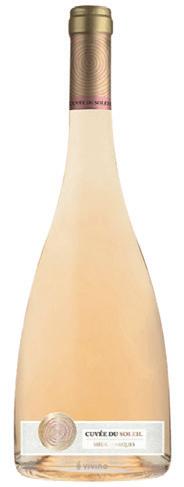

Delightfully dry, crisp, gooseberry-scented white from the Loire, great as an apéritif or with seafood.
Sieur d'Arques 'Cuvée du Soleil', Pays d'Oc 2022, offer price £11.49, case price £137.88

A blend of Grenache and Pinot Noir: pale and bone dry, with a tang of redcurrants. Great value.
Château Pierrefitte, Lalande-de-Pomerol, Bordeaux 2019, offer price £14.99, case price £179.88

I thought I was too long in the tooth, my palate too jaded. But then it happened: a blinding flash, an alcoholic epiphany. I discovered a new drink.
Well, maybe not exactly new. Cachaça, a spirit made from sugar cane and the national firewater of Brazil, is the hooch in a Caipirinha, a cocktail that an old
But the last cachaça that Vini showed me is a bargain. Weber Haus Amburana (threshers.co.uk, £32/100cl) has the classic cachaça aromas of banana and freshly-cut grass, interwoven with a sweet, spicy aroma from a year’s ageing in amburana casks. Part of the fun of the largely unregulated cachaça industry, says Vini, is that producers experiment with different indigenous woods for ageing the spirit, and amburana’s high coumarin content adds an alluring edge.
It is not a cachaça to bash with limes and sugar – Abelha Silver is best for that. But, as the rain lashes down from slategrey skies in west London, it is the perfect drink to sip while bemoaning the British summer. As they say on Copacabana Beach, saúde!
Smooth, plummy fruit from Merlot and a herbaceous crunch from Cabernet Franc: classic claret.
Mixed case price £155.88 – a saving of £59.03 (including free delivery)
HOW TO ORDER

Call 0117 370 9930
Mon-Fri, 9am-6pm; or email info@dbmwines.co.uk
Quote OLDIE to get your special price. Free delivery to UK mainland. For details visit www.dbmwines. co.uk/promo_OLD
NB Offer closes 30th September 2023.
DRINK BILL KNOTT MY BRAZILIAN
The Oldie September 2023 75
Wine
'What a coincidence. I love chips, too’
SPORT JIM WHITE
WREXHAM MEETS HOLLYWOOD
During football’s ever-shortening summer recess, Manchester United’s under-21 side played Wrexham in a friendly at the Snapdragon Stadium in San Diego.
This may have seemed the very definition of a pointless exercise, but an astonishing 35,000 people turned up to watch the game unfold.
And here’s the extraordinary thing: the overwhelming majority weren’t there to support English football’s most storied club (albeit a junior version). They were there to watch Wrexham, an outfit that for the past 14 seasons has languished in the fifth tier of the game.
And they weren’t just expat Welshmen holidaying in California. Thousands of them were Americans, drawn to watch the side at the centre of one of the most interesting experiments in sport.
And how thrilled they were to see their adopted team win 3-1. Even if many of them hadn’t a clue what was going on.
When the Hollywood pair Rob McElhenney and Ryan Reynolds bought a controlling interest in Wrexham two years ago, they didn’t do it out of some altruistic urge to restore the place to former glories. There isn’t much in the way of former glory in this ex-industrial town in north Wales.
The place was deliberately chosen because of its lack of obvious distinction. It was chosen to provide content for a documentary series built on the drama of two fish-out-of-water owners trying to inject new meaning and purpose into a backwater.
As a premise, it has proven more than a success. Welcome to Wrexham is a worldwide ratings triumph. Across the globe, hundreds of thousands of viewers have watched the owners engage with the project.
It has completely altered the framework. When Reynolds and McElhenney bought the club, the sponsor on the front of the team shirt was Ifor Williams, a supplier of agricultural trailers. Within two years, United Airlines paid several million dollars to have its logo associated with a worldwide television hit.
Suddenly, Wrexham, a club that as recently as 2011 had been rescued from financial oblivion by its fans rattling buckets outside the turnstiles, was in the money. The evidence of improvement was everywhere, not least in the empty old stand at their Racecourse Ground
home, condemned 15 years ago. Under the new bosses, it is finally being knocked down. The rebuild will transform the place.
In a sense, those first couple of seasons under Hollywood ownership were the easy bit. The owners wisely steered much of the new revenue streams into the infrastructure, hiring the best manager and players available, ensuring that the long-held ambition of a return to the football league was achieved well within their initial timetable.
As a climax to a television series, the boys parading the National League trophy in April was the kind of ending a Hollywood scriptwriter would be pushed to match. What happens now is the tricky part. To maintain the film narrative for ensuing series, an upward trajectory is essential. Now a place in League Two has been secured, there are three more promotions required to achieve the proposed ambition of arrival in the Premier League.
With every step upwards, the underdog story dissipates and the romance is diluted. Rivals will resent the moneybags arrivistes. Pundits will nitpick about the style of play. Some diehard old fans will moan about how it is impossible to buy tickets for home games because of the invasion of foreign fans. Rather than a cause célèbre, Wrexham will become a bête noire.
MOTORING ALAN JUDD DREAM MACHINES
It stands for Build Your Dreams. Not a promising start, especially as some of its models have Build Your Dreams written across the boot-lid.
Almost as unpromising is a model range which includes names such as Seal, Dolphin, Han, Tang and Seagull. But we’ll hear and see a lot more of them soon.
BYD is no minnow start-up. Last year, it was the world’s largest manufacturer of plug-in cars – 1.85 million – employing 600,000 globally with 28,000 patents registered. And it’s not just cars – it does solar panels, fork-lifts, trains and much else. It’s the second-largest producer of high-voltage vehicle batteries, it makes the batteries for the Tesla Model Y and there’s a one-in-five chance that it made your phone battery.
It can produce, in-house, almost every component of their vehicles, from semiconductors, to interiors, engines electric and combustion – just about everything, in fact, apart from glass and tyres.
It is, of course, Chinese, based in Shenzhen. It has achieved those figures without a presence in North America but it’s made a start in Europe. Like it or not, we’re going to have to know about it. Its marketing strategy is not to produce value-for-money cars such as MG – also Chinese-owned – but to produce cars that are ‘attainable but premium’, competing with Kia and Hyundai.
Nor, despite the fact that its design team is led by Wolfgang Egger, formerly of Audi and Alfa Romeo, does it yet seem concerned to adapt its products to western tastes – again, unlike MG. What’s coming our way is what sells in China.
But that may change. If it finds European markets resistant, it will have the financial and industrial muscle to switch course rapidly.
It may, of course, find some buyers reluctant to send their money to an increasingly intolerant and expansionist Chinese state. But if its products are good value and if, like MG, it offers seven-year warranties, it will find plenty of other buyers who are less squeamish.
All of which makes a sad contrast with our own motor industry. We – once the largest vehicle exporters in the world – are now the minnows, struggling to build battery factories and unable to produce high-grade semiconductors in any quantity.
Recently JLR – Jaguar Land Rover –announced its Reimagine strategy, designed to reposition itself as a luxury manufacturer. This involves reducing the dealer network and moving to an agency sales model intended to engender a ‘much warmer, much more hospitable, much more relaxed’ sales relationship – more ‘conversational’ and less ‘transactional.’
It also removes the possibility of haggling, which I find the decisive bit of the conversation when I’m buying –sorry, transacting.
It is also trying to rejuvenate the Discovery as one of its three standalone brands. But the question it has to answer is, why buy a Discovery rather than Range Rover or Defender? Because it’s cheaper? Sounds a bit transactional.
And what of Jaguar, that once-great brand? It seems to have lost its way since 2012, when it ditched the beautiful, ground-breaking, hybrid-electric 205mph C-X75 supercar.
At least JLR are trying to do something. Maybe it’s right to concentrate on being a luxury brand. Maybe that’s the only option with such behemoths as BYD slouching towards Coventry to be born.
76 The Oldie September 2023


Matthew Webster: Digital Life Teething troubles with Bluetooth fairy
I yield to few in my enthusiasm for technological advance. But even I think that, in the race to become a wholly digital world, we can go too far.
After years of being badgered by my dentist, I bought an electric toothbrush. I was baffled by the range.
The recommended brand offered a dozen options, with a choice of four different brush heads for each. The price range was eye-watering, too, ranging from £40 (which is bad enough) to an astonishing £500 – for a toothbrush.
Naturally, I bought one at the bottom end of the range, and the cheerful delivery fellow delivered it the next day.
Then the digital overkill began. To my slack-jawed astonishment, it came with instructions to download an app. My new
Webwatch
For my latest tips and free newsletter, go to www.askwebster.co.uk
toothbrush would then connect to the phone, using Bluetooth (a singularly inappropriate name – blue teeth are what I’m trying to avoid).
It also came with a nine-page instruction book – a toothbrush with an instruction book!
As your diligent Digital Life correspondent, I dutifully downloaded the app. After a few false starts, my phone and toothbrush began to converse. But what were they saying?
It turns out that the app is little more than a stopwatch, which logs the amount of time I brush my teeth and then issues patronising messages – either congratulations (‘You’ve won a medal’) or admonishments (‘Try brushing for longer’). It then saves the details of what it calls my ‘sessions’ onto a database.
It also comes with advice to keep my phone and brush close to each other, so that the Bluetooth link is not lost, but also to make sure that the phone is in a dry place. I will, of course, be using the brush in my bathroom, not known for its aridity.
I shall uninstall this app. I’m perfectly capable of working out how long I have been brushing without its help, and I certainly don’t need a record of brushings, either here or in the cloud. Why on earth would I ever look at it?
I will happily try to solve your basic computer and internet problems. Go to www.askwebster.co.uk or email me at webster@theoldie.co.uk
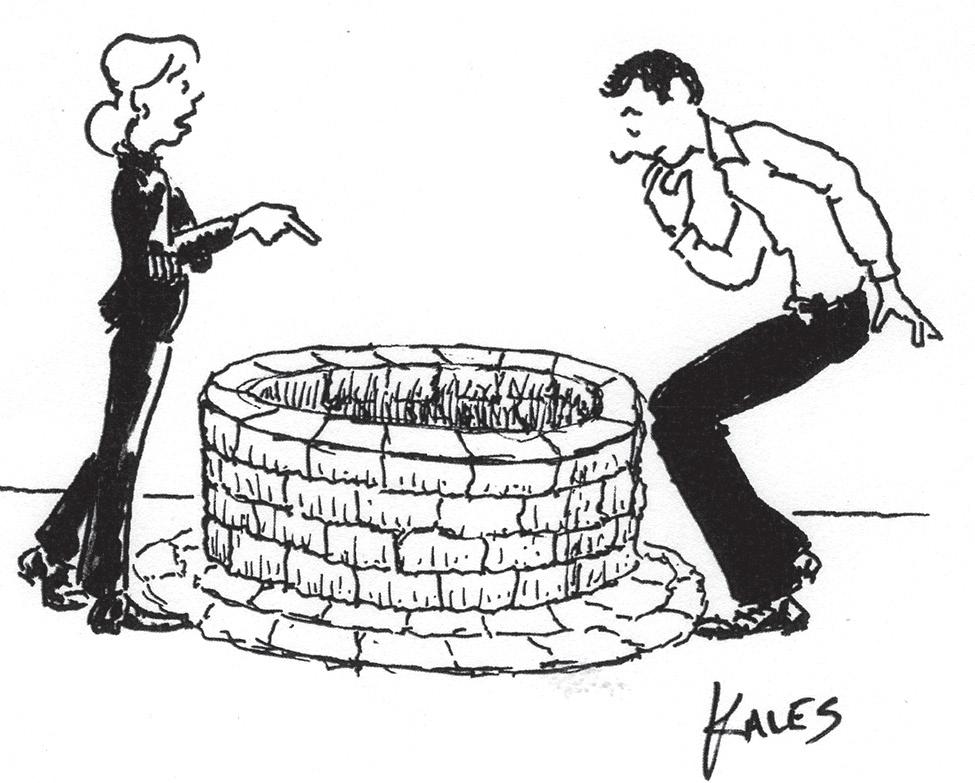
It’s not the first time I have come across this sort of nonsense. An otherwise highly successful young professional chap I know wears a health-monitoring bracelet, which he
says keeps a check on his vital signs. When you ask him how he feels or how he slept, he immediately refers to his phone to find out.
What about the people who are obsessed with counting the steps they take, using an app on their phone? I’m all in favour of taking plenty of exercise, but a person doesn’t need an app to tell them they’ve taken it.
I was impressed by Anthony Albanese, the Australian Prime Minister, who suggested you should ‘turn your phone off every night for five minutes – do it while you are brushing your teeth’.
Restarting your phone gives it a chance to update itself to the latest secure state – very good advice. However, it made me laugh that he suggested doing it while brushing your teeth. I hope the American makers of my toothbrush don’t get to hear about it.
They’ll probably sue the poor man for cutting off the brush from its digital partner.
‘It only takes Bitcoin’
Margaret Dibben: Money Matters
Beware the crypto-crooks
When Tom Cruise’s character in the new Mission Impossible film offers payment in cryptocurrency, it’s time to take a closer look at this little-understood phenomenon that exists only in the ether. Crypto (for short) was created as a way of making payments securely without using banks. It is a digital currency, not a physical one, although some people have produced physical coins or tokens for fun or as collectibles.
Crypto has also gained recognition
through sponsorships with Premier League football clubs, which used to be done by the alcohol, tobacco and, not for much longer, gambling industries.
In contrast to traditional payment systems, crypto is not usually backed by any tangible assets such as sterling or gold, though a few, called stablecoins, link to stable assets such as the US dollar.
There are now more than 22,000 cryptocurrencies. Among the best known, the first was Bitcoin created in
2009, Ethereum is used for complex financial transactions and Tether is a stablecoin.
While the Bank of England oversees sterling, giving it a certain degree of stability, cryptos are run by individual people or companies. Some of them reveal nothing about who they are or even where they are based.
Because no one supervises crypto, the price is volatile. It can – and does – rise and fall quickly and dramatically, based
78 The Oldie September 2023
online tool for organising meetings with groups – if you can persuade them to use it.
Doodle.com An
from around the
webcamtaxi.com Live webcams
world.
on little more than rumour and emotion.
Speculators saw this as an opportunity to make money and started treating crypto as an investment. Some made huge fortunes; others lost millions.
Cryptoassets (the overarching term) have now become so established that the government is planning to regulate the industry. A few months ago, the Treasury Select Committee called for unbacked cryptocurrencies to be regulated as gambling, saying they have no intrinsic value, serve no useful social purpose, consume large amounts of energy and are used by criminals in scams, fraud and money-laundering. Crypto’s trade association, CryptoUK, disagreed.

In October, the Financial Conduct Authority is introducing advertising rules governing the marketing of cryptoassets.
Firms must give clear risk warnings and allow a 24-hour cooling off period for first-time buyers. Refer-a-friend bonuses will be banned.
Under the money laundering regulations, it has already closed down 26 unregistered and illegal ATMs this year. The cash machines were a way of converting sterling to crypto and making withdrawals but were more likely run by criminals just stealing money.
While the crypto world can be seen as a Wild West, the currency is still treated as a capital asset. So any profit you make
from crypto is subject to capital gains tax, whether you sell your holding or use it to buy something. Opportunities to spend crypto are limited. Some retailers accept crypto online, you can use the currency to fund online poker accounts, and a few charities accept crypto donations. The easiest way to shop is with pre-loaded cryptocurrency debit cards or gift cards.
But here’s the bottom line: if anything goes wrong, you will almost certainly get no support or compensation from the Financial Services Compensation Scheme or the Financial Ombudsman Service.
You will simply lose all your money. Take great care.
Come and join us for a tour of Copenhagen and North Denmark with Soren Tholstrup 6th to 11th June 2024
and French art from the 19th and beginning of the 20th century. Lunch at Ordupgaard.
Saturday 8th June
Amalienborg and opera
Morning tour of the Amalienborg museum, in the heart of the city. We will see Christian X’s study, the Fabergé Chamber and much else. Lunch at Nyhavns Faergekro. Then Tristan and Isolde at the Opera House.
Sunday 9th June
Little Mermaid and Rosenborg Slot
Come and discover the Danish delight that is ‘Wonderful, wonderful Copenhagen', with bon vivant Soren Tholstrup, the ultimate guide to his homeland. The Oldie is always keen to have real insider knowledge, and Soren, who is a wine merchant by day, knows all the good restaurants and bars.
We will explore some of the ancient and modern sights of this majestic capital and take in excursions to the lesser-known parts of Greater Copenhagen, such as the Louisiana Museum of Modern Art, Ordrupgaard in Charlottenlund, the world-renowned Tivoli Gardens and the Glyptotek in the heart of the city.
We'll also enjoy a performance of Tristan and Isolde at the Opera House … Oh, and there will be the opportunity to have the famous Danish hot dog every day.
We are staying at the Copenhagen Strand (www.copenhagenstrand.com),
which is on the Copenhagen harbour front. The Oldie's publisher, James Pembroke, will be accompanying the tour.
Thursday 6th June
Departure and check-in
Depart 10.10am from Heathrow with BA; arrive 1.10pm. Check in to Copenhagen Strand. A late afternoon visit to the David Collection, a small museum with a world-class collection of 17th- to 19thcentury European, Islamic and Danish Early Modern art.

Friday 7th June
Frederiksborg Castle and Charlottenlund
Depart for Hillerod to visit Frederiksborg Castle, the largest Renaissance palace in the Nordic region. Then, onto Charlottenlund to visit the Ordrupgaard art museum, a superb pearl of the most important Danish
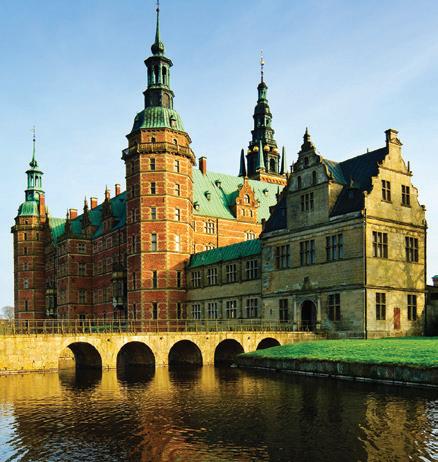
10am – depart on private boat trip with Hey Captain to see the Little Mermaid and other noteworthy sights in Copenhagen. Afternoon visit to the crown jewels at Rosenborg Slot.
Monday 10th June – Karen Blixen’s house and Sletten Kro
10am – depart for Karen Blixen’s house at Rungstedlund via the beautiful coastal road overlooking Sweden. Then, depart for lunch at Sletten Kro and private tour of Louisiana Museum of Modern Art.
Tuesday 11th June –
Glyptoteket and home
10am – visit Glyptoteket, the private art collection of Carl Jacobsen, the son of the founder of Carlsberg breweries. The museum contains ancient and modern art, plus a magnificent winter garden. It’s situated right next to Tivoli Gardens where we will see the roses peaking. 4.30pm BA flight departs. 5.30pm arrive at Heathrow.
HOW TO BOOK: Call 01225 427311 or please email Katherine at reservations@theoldie.co.uk. Price per person: £2,450 which includes all meals, wine with meals, transport and entrances. You need to book and pay for your own flights. Single supplement: £300. A non-refundable deposit of £750 will be required, with the full balance due on 1st March 2024.
The Oldie September 2023 79
Soren Tholstrup; harbour and Frederiksborg Castle
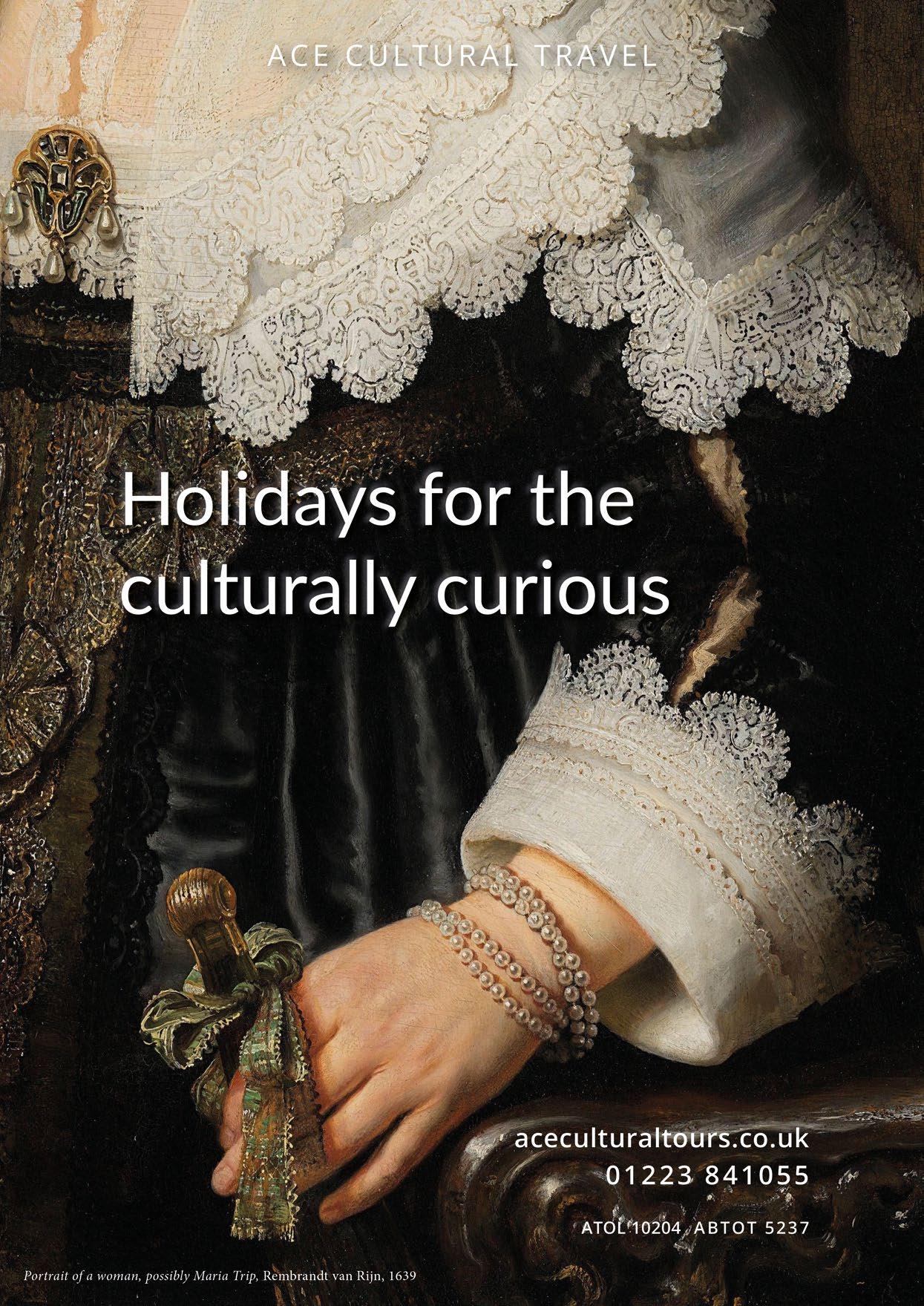
The Yellow Wagtail
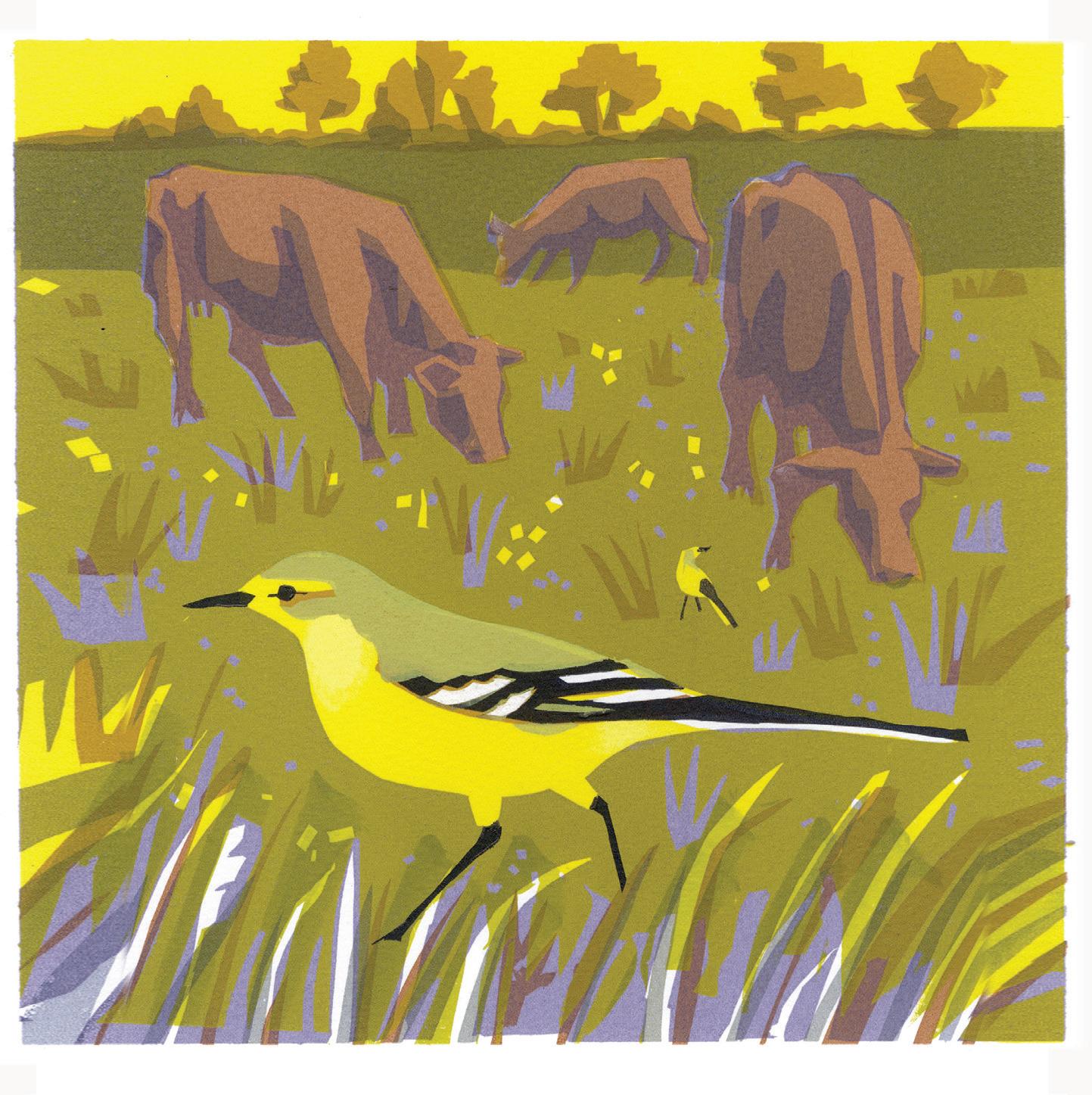 by john mcewen illustrated by carry akroyd
by john mcewen illustrated by carry akroyd
One of the folklore names for the yellow wagtail (Motacilla flava Flavissima) is ‘sunshine bird’ – flavissima means ‘yellowest of all’.
The male beams its presence, when it finally appears as a summer migrant, from tropical Africa – bright as a dandelion in its preferred marshland or rough pasture.
The artist Charles Tunnicliffe in his Summer Shorelands Diary reported scanning the April ‘bird traffic’ on his Anglesey foreshore and immediately resting ‘on a spot of bright yellow’, soon identified as a male yellow wagtail.
That was 70 years ago. Today, like so many insect-feeding birds, it has drastically declined – in its case, by three-quarters, to 19,500 territories. Unlike the pied wagtail it is not seen in towns, nor by the rivers frequented by the less vividly yellow grey wagtail.
Marshland and water meadows are its favourite habitats, both decimated by modern farming. One helpful adaptation is its willingness to breed in potato fields – the broad leaves shelter its fibrous ground nest, and the furrows offer an escape route.
Even in Tunnicliffe’s day, it was seen as a passage migrant in Wales. West and north Britain were never its preference. It holds on in the Scottish Borders, but its strongholds are East Yorkshire, Lincolnshire, the Fens, the Norfolk Broads and Essex and Kent coastal marshes.
England is the headquarters for the most yellow of yellow Motacilla flava wagtails – but British bird-lovers, when abroad, should be alert to the abundance and geographical reach of 17 Motacilla flava sub species, which migrate from Africa to breed in the summer across Eurasia, India and south-east Asia.
Fragmentation may have been caused by separations in the Ice Ages.
Males, especially, have evolved marginally different head markings; among them, the blue-headed yellow
wagtail (M. f. flava) in mainland Europe; the grey-headed yellow wagtail (M. f. thunbergia) in northern Scandinavia, and so on.
Science may one day prove that notably distinctive cases belong to other wagtail species altogether. Classification is subject to alteration. In my 1937 edition of W H Hudson’s British Birds, the yellow wagtail is Motacilla rayii
He quotes Henry Seebohm (1832-95), Sheffield steel magnate, ornithologist, bird artist and early European advocate of the American trinomial classification of sub-species: ‘Its active, sylph-like movements, and its delicate form and lovely plumage, make it a general favourite.’
It was certainly the literal highlight of this column’s illustrator Carry Akroyd’s and my visit to Kent’s Elmley Marsh
last year. Males arrive ten days ahead of the paler, suitably camouflaged, ground-nesting females. Half a dozen spangled the water-broken terrain into the far distance.
What Thomas Hardy wrote of wagtails in general applied that day:
‘The wagtail gazed, but faltered not In dip and sip and prinking.’ From Wagtail and Baby
What we did not see was the undulating display flight of curves and circles, flashing gold brilliantly contrasted with black tails edged with white feathers. The breeding season over, families join forces to form substantial flocks for the southern journey to Africa through August and September, a few stragglers lingering into October.
The Oldie September 2023 81
CARRY AKROYD
Travel

A taste of Château Sussex
William Cook slurps his way round the county’s vineyards and tops up his spirits with a Gwen John show
Here at Wiston, a lush vineyard amid the rolling hills of the South Downs, Kirsty Goring is explaining why Sussex produces such fine wine.
It’s not just the south-facing slopes and the mild climate. As she tells me, over a flute of fizz, it’s a rare combination of three types of soil: sand, clay and chalk.

‘It has amazing terroir,’ says Kirsty, who runs this estate with her husband, Richard, and his parents. ‘You can get some wonderfully balanced wines, with different grape varieties.’ I’m no wine buff but as I glug down a glass of their Blanc de Blancs (‘biscuity notes, green apples and flinty minerality’, apparently) and then another, I feel inclined to agree.
The Goring family have farmed this land since 1743, and they’ve been making wine since 2006. Over a lunch of local meats and cheeses in their swish restaurant, I sample several more and after careful consideration, I come to the conclusion that Sussex still and sparkling white wines are just as good as champagne or Chablis. The only problem is that they cost about twice the price.
Visiting a Sussex winery is more of an experience than a shopping trip. You don’t come here to hunt for bargains. You come for a grand day out. You do a tour and a tasting, have lunch and exit through the gift shop, laden down with

82 The Oldie September 2023
clanking bottles. You can even stay the night. Wiston has a range of stylish lodges, as do Tinwood and Ashling Park, two other Sussex vineyards
Sussex has never enjoyed the celebrity of more touristic counties. One reason was the asinine decision to divide it into two dreary governmental districts, West Sussex and East Sussex, robbing this ancient county (the Kingdom of the South Saxons) of its archaic romance.
The other reason is its proximity to London. It’s so easy to do a day trip, by road or rail, that people from London or the Home Counties don’t stay the night.
Sussex boasts loads of cultural landmarks, from Brighton Pavilion to the De Le Warr Pavilion, from Lamb House (home of Henry James) to Charleston (home of the Bloomsbury Group), and the best way to see them is to stay over.
I begin my (vini)cultural tour of Sussex at Pallant House in Chichester. This gallery houses one of the finest collections of 20th-century British art.
The current exhibition (until 8th October) is a fascinating Gwen John retrospective, which sheds fresh light on the enigmatic Welsh painter.

The permanent collection is even more compelling – a virtual Who’s Who of British 20th-century artists, from Peter Blake to Lucian Freud. The building is an artwork in its own right – not only the original Queen Anne house, but also the unobtrusive new extension, built in bold, modern style, but to the same scale, in modest brick.
We stop for lunch at Tinwood Estate, a winery a few miles from Chichester. Established in 2007 by the Tukker family, it’s the same combination as at
Wiston – a vineyard tour, a few wines and loads of delicatessen-style grub. We sample a brut and a rosé, each one a blend of chardonnay, pinot noir and pinot meunier.


In the afternoon, we drive to West Dean College of Arts and Conservation. This extraordinary mansion was the home of eccentric poet and surrealist patron Edward James.
Nearly 40 years after his death, it’s still imbued with his flamboyant personality, a mélange of stuffed animals, surreal artworks and antiques. It’s not open to the public but anyone can sign up for courses, in a range of applied arts.

We stop for an early supper at yet another winery – Ashling Park Estate. The restaurant is upstairs, overlooking the vineyard. I gobble up my sea bream, broccoli and potato cake, looking out across a sea of vines. By now I’m feeling a bit the worse for wear. I’ve forgotten to spit, not swallow.
After dinner, we drive back into town for a performance of The Sound of Music at Chichester Festival Theatre, one of the best regional theatres in the country. I adore the film. If anything, the play’s even better than the movie. I bet it gets a West End transfer.
I spend the night at the Angel, in the quaint market town of Petworth. With its weathered beams and low ceilings, it’s a classic medieval coaching inn, but the bedrooms are a lot smarter than most olde worlde pubs. My comfy room has a big double bed and a large bath.
The last stop on my trip is Newlands House Gallery, a short walk from the Angel. This Georgian townhouse has only been an art gallery for three years (it used to be an antique shop) but you’d never know it. It feels like an established institution. The current exhibition (until 7th January) is a riveting display by the late American photojournalist Eve Arnold – everything from intimate portraits of Marilyn Monroe to stark studies of Harlem street life.
To find such an important gallery in such a small town shows what a wealth of art and culture lies hidden away in this sunny county – from Glyndebourne to Eastbourne, from Brighton to Bognor.
Next time, I’ll come for longer. I’d love to revisit the George in Rye or the Knowle in St Leonards. On the train back to London, nursing an afternoon hangover (the worst sort), I’m already planning my return trip.
For more information about Sussex, visit www.sussexmodern.org.uk
The Oldie September 2023 83
TENBY MUSEUM AND ART GALLERY COLLECTION / THE NATIONAL MUSEUM OF WALES
Clockwise from above: Ashling Park vineyard; Gwen John’s The Japanese Doll; West Dean College of Arts and Conservation. Below: Wiston vineyard
There ain’t nothing like a hound dog
lucinda lambton
‘Boatswain is dead!’ lamented Lord Byron to his friend Francis Hodgson on 18th November 1808. ‘He expired in a state of madness… after suffering much, yet retaining all the gentleness of his nature to the last; never attempting the least injury to anyone near him.’
Boatswain was Byron’s beloved Newfoundland dog. Having followed the postboy to Mansfield, he was bitten by a rabid dog and struck down by the disease. His master was distraught.
According to his friend and biographer, Thomas Moore, Lord Byron
was so little aware of the nature of the malady that, more than once, with his bare hand, he wiped away the slaver from the dog’s lips during its paroxysms.
Byron had inherited Newstead Abbey – originally a 12th-century priory, granted to his ancestor by Henry VIII in 1539 – when he was only ten years old. He then also became the 6th Baron Byron of Rochdale. The house was leased out until he was 20, when he started to live in it for the first time.

Boatswain died almost immediately and Byron, no doubt also stirred by his
great inheritance, determined to bury the dog on what he thought was the site of the high altar of the priory church, reduced to ruins by his ancestors.
The elegant, urned plinth was designed in the dog’s honour to stand above three vaults: one for Boatswain, another for Byron himself and the third for his manservant Joe Murray. Murray would have none of it. Although he did not object to lying with Byron, he most certainly did mind lying next to a dog.
In fact, when Byron died of a fever in Missolonghi, Greece, in 1824, fighting for
84 The Oldie September 2023
Overlooked Britain
When Lord Byron’s dog died, the distraught poet composed a heartbreaking epitaph
TRACEY WHITEFOOT / TRAVELBILD /ALAMY
So we’ll go no more a-roving: Boatswain’s tomb at Byron’s ancestral home, Newstead Abbey, Nottinghamshire
Greek independence, Newstead was sold and Byron had to be buried nearby at St Mary Magdalene’s Church, in Hucknall, Nottinghamshire.
It was years before there was a suitable memorial to the poet. His friends commissioned a statue by Albert Throvaldsen, but Byron was considered an unacceptable addition to either Westminster Abbey or St Paul’s Cathedral.
Such was the scandal that the American Robert Ripley, of Ripley’s Believe it or Not!, published a cartoon of Boatswain’s memorial, with the caption, ‘Lord Byron’s dog has a magnificent tomb while Lord Byron himself has none.’
Incredibly, it was not until 1969 that Poets’ Corner in Westminster Abbey agreed to commemorate him with a stone slab. The statue ended up at Trinity College, Cambridge.
Boatswain had not been Byron’s only animal at Newstead. There were two other Newfoundland dogs with whom he enjoyed a good swim. The poet would get into the boat with his two noble Newfoundland dogs, row into the middle of the lake and then, dropping the oars, tumble into the water.
The faithful animals would immediately follow, seize him by the coat collar, one on each side, and bear him to shore. They have webbed feet which make them superb swimmers.
Then there was Byron’s bear. He was told at Cambridge that no dogs were allowed. So he dodged the rules and kept a bear in his rooms. It came to Newstead – and unnerved the Newfoundland dogs.
So great was the company of animals Byron kept in Italy that Shelley called it ‘Byron’s Zoo’.
In 1818, while visiting Byron in Ravenna, Shelley made a ‘catalogue’ of what he saw: ‘Ten horses, eight enormous dogs, three monkeys, five cats, an eagle, a crow and a falcon; and all of these, except for the horses, walk about in the house, which every now and then resounds with their arbitrated quarrels, as if they were the masters of it.’
Shelley supposed that this list was complete but, as he departed, he ‘met on the grand staircase five peacocks, two guinea hens, and an Egyptian crane’.
There were also four pet geese, one of which had been bought for Christmas consumption. For Michaelmas Day, Byron regularly resolved to have a roast goose and bought one.
But by the time he had fattened it for a month, the goose and he were such
good friends, that the bird did not come to the table, and another was purchased. His pet geese travelled with him in cages under his carriage.
One of his ‘enormous dogs’ was Lyon, a direct descendant of Boatswain. After his master died in Greece, Lyon accompanied Byron’s embalmed body back to England.

During the Byron family’s three centuries of the building and rebuilding of Newstead, Boatswain’s monument was the poet’s only contribution to the place.
The opening lines of Boatswain’s epitaph have recently been discovered to be by his old university friend John Cam Hobhouse:
Near this spot are deposited the Remains of one who possessed Beauty without Vanity, Strength without Insolence, Courage without Ferocity, and all the Virtues of Man without his Vices.
This Praise, which would be unmeaning Flattery
If inscribed over human Ashes, is but a just tribute to the Memory of BOATSWAIN, a Dog, Who was born at Newfoundland May 1803,
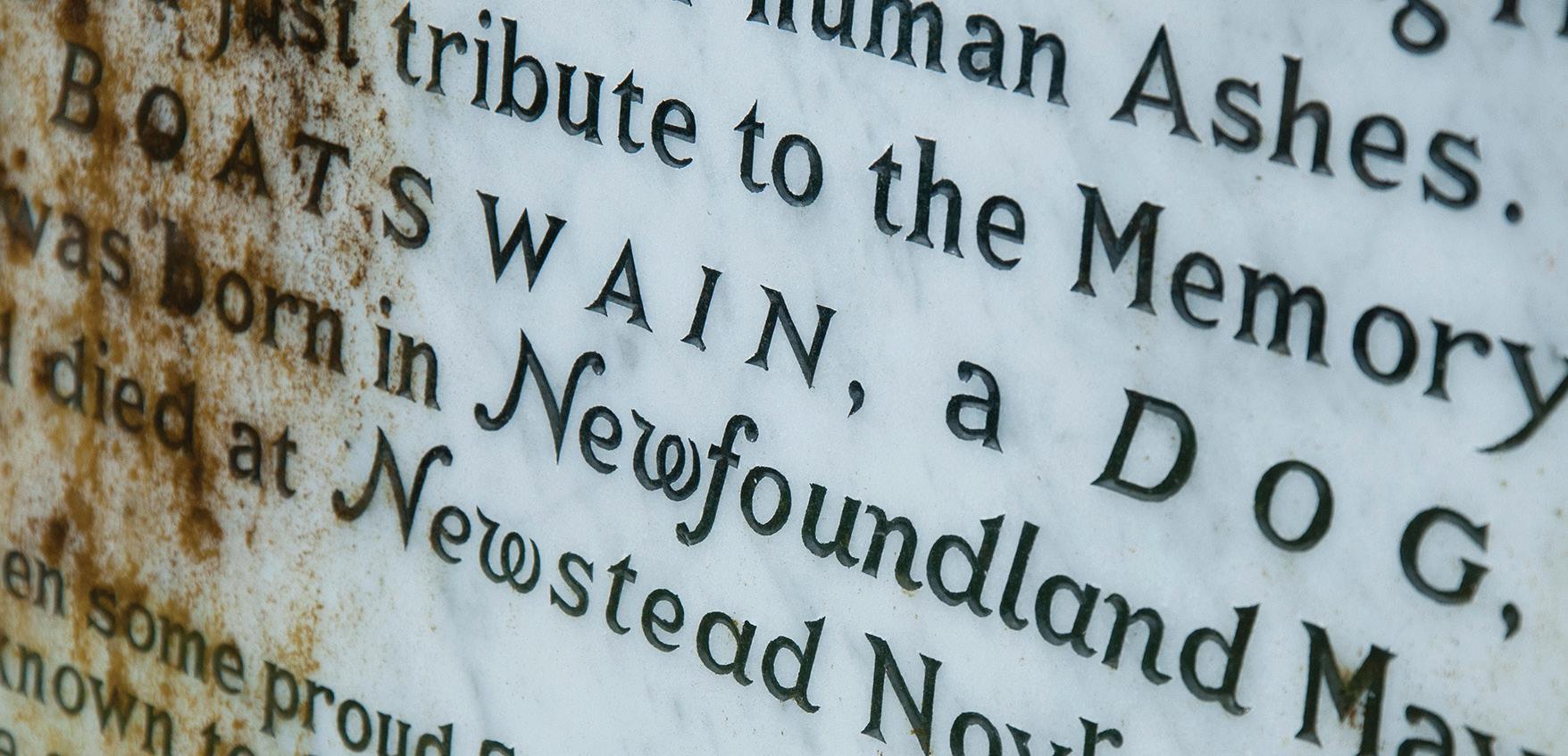
and died at Newstead Abbey Nov 18th 1808.
The verse in Boatswain’s epitaph was composed by Byron:
When some proud Son of Man returns to Earth, Unknown to Glory but upheld by Birth, The sculptor’s art exhausts the pomp of woe, And storied urns record who rests below:
When all is done, upon the Tomb is seen Not what he was, but what he should have been,
But the poor Dog, in life the firmest friend,
The first to welcome, foremost to defend,
Whose honest heart is still his Master’s own,
Who labours, fights, lives, breathes for him alone,
Unhonour’d falls, unnoticed all his worth,
Deny’d in heaven the Soul he held on earth:
While man, vain insect! hopes to be forgiven, And claims himself a sole exclusive heaven.
Oh man! thou feeble tenant of an hour, Debas’d by slavery, or corrupt by power,



Who knows thee well, must quit thee with disgust, Degraded mass of animated dust! Thy love is lust, thy friendship all a cheat,
Thy tongue hypocrisy, thy heart deceit! By nature vile, ennobled but by name, Each kindred brute might bid thee blush for shame.
Ye! who behold perchance this simple urn, Pass on, it honours none you wish to mourn, To mark a friend’s remains these stones arise;
I never knew but one – and here he lies
The Oldie September 2023 85
Byron’s epitaph to Boatswain
Boatswain by Clifton Tomson (1808)
On the Road
Jesus, Joseph – and cricket
Tim Rice tells Louise Flind about his collaborations with Andrew Lloyd Webber – and the sporting musical they wrote for the Queen
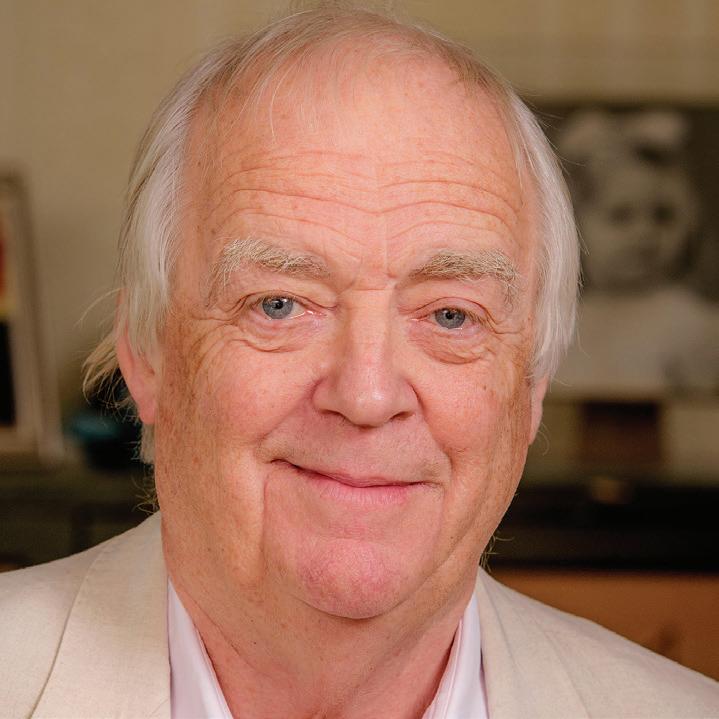
Is there something you really miss when you’re away?
English newspapers which I can read online but I prefer holding the big thing – and walking the dog.
What’s your favourite destination?
Sydney. Jesus Christ Superstar coincided with an Australia-West Indies Test match. It was a sell-out. I rang my blunt Aussie friend Bob Radford, and asked him to Superstar. He said, ‘No, I’ve heard it’s a f***ing awful show.’ He added, ‘Want to come to the Test tomorrow?’
What are your earliest childhood holiday memories?
Mudeford in the Fifties. We never went abroad until I was about 16, when my dad got a station wagon.
Did you write poems when you were little?
I wrote funny poems. One was about ‘Sweets coming off the ration/ Just like the pre-war fashion./ Crowds hurried to the shops / For something-something lollipops.’
When did you first start writing lyrics? At my prep school, when I was seven.
Did you find yourself listening closely to the words in songs?
Absolutely. Buddy Holly, Chuck Berry, My Fair Lady and West Side Story – albums that my parents had.
Did your mother encourage you to write? She didn’t say, ‘Get writing’, but she did write herself.
How did you become a lyricist?
I had a pop group at school, and I found I could sing a pop song tolerably well,
and I made a tape. I sent it off to record companies and eventually got a call from a music publisher, who said we think one of the songs is great. I had my first 45rpm record.
I had an idea for a book. My mum met publisher Desmond Elliott, who rejected the book but played my record and said, ‘I don’t like either.’ But he knew a young songwriter, Andrew Lloyd Webber...
What sparked the connection with Andrew Lloyd Webber?
Simply that he was very good, and he was working on a musical with a friend who was going to be something insane like a doctor. I wrote a couple of lyrics and Andrew loved them, and we were off and running.
Where did Joseph and the Amazing Technicolor Dreamcoat come from?
It was first performed in a school and Ian Doggett, the teacher, said the Bible’s always a good bet. My favourite story as a kid was Joseph.
Andrew dropped out of Oxford to become a composer. Were you both very confident and single-minded? Joseph got us a really good deal from an agent, which Andrew had no hesitation about accepting. I had a job and was rather conventional and weedy about it.
How does the collaboration process work?
The key thing is story. With Andrew, he wrote some great stuff and then I would stick words on that. Elton John writes music when he gets the lyric, and, with Alan Menken or Björn and Benny, it was story, music, lyrics.
Who have you most enjoyed collaborating with?
Andrew, because it was all new.
What line are you most proud of?
When my brother heard Superstar, he liked ‘To conquer death, you only have to die.’ The line ‘Don’t cry for me, Argentina’ wasn’t meant to be in the song version of it at all.
What’s the secret of great songwriting – rhyme, the meaning or the sound of the words?
A bit of everything.
Did you really write the musical Cricket? Prince Edward was working for Andrew Lloyd Webber. For the Queen’s 60th birthday in 1986, he asked if we could do a short show for her. It was about a batsman going out to bat and seeing his girlfriend going behind the pavilion with a racing man.
Did you find it easy to write the words for Joseph and Superstar, even though you’re not religious?
Superstar was the story of Jesus as seen through the eyes of Judas. In Joseph, there’s the odd reference to some almighty power in Close Every Door, but it’s actually a slightly cynical song.
What’s the most unusual place that one of your shows has ever been performed? Joseph was done in Siberia. Chess ran a long time in Russia – and it was a Cold War musical.
Where did you go on your honeymoon? Las Vegas.
Do you go on holiday?
Usually to Cornwall.
When you’re abroad, do you have a go at the local language?
I know a bit about the origin of Latin, Romance languages…
Have you got any travelling tips? Take half the luggage, and twice the cash.
In 2024, Tim Rice will tour with My Life in Musicals
86 The Oldie September 2023
Taking a Walk
Holy silence in Abbot’s Wood
patrick barkham
Rock-climbing, skydiving, abseiling –these are risky ways of getting from A to B. Taking a walk is not.
So, I wasn’t pondering the fragility of existence when I forayed with my son, Ted, into Abbot’s Wood, a forest near where the South Downs meet the sea.
When we set out, walking on a pavement beside a dual carriageway for a hundred yards, a BMW skidded on the wet road and slid onto the pavement 50 yards ahead. If we had departed a minute earlier, we would have been under its wheels.
Ted was very taken with this drama while I strode as briskly as possible to the steps away from the A22 and its roaring, sliding demon motor-monsters.
It was an unsettlingly windy, warm summer’s day, and we were grateful for the shelter of a path between high hedges. The wind tousled the trees above, but the noise of vehicles subsided. An occasional high-flying butterfly was caught in the wind, and a small tortoiseshell blew past us like a torn leaf.
Soon we were embraced by a cool wood of tall oaks with superbly twisted limbs. It was called Ogg’s Wood. Ogg is Gaelic for oak but ‘og’ is also ‘young’ in Gaelic. Why a wood in East Sussex bore a Gaelic name, I wasn’t certain, but it suited the place.
The oaks weren’t incredibly old – less than 200 years – but they groaned in the wind like old-timers, one pair locking branches like feuding neighbours.
Ted is nine and has been going to a weekly forest school since he was three, which makes him a veteran of the woods. They are his home far more than they are mine.
‘Let’s have a sit,’ he said after a while, choosing a low bank of dry Wealden clay beneath the oaks. ‘What can you hear? Birds calling. The wind blowing.’
An English woodland in July is a quiet place. Most birds fall silent, exhausted by child-rearing, and all we heard was the ubiquitous woo-woo of a woodpigeon, the chip of a woodpecker and a jay’s screech. The wind in the leaves was a dry
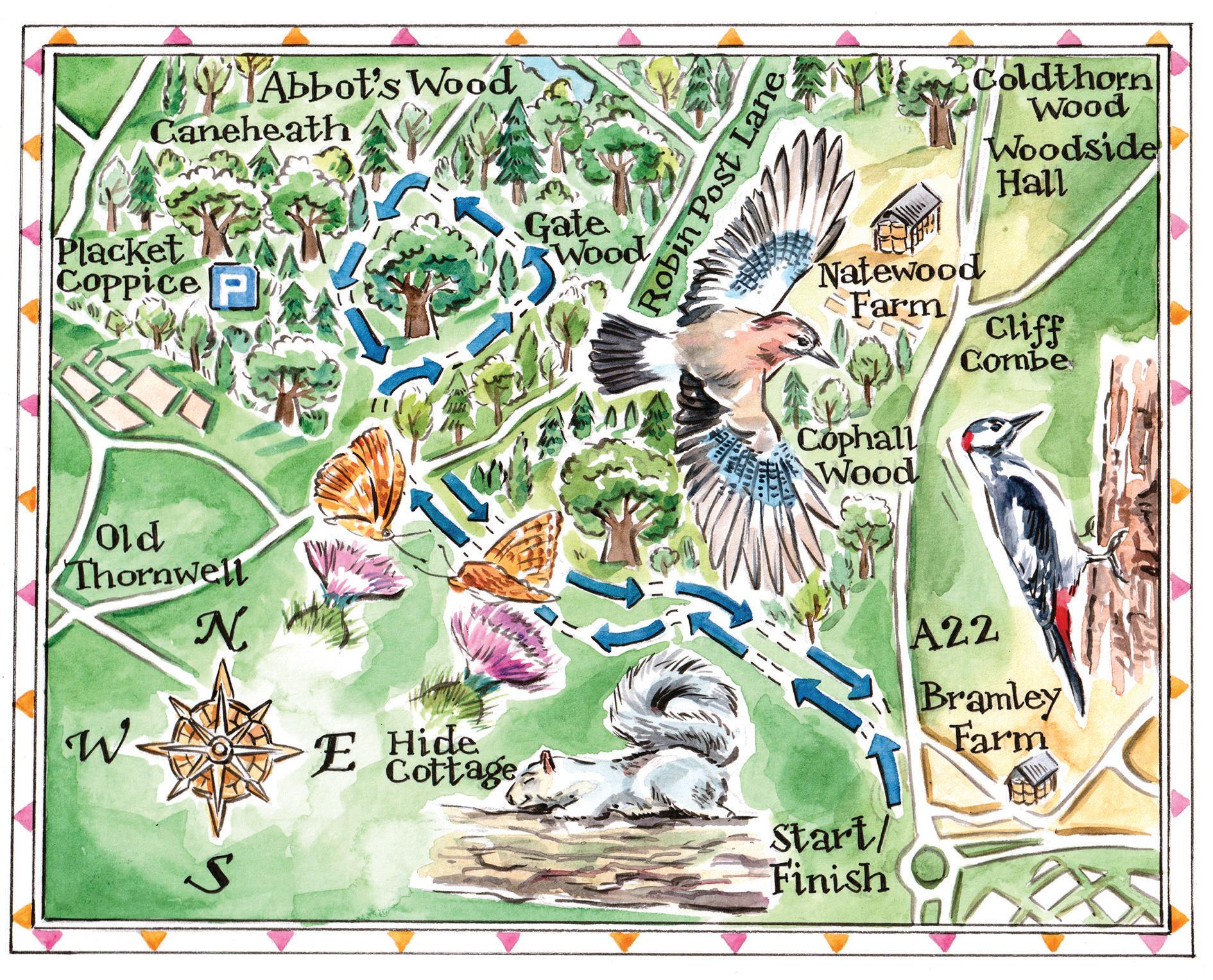
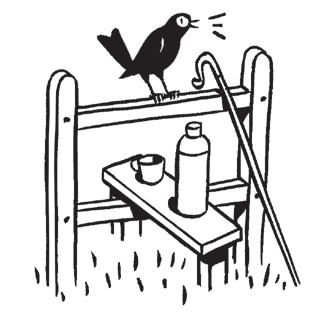
sound – the dark green oaks not rattling yet but their leaves moved with none of the sprightly flex of spring-green cover.
We followed a muddy clay bridleway up a gentle hill further into the wood, surprising a buzzard who left its low branch and scooted through overgrown hornbeam coppice. Each fabulous tree was a sculptural tangle of up to 20 stems growing from the coppiced base.
Looping back to the path skirting the southern boundary of the wood, we glimpsed the whalebacks of the South Downs through the trees. Closer up, Ted identified some King Alfred’s Cakes, a burnt black fungi which he explained were good for kindling a fire.
We crossed a dry stream and entered the Forestry Commission wood proper. Suddenly people appeared: dog-walkers and cyclists flashed along the forest rides.
Two silver-washed fritillaries glided down to nectar on the thistle flowers that edged the track. We decided that this sunny glade would be a good spot for another sit, and we admired the meadow
browns and gatekeepers who came and went with the sun.
Once we had been there for 15 minutes or so, we clearly became part of the wood because a grey squirrel nosed along the horizontal branch of a fallen sallow five yards from our noses.
Finding this spot to be sunny, the squirrel lay still on the branch and closed its eyes. I’ve never seen a wild animal fall asleep before, but we took it as a compliment.
Eventually, when we got up, the squirrel did too, it sauntered away, and so did we, thoroughly refreshed by our high-summer bathe in the calm of the forest.
You can park for free by the McDonald’s outside Polegate, like we did, and risk the pavement beside the A22, before following the public footpath west into Abbot’s Wood. Or, sensibly, pay to park at the Forestry Commission car park inside the wood at BN26 6SL and take a circuit from there.
GARY WING The Oldie September 2023 87

Across
1 Person who might drive you to work? (10)
6 Lead shot originally used with pitch (4)
10 Warehouse department stocking nothing (5)
11 Accumulation of building material (9)
12 Not worth considering affair after endless journey (8)
13 Bowler making you duck? (5)
15 Animal work needing huge amount of money (7)
17 Absolutely determined group lacking feeling? (4-3)
19 Made an effort, dropping leader as instructed (7)
21 Enthusiast with nothing working is a clown (7)
22 Anticipate answer, interrupting a humourist (5)
24 Old newspaper article about northern plant (8)
27 As it happens, cost varies with a thousand farm animals (9)
28 Type of Italian (5)
29 Barrier left by rejecting legislation (4)
30 Rock group gets none - he must be upset! (10)
Genius crossword 430 el sereno
Down
1 Respectable order (4)
2 6 may be great river flowing north (9)
3 Second time providing symbol on clothing (5)
4 Oddly, some must cover audit after planning sports ground (7)
5 Promised to be busy (7)
7 Crown jewels found here? (5)
8 Returning and staggering about European court (10)
9 Reportedly studied origin of Dubai docking facility with no hotel for 6 (3,5)
14 Wolf causing diversion on the way? (10)
16 Sensible about it, one’s clean (8)
18 Son prods staff representative (9)
20 One who’s given up, seeing Doctor No’s last sulky expression (7)
21 Interrupt what a burglar might plan (5-2)
23 Forger’s requirement sees knave regularly in trouble (5)
25 Value sees wife going for new direction (5)
26 Eager to promote new joint (4)
How to enter Please scan or otherwise copy this page and email it to comps@theoldie.co.uk. Deadline: 23rd August 2023. We do not sell or share your data with third parties.
First prize is The Chambers Dictionary and £25. Two runners-up will receive £15.
NB: Hodder & Stoughton and Bookpoint Ltd will be sent the addresses of the winners because they process the prizes.
Moron crossword 430


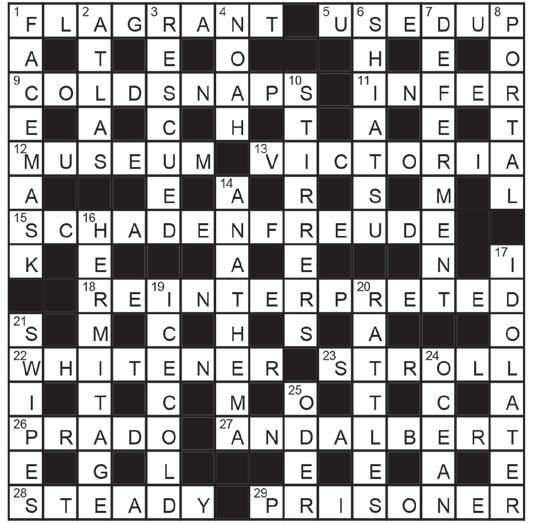
Across
1 Ground beef, pork etc (5)
4 Mare, stallion etc (5)
8 A flying saucer? (3)
9 Officially approve automatically (6-5)
10 Conjecture, reckon (7)
12 Plight one’s ___ (5)
13 Plasterer’s requirement (6)
14 Curiously oldfashioned (6)
17 Origins (5)
19 Mortified, remorseful (7)
21 Showing no feeling (11)
23 Racket (3)
24 Goggle box (5)
25 Merits (5)
Down
1 Social customs (5)
2 Essence, crux (3)
3 Ugly sight, esp. a building (7)
4 Youth ___, accommodation (6)
5 Eg Lamb or beef joint (5)
6 Large 4 valved sort of tuba (9)
7 Hotpots (anag) (7)
11 Supporter or advocate of cause (9)
13 Missile; scupper (7)
15 Hug nine (anag) (7)
16 Equality (in pay, for example) (6)
18 School of fish (5)
20 Measures of medicine (5)
22 Make a mistake (3)
428 solution
Moron 428 answers: Across: 1 Toots, 4 Wheat (Tout de suite), 8 End, 9 Information, 10 Lash out, 12 Trait, 13 Excuse, 14 Varied, 17 Blaze, 19 Impiety, 21 Imagination, 23 Gas, 24 Entry, 25 Épées. Down: 1 Trial, 2 Off, 3 Serious, 4 Wraith, 5 Evict, 6 Tentative, 7 Adopted, 11 Socialise, 13 Embargo, 15 Appease, 16 Airily, 18 Exact, 20 Yonks, 22 Ice.
Genius
The Oldie September 2023 89
Winner: Michael Hands, High Wycombe
Runners-up: Margaret Edwards, Maidstone, Kent; Annie Davis, St Asaph, Denbighshire



I was honoured to be asked to run the Stuart Wheeler Memorial Bridge week at Carol and Charlie Skinner’s delightful villa on Paxos. They were such generous hosts and the week could not have gone better (well, maybe I could have held a few more aces – these things do matter when you are playing for £20 per hundred). Here is a tricky Six Clubs – I was East.
Dealer South North-South
Competition
TESSA CASTRO
IN COMPETITION No 296 you were invited to write a poem called Leftovers. Daphne Lester gave a memorable picture of her grandmother shutting the cat in the larder by mistake. Erika Fairhead wrote in the voice of compost worms, ‘We thrive on plant material, / Old rags and bits of cereal.’ Mike Morrison pictured three old maids, ‘Hilda, Ena and Betty, three cowards to confetti’, at the funeral of a missed opportunity. Sue Smalley’s narrator declared, ‘I’m happy sitting quietly on my shelf. / A leftover relies upon herself.’ Commiserations to them and to I White, Hilary Caine, Basil Ransome-Davies, Katie Mallett, Stefan Badham and Max Ross; and congratulations to those printed below, each of whom wins £25, with the bonus prize of The Chambers Dictionary going to Peter Hollindale.
No one could die more tidily than she. No leftovers, no bills, no to-do lists Undone, no partner, child or family, No one to say, ‘She will be greatly missed.’
Her disappearance was exemplary.
Declarer ruffed West’s queen-of-spades lead in dummy then cashed the ace of diamonds, shedding a heart, and followed with the queen. I could see that if I ducked, declarer could discard another loser, then lead the queen of clubs, and I would be left without recourse. I therefore covered the queen of diamonds with the king.
Declarer ruffed away my king and ruffed a second spade. Gauging that diamonds were 4-2, declarer now led the queen of clubs. Should I cover with the king? Superficially, covering seems wrong, as you’ll lose your king (which is otherwise guarded and must score). However, if you don’t cover, declarer will remain in dummy and the jack-ten of diamonds can be enjoyed. I therefore sacrificed my king of clubs in the hope of winning two tricks in return.
Declarer won the ace and was happy to observe the fall of West’s bare jack. It appears he has two major-suit losers. But watch. Declarer leads out all his clubs, reducing to a four-card ending, in which declarer has ♠ A 8 and ♥ A Q. West must come down to two cards in each major, but declarer now cashes the ace of spades and exits with a fourth spade. West wins but his last two cards are ♥ K J and declarer’s are ♥ A Q. Slam made.
ANDREW ROBSON
She left just one rogue instant’s life behind.
Once at a crossing, waiting red to green, She sensed a brushing, something small and rushing, Felt fast truck, a push of air, horn blaring, Found her hand (what told it to?) clutching A shoulder. It’s a boy. By inches, breathing.
Bright-eyed, her hair regrown, safe now to hug, A girl thanks nurses; those who love her long
To thank the man whose new child cancer drug Has saved her life, as his, when little older, Was saved because some woman gripped his shoulder.
Peter Hollindale
Dirty little toaster with a crumb-caked toast rack, Heating up the naan bread left from yesterday.
Leftover curry, Eaten in a hurry, Straight from the fridge in its cheap foil tray.
Bill Palastre
Miss Fanshawe, who once played at Wimbledon, Miss Wilcox, bronzed by brash New Zealand sun,
Pick favourites to lead the PE teams, Whose brace-less teeth and thousand house points gleam:
The netball girls, those faultless, shining stars,
Already into boys, and wearing bras, Now expertly, with ruthless cut and thrust, Select their players from the rest of us. So, Am’s chosen – beaming with relief, Then Janet follows, pink with disbelief, The dreadful process coming to a halt At me and Mary, best friends by default. Bespectacled and shy, we’re good with books, And writing stories, never praised for looks.
All loyalty betrayed, I’m fit to burst: Pick me, I pray. But they choose Mary first.
Fiona Clark
Straggly scraps that long-legs leave are what we canines crave;
There’s nothing better for a growing pup. Our hearts leap up when we behold the morsels humans save
To feed us when we need our nightly sup. Saucepans are a dog’s delight when proffered to lick clean;
The meaty ones are tastiest, of course. Better still are messy plates where Sunday dinner’s been, Enough to amply fill a hungry horse. We have no pride, we’ll eat up all the gristle, bones and skin, We’ll scoff whatever tumbles at our feet. We’re not averse to scraping round the greasy roasting tin
Or gnawing on a bony lump of meat. Better human food by far, though destined for the trash, Than canine rubbish bulk-bought by the ton.
A leftover beats anything that costs a heap of cash, And makes a doggie’s dinner much more fun.
Jenny Jones
COMPETITION No 298 People do get in the way at stations with their cases and backpacks. A poem then, please, called Luggage. Maximum 16 lines. We cannot accept entries by post, but do send them by email (comps@theoldie.co.uk – with a postal address), marked ‘Competition No 298’, by Thursday 21st September.
The Oldie September 2023 91 North ♠ –♥ 7 6 3 ♦ A Q J 10 5 4 3 ♣ Q 9 7 West ♠ Q J 10 7 4 2 ♥ K J 10 2 ♦ 8 6 ♣ J East ♠ K 9 5 ♥ 9 5 4 ♦ K 9 7 2 ♣ K 6 5 South ♠ A 8 6 3 ♥ A Q 8 ♦ –♣ A 10 8 4 3 2 The bidding South
East 1 ♣ 2 ♠ 3 ♦ 3 ♠ Dbl Pass 4 ♣ Pass 4 ♠ Pass 6 ♣ end
West North

92 The Oldie September 2023 Mobility
To advertise, contact Monty on 0203 8597093 or via email MontyZakheim@theoldie.co.uk scc rate £45+vat. The copy deadline for our next issue is 4th September 2023















The Oldie September 2023 93
UK Travel









94 The Oldie September 2023 Overseas Travel
Wanted Genealogy Retired school inspector, Cambridge history graduate, genealogist for 40 years, researches and writes your family’s history. No task too big or small. Phone 01730 812232 for brochure, sample report and free estimate. YOUR ANCESTORS FOUND Wild Gardening
Jewellery
Services
Entertainment Video
To advertise, contact Monty on 0203 8597093 or via email MontyZakheim@theoldie.co.uk


scc rate £45+vat. The copy deadline for our next issue is 4th September 2023
Mobility Books & Publishing Music

The Oldie September 2023 95











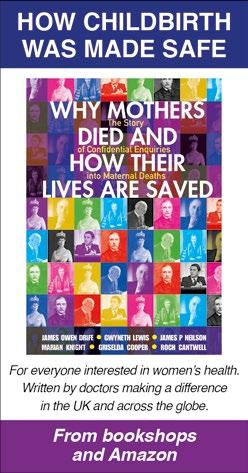


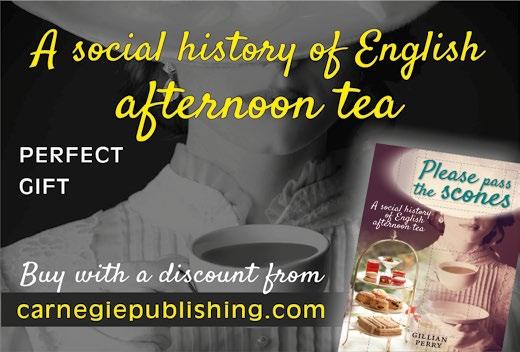
96 The Oldie September 2023 OLD POSTCARDS WANTED by private collector. Contact Grenville Collins. Tel: 020 7834 1852. Email: grenvillejcollins@gmail.com Books & Publishing Courses Computing Gifts Gifts Wanted Music Friendship & Dating
Health
To advertise, contact Monty on 0203 8597093 or via email MontyZakheim@theoldie.co.uk scc rate £45+vat. The copy deadline for our next issue is 4th September 2023




Societies
Health
Health


PETITE ORIENTAL BEAUTY Stunning Young Slim Classy Elegant and Friendly Lady. 2 mins from South Kensington. Call 020 7581 2144 IN/OUT calls.
UNDERSTANDING ATTRACTIVE CONTINENTAL LADY Offers memorable massage to discerning gentlemen in discreet Marylebone surroundings. 07932644459
BEAUTIFUL, BUSTY, MATURE BLONDE, University Graduate, unhurried massage in discreet surroundings. Call 07854 748 760
The Oldie September 2023 97
Home
Frenemy from Hell
QWe’ve been friends for a long time with a woman who refers to my wife and I as ‘the only family I’ve got’, even though we’re not related. Recently, however, she’s become manipulative and although most of the time she is sweet, on these occasions she rings us weeping saying we’re neglecting her and that she wants to kill herself.
My wife has become so stressed with reassuring her that she’s now on antidepressants herself. I really resent this friend for starting to ruin our lives.
Name and address supplied
ADog trainers always recommend that to train a dog that barks inappropriately, you ignore them when they bark and reward them with a treat when they’re quiet.
Try this method out on your friend
When she’s particularly needy, say, ‘I so sympathise but, as you know, nothing we do makes any difference. So stay calm and we look forward to seeing you next week.’ And that’s it.
I have had many friends to whom I have been a needless emotional slave. The only way to help is to, as they say in Al-Anon, ‘Detach with love’. Pandering to their emotional whims only encourages them. Although the chances of her killing herself are very, very slight, you have to harden your heart and say, ‘Well, if she does, she does. I couldn’t have done more.’ Your wife’s health and your marriage must come first.

Apply to university of life
QI’m a single parent and have worked hard to give my daughter a better start in life than I had. At one point, I was taken into
Ask Virginia
virginia ironside
care. So when she got a place at university, I was thrilled. But she came home for the holidays and now refuses to go back, saying she wasn’t learning anything. She wants to train as a hairdresser and earn money. I feel she is making the wrong decision. How can I get her to think again?
Anna G, Hastings
AI’m with your daughter on this one. I know many students who are, at the moment, being taught almost nothing – and wasting the best years of their lives. Admire your daughter for her ‘get up and go’. She could always do an Open University degree later in life. She’ll learn a lot of skills from hairdressing, not least how to deal with nightmare clients and be a reliable employee.
’Tis pity she’s a hoarder
QMy wife suffers from an obsessive compulsive disorder and hoards everything. Our house is stuffed with newspapers, food cartons, boxes and rubbish. There’s no room to sleep here. The children are happy and balanced – there’s no lack of love. But our doctor says there’s nothing he can do without her consent – which she refuses. What can I do?
Despairing, Stowmarket
ATo be fair to your wife, these obsessions are incredibly strong. Those of us who aren’t plagued by them have no concept of how threatening it must feel to consider giving them up. But I do think you’re justified in feeling frustrated that she won’t at least make an effort. Even if, in the end, she can’t break the habit, she will have tried. Have you considered what’s known as a ‘family intervention’? This often works
9PT; www.seymour.co.uk
To order a print subscription, email theoldie@subscription.co.uk, or call 01858 438791, or write to The Oldie, Tower House, Sovereign Park, Market Harborough LE16 9EF. Print subscription rates for 12 issues: UK £49.50; Europe/Eire £58; USA/Canada £70; rest of world £69.
wonders. When faced with her children, you, her close family and friends all saying how much they love her but how they can’t stand her obsession, like a Greek chorus, the penny might finally drop. Deep down, she knows this obsession is weird and destructive. A big group of the people she loves begging her to seek help might just tip the balance.
He puts his family first
QI’m widowed and I’ve found a wonderful man – also widowed and we’re in love. The trouble is, he puts his family before me. His daughter only has to ring and ask him to do anything, and he’s completely at her beck and call. She rang saying she wanted him to babysit and even though we had tickets to the theatre, he went off to help her. Our holiday was cut short because she wanted him to come back to look after the boys. What can I do?
Henrietta H by email
AIn one way, this is a good sign. A father should put his family first. And perhaps he argues that the boys won’t need babysitting for much longer – so it’s best to make the most of it while they’re still young. But to cancel theatre tickets and cut short a holiday seems to be going a bit far. Could she feel a bit jealous of you and want to screw up any jolly events you’re having with her dad? Try to foster a friendship with her. Don’t talk about how close you and her father are – that’s a threat – but keep the conversation on her and the boys. I think you may find that makes a big difference.
Please email me your problems at problempage@theoldie.co.uk; I will answer every email – and let me know if you’d like your dilemma to be confidential.
To buy a digital subscription for £29.99 or a single issue for £2.99, go to the App Store on your tablet or mobile and search for ‘The Oldie’.
All rights of reproduction are reserved in respect of all articles, drawings, sketches etc published in The Oldie in all parts of the world. Reproduction or imitation of any of these without the express prior written consent of the publisher is forbidden.
The Oldie is available in audio and e-text format for the benefit of blind and partially sighted readers through RNIB Newsagent. Telephone 0303 123 9999 or visit www.rnib. org.uk/newsagent for further details.
98 The Oldie September
2023
The Oldie is published by Oldie Publications Ltd, Moray House, 23/31 Great Titchfield Street, London W1W 7PA
Distributed
ISSN 0965-2507. Printed in England by Walstead Group.
by Seymour Distribution Ltd, 2 East Poultry Avenue, London EC1A




















































































































































































































 by john mcewen illustrated by carry akroyd
by john mcewen illustrated by carry akroyd









































































